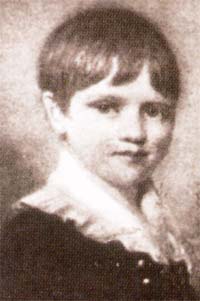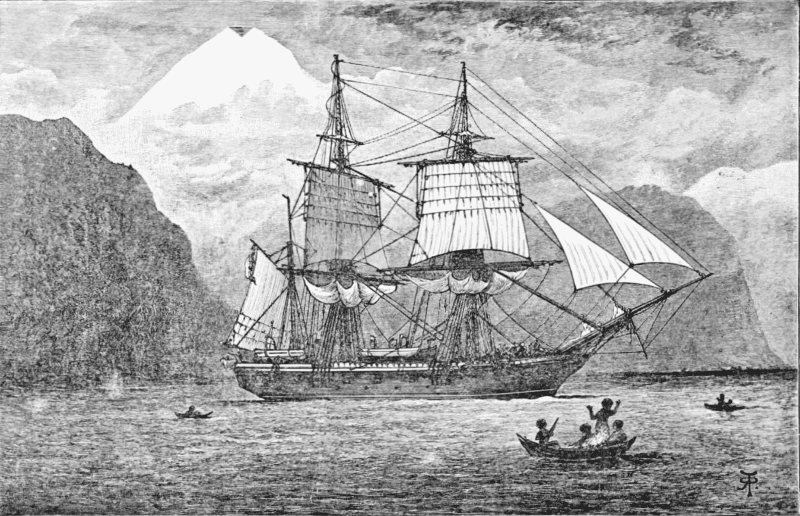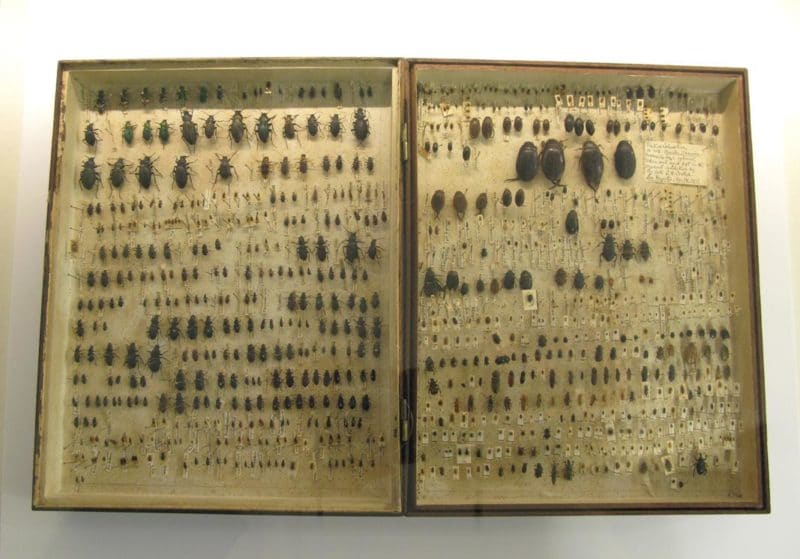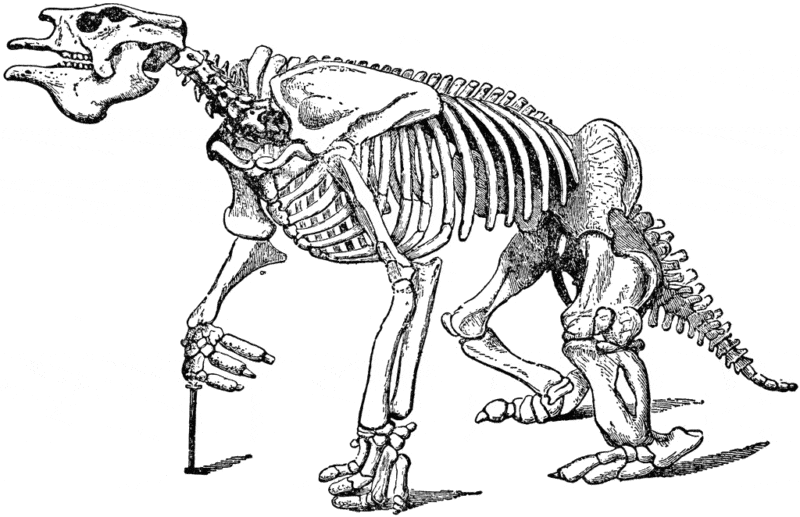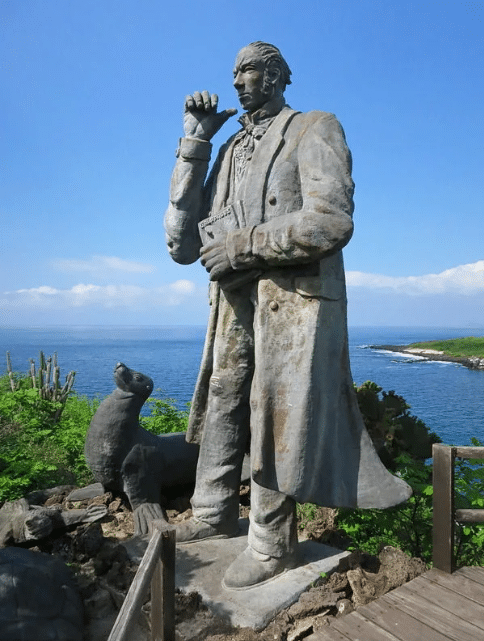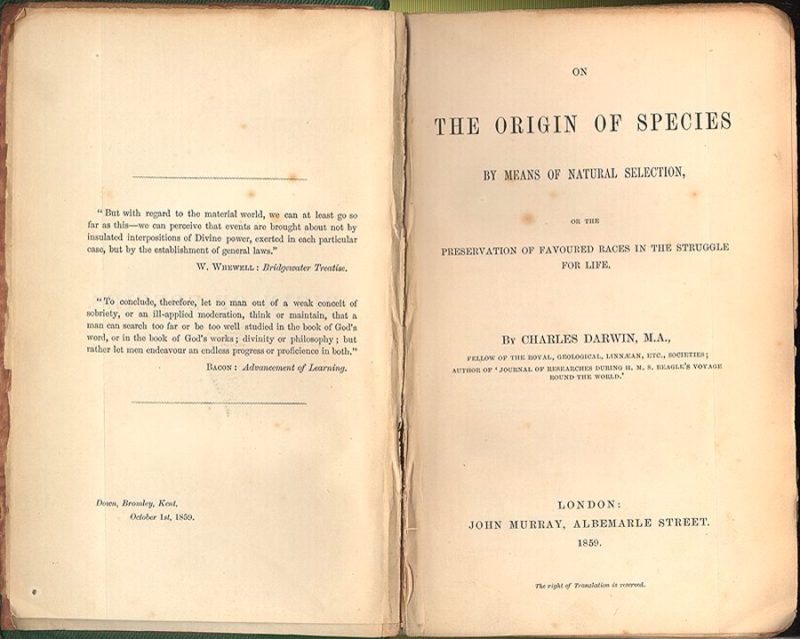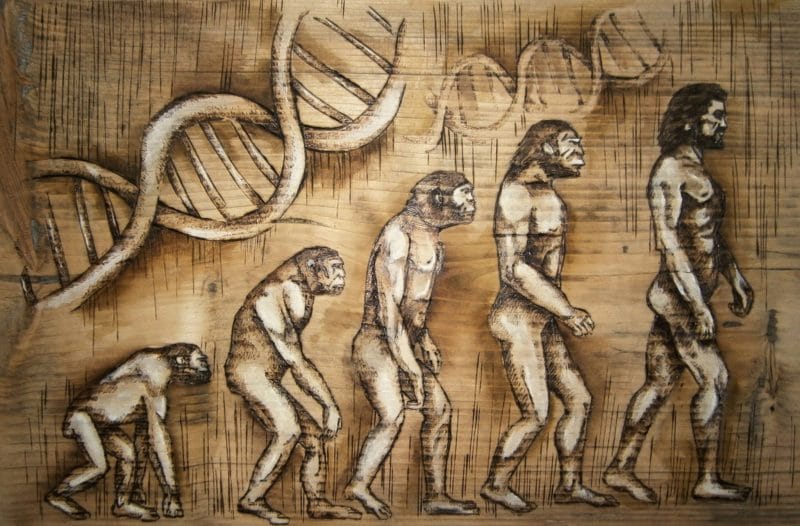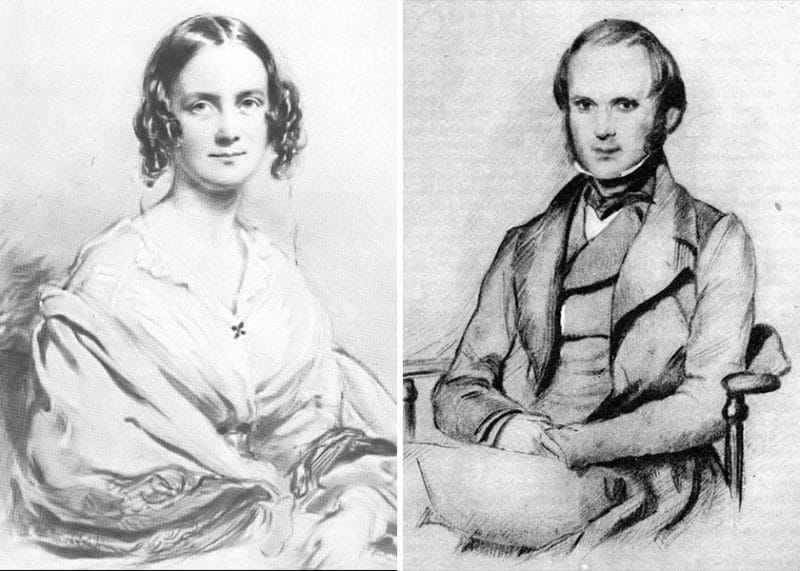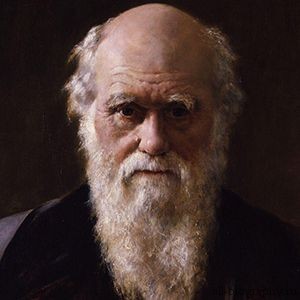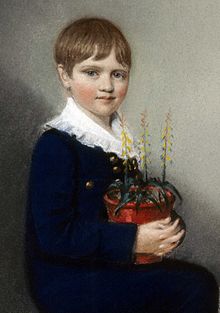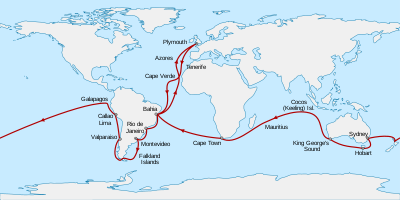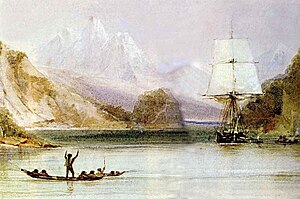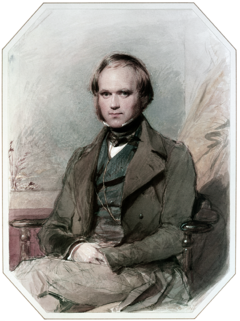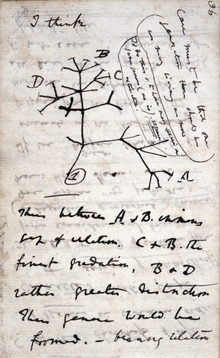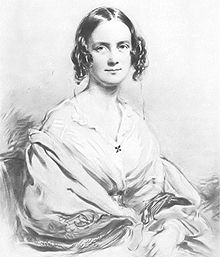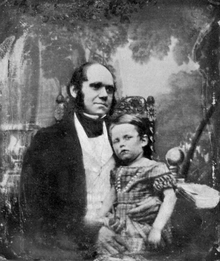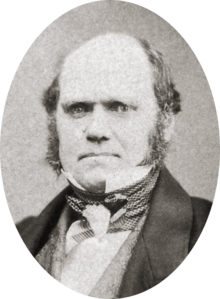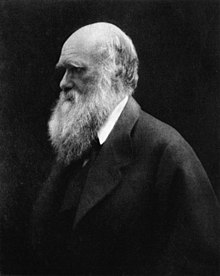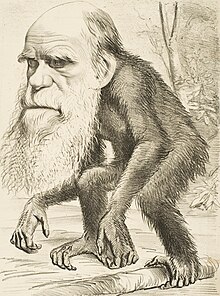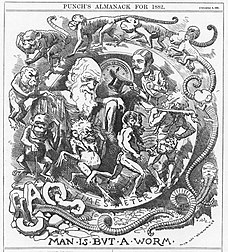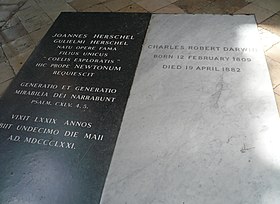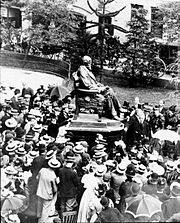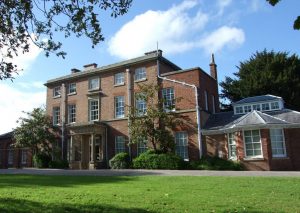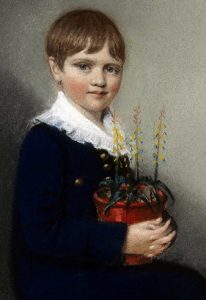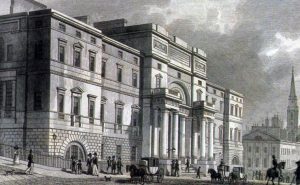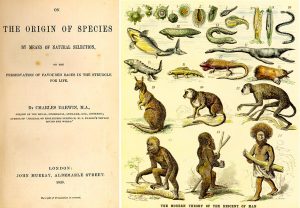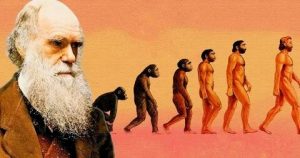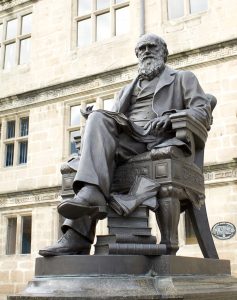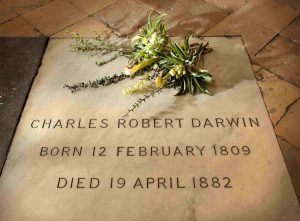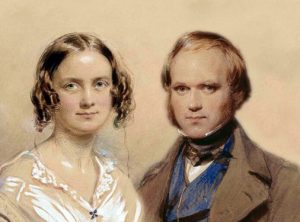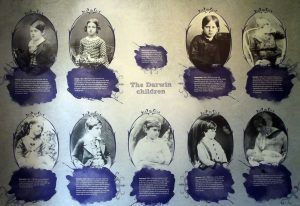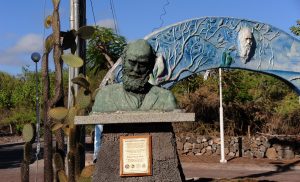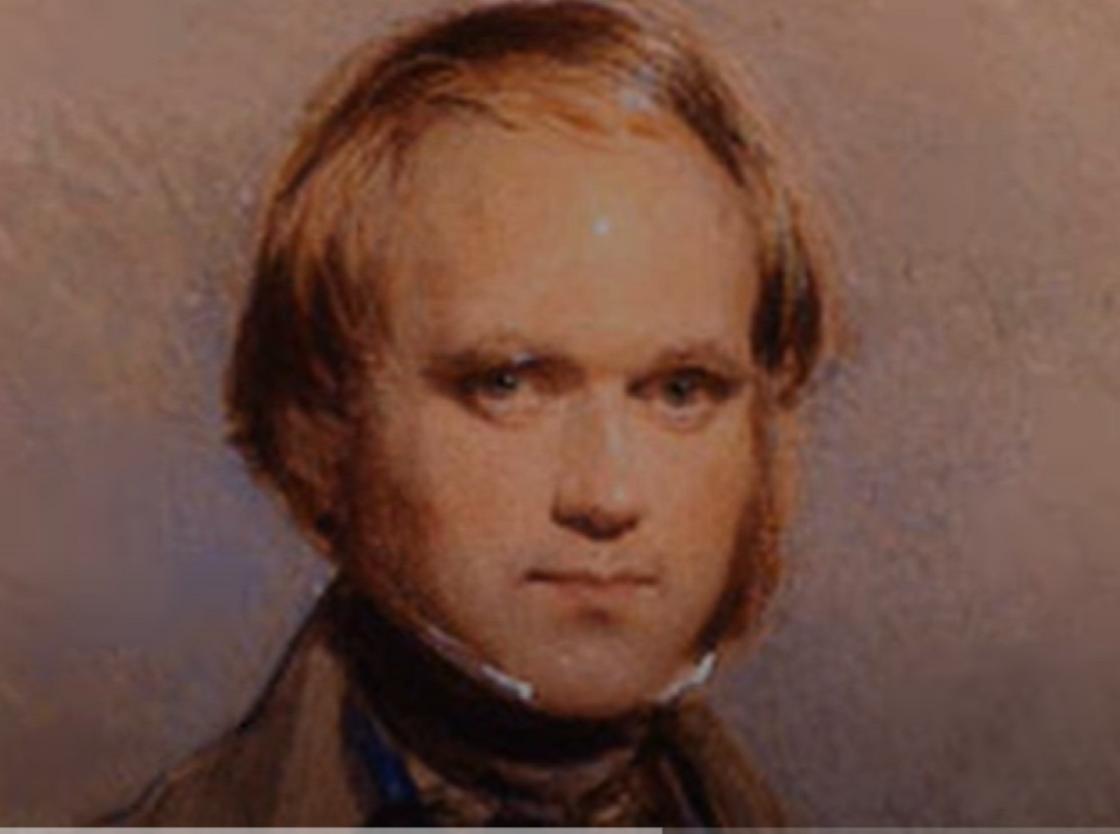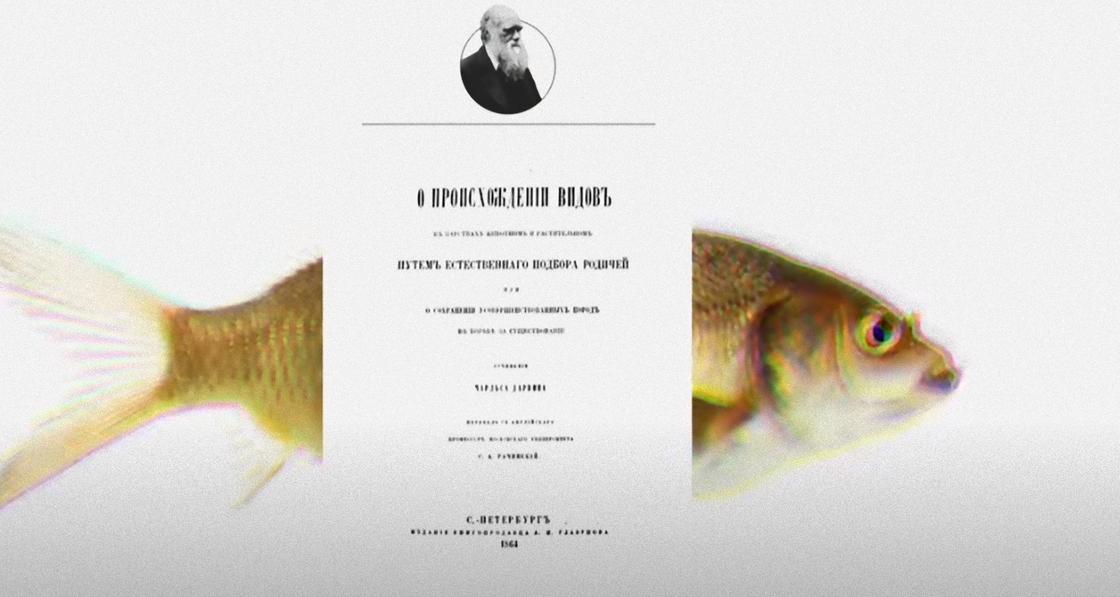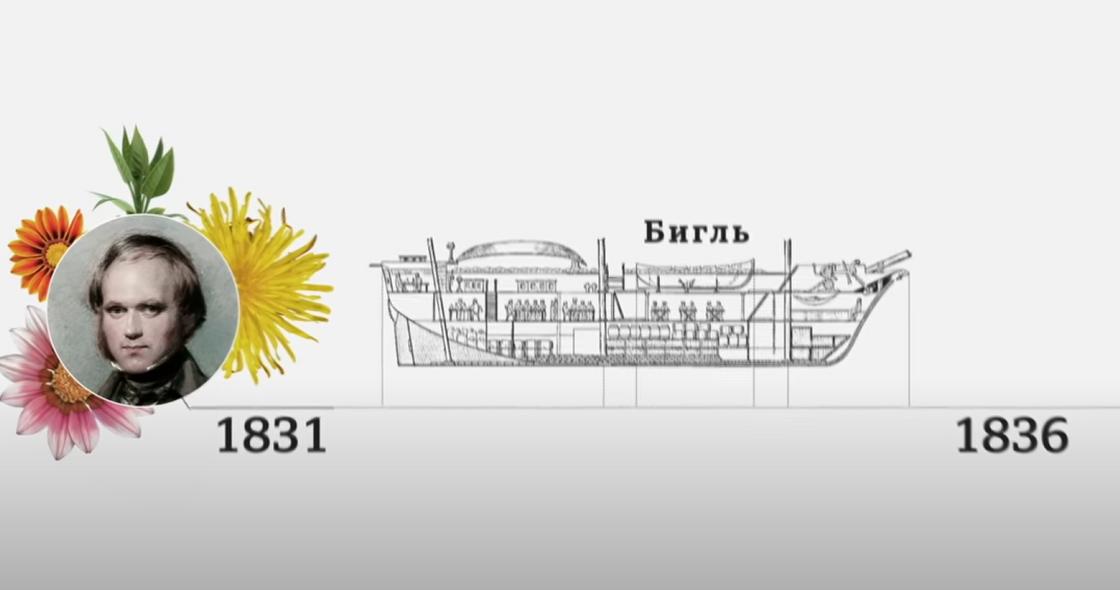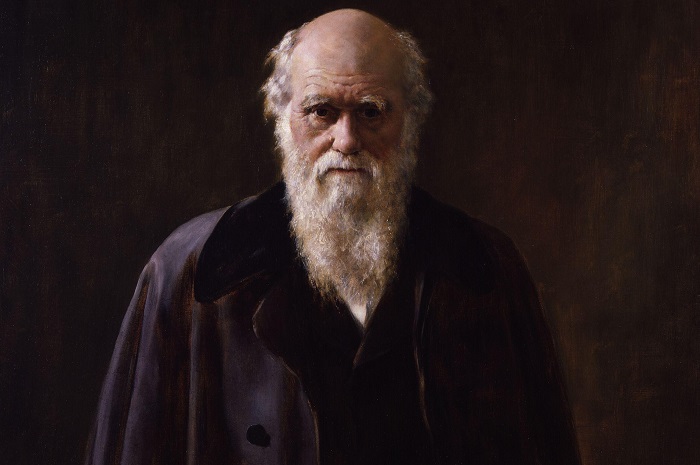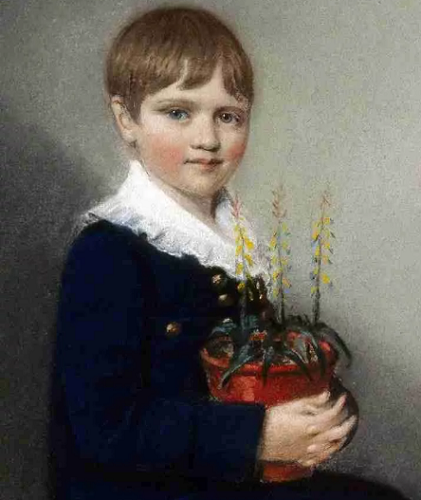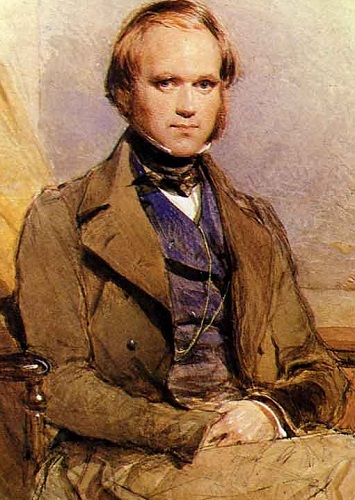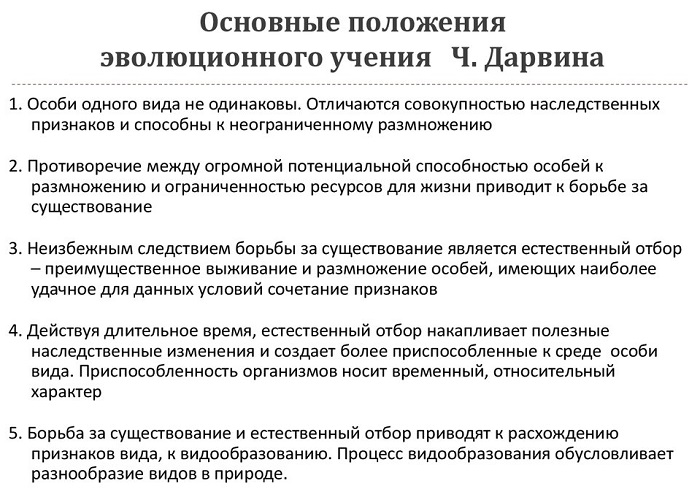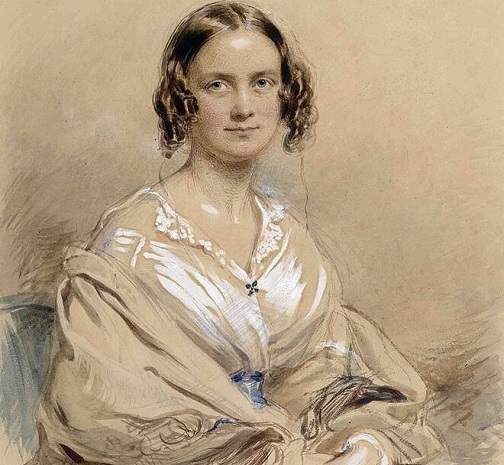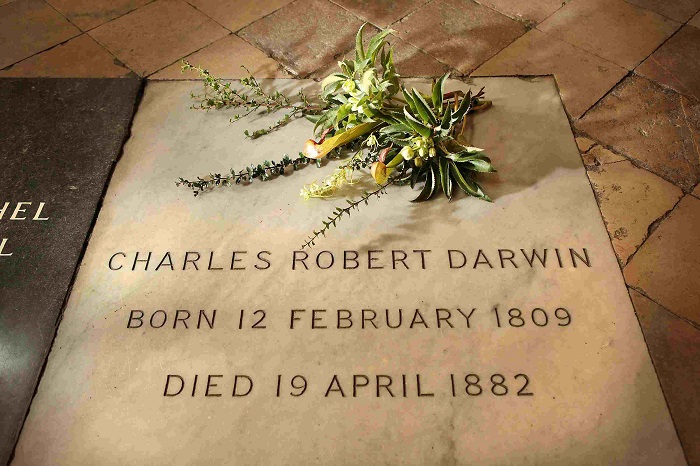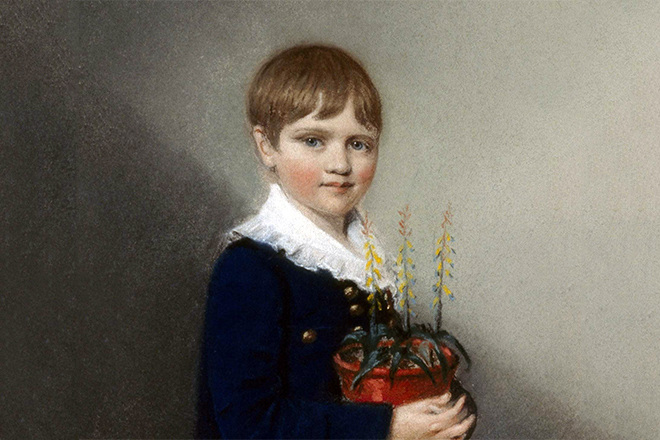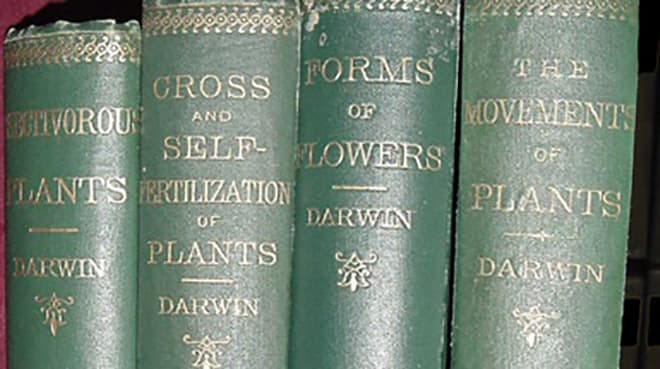Чарльз Дарвин — биография
Чарльз Роберт Дарвин – путешественник и натуралист, автор идеи об эволюционном развитии всех живых существ.
Чарльз Дарвин стал первым ученым, который выдвинул теорию эволюционного развития всех живых существ на планете. Если раньше было принято считать происхождение жизни на Земле божьим промыслом, то ученый сумел доказать, что это результат эволюции от общих пращуров. Дарвин придерживался теории естественного отбора, который и ставил во главе угла теории эволюции. Ему также принадлежит теория о половом отборе и закон наследственности, который в то время не имел подтверждений. Открытый Дарвином основной механизм эволюции был признан только в 50-е годы прошлого века и стал фундаментом в формировании современной теории.
Детство
Родился Чарльз Дарвин 12 февраля 1809 года в Шрусбери, расположенном в английском графстве Шропшир, в родовом имении Дарвинов. Отца мальчика звали Роберт Дарвин, он был доктором и финансистом, приходился сыном ученому натуралисту Эразму Дарвину. Мама – Сьюзанн Дарвин(Уэджвуд), была дочерью знаменитого художника Джоайзи Уэджвуда. Кроме Чарльза у родителей подрастало еще пятеро детишек. Семейство Дарвинов принадлежало к Унитарианской церкви, хотя Сьюзан до замужества посещала англиканскую церковь.
Чарльз пошел в школу в 1817 году, в возрасте восьми лет. Там его привлекло естествознание и коллекционирование. Летом того же года не стало его матери, поэтому в 1818 году Чарльз и его брат Эразм были отправлены отцом в «Школу Шрюсбери» — пансион, который работал при англиканской церкви.
Чарльз знаниями не блистал. Больше всего он не любил заниматься литературой и языками, зато преуспел в охоте и собирании разных коллекций.
После жалоб преподавателей на его низкую успеваемость, отец пытался читать мальчику нотации, но это ни к чему не привело. Поэтому его оставили в покое, решив, что из этого ученика ничего путного не получится. Спустя некоторое время мальчик серьезно увлекся химией, за что был наказан начальником гимназии. По окончании обучения аттестат Чарльза был одним из худших, однако это не помешало ему в 1825-м стать студентом Эдинбургского университета. Вместе с ним поступал и его брат Эраст, молодые люди выбрали медицинский факультет. Перед тем, как поступить, Чарльз успел поработать в качестве ассистента у отца, имеющего свою медицинскую практику.
Чарльзу понадобилось два года, чтобы понять, что его абсолютно не интересует медицина. Он перестал посещать лекции, и нашел себе новое увлечение. Молодого человека серьезно заинтересовал процесс изготовления чучел животных. Он нашел себе учителя в лице бывшего раба Джона Эдмонстоуна, который когда-то работал с естествоиспытателем Чарльзом Уитертоном, и путешествовал с ним по Амазонии.
Первыми объектами исследований Дарвина стали морские беспозвоночные. Свои работы в этом направлении он огласил во время работы Плиниевского студенческого общества в марте 1827-го. В это общество Чарльз вступил годом ранее. В это же время он впервые столкнулся с понятием материализма. Дарвин трудился в качестве ассистента у Роберта Гранта, изучал естественную историю на курсе Роберта Джемсона. Именно там он познакомился с геологией, увидел коллекции, которыми владел Эдинбургский университет.
Отец очень разозлился, когда узнал, что Чарльз так запустил учебу. В то же время он понимает, что доктора из его сына не получится, и начал настойчиво предлагать отпрыску поступать в колледж Христа при Кембриджском университете. После активного участия в Плиниевском обществе, Дарвин уже не очень верил в церковные догматы, но противоречить отцу не стал. В 1828-м он успешно сдал вступительные испытания и поступил в Кембридж.
Однако и тут учеба не очень увлекала нерадивого студента. Он больше интересовался верховой ездой и охотой. Потом Чарльза серьезно увлекла энтомология, и он познакомился с людьми, коллекционирующими насекомых.
Лучшим другом Дарвина стал профессор этого университета Джон Генслоу, который и познакомил студента с невероятным миром ботаники. Профессор представил Чарльза лучшим естествоиспытателям тех лет.
Выпускные экзамены неуклонно приближались, и Дарвин понял, что нужно нагонять все, что было упущено за эти годы. Он штудировал основные предметы, и в итоге показал десятый результат на выпускных экзаменах.
Путешествия
В 1831-м Дарвин окончил Кембридж, однако уезжать не торопился. Он заинтересовался работами Уильяма Пейли и Александра фон Гумбольдта, которые касались естественных наук. После прочтения этих книг, ученый всерьез задумался о поездке в тропики, чтобы приобрести практический опыт в естественных науках. Чтобы воплотить свою задумку в жизнь, Чарльз проучился на курсе геологии, который вел Адам Седжвик, а потом отправился в Северный Уэльс. Там он занимался картографированием пород.
Вернувшись обратно, Чарльз получил письмо от своего бывшего преподавателя – профессора Генслоу, в котором тот просил капитана корабля «Бигль» Роберта Фицроя взять на борт молодого ученого. Корабль принадлежал к Английскому Королевскому флоту и направлялся в Южную Америку. Чарльза Дарвина могли взять в качестве натуралиста, правда, за его счет. Отец сказал свое категорическое «нет», и только благодаря вмешательству его дяди Джозайи Веджвуда II, Чарльз получил возможность путешествовать. Молодой ученый смог совершить кругосветку.
Корабль отчалил в 1831-м, и вернулся в порт только спустя пять лет, 2 октября 1836-го. Экипаж судна занимался картографической съемкой побережий. В это время Чарльз на берегу собирал экспонаты, пополнившие коллекцию по геологии и естественной истории. Все свои наблюдения он подробно записывал, и если выпадала возможность, отправлял копии своих наблюдений в Кембридж. За годы, проведенные в путешествии, ученый обзавелся большой коллекцией представителей животного мира, которая в основном состояла из морских беспозвоночных. Кроме этого он занимался изучением геологического строения побережий, и это тоже подробно описывал.
На островах Зеленого мыса ученый впервые понял, как влияет временной промежуток на геологические изменения. Потом он не раз применял это открытие, когда писал труды по геологии.
Во время пребывания в Патагонии, Дарвин нашел древнее млекопитающее мегатерию. Рядом с его останками нашлись современные раковины моллюсков, и ученый сделал предположение, что этот вид исчез сравнительно недавно. Научные круги Англии очень заинтересовались этим открытием.
После того, как Чарльз изучил ступенчатую равнинную часть Патагонии, где можно было полюбоваться открытыми пластами Земли, он понял, что ученый Лайель очень ошибался, когда писал вою работу о постоянстве и исчезновении видов.
Во время посещения Чили ученый впервые увидел землетрясение, поднимающее кору Земли выше уровня моря. В Андах Дарвину попались морские беспозвоночные, и он пришел к выводу, что барьерные рифы и атоллы возникают после тектонических движений коры Земли.
Галапагосские острова удивили ученого разнообразием флоры и фауны, он заметил, что местные виды многих животных отличаются от своих материковых сородичей и даже от тех, что живут на соседних островах. Особое внимание Дарвин уделил галапагосским черепахам и птицам пересмешникам.
В Австралии Чарльз увидел необычных сумчатых животных и утконосов, которые абсолютно не походили на животных с других материков. Ученый решил, что существует еще один «создатель».
Вместе с командой Чарльз посетил Зеленый мыс, Кокосовые острова, остров Тенерифе, Аргентину, Бразилию, Огненную Землю, Уругвай. Собранная за годы путешествия информация стала основой для создания трудов «Дневник изысканий натуралиста» в 1839 году, «Зоология путешествия на корабле «Бигль» в 1840-м, «Строение и распределение коралловых рифов» в 1842 году. Дарвин стал автором описания необычного природного явления – пенитентеса, особых кристаллов льда, которые содержат ледники Анд.
Вернувшись из кругосветного вояжа, ученый начал собирать доказательства возникшей у него теории об эволюции видов. Он воспитывался на основе церковных догматов, и теперь прекрасно понимал, что его теория противоречит общепринятому порядку мироздания. Он верил в то, что Бог существует, но его разочарование в христианстве было полным.
Когда в 1851-м умерла его дочка Энн, ученый окончательно отошел от церкви. Он не прекратил ей помогать, по-прежнему поддерживал прихожан, но когда его семья уходила на службу в церковь, он предпочитал прогуливаться. Всем говорил, что он агностик.
В 1838-м Дарвин получил должность секретаря в «Лондонском геологическом обществе», и пробыл на этом посту до 1841-го.
Могут быть знакомы
Происхождение видов
В 1837-м ученый начал вести дневник, в котором классифицировал растения по сортам и домашних животных по породам. Там же записывал свои соображения, касающиеся естественного отбора. Свои первые публикации на эту тему ученый издал в 1842-м.
Он назвал свой труд «Происхождение видов», и там выложил аргументы, подтверждающие его эволюционную теорию. Суть заключалась в том, что популяции развиваются постепенно, благодаря естественному отбору. Впоследствии в научном мире его принципы начали называть «дарвинизмом».
В 1856-м Дарвин начал готовить к печати расширенный вариант своего труда. Спустя три года книгу удалось выпустить тиражом в 1250 штук. Она называлась «Происхождение видов путем естественного отбора, или сохранение благоприятствуемых пород в борьбе за жизнь». За два дня в продаже не осталось ни одного экземпляра издания. Еще при жизни ученого его труд перевели на русский, голландский, шведский, итальянский, польский, датский, испанский, венгерский и сербский языки. Книги Чарльза Дарвина и сейчас пользуются популярностью, поэтому их переиздают достаточно часто. Его теория не утратила актуальности и сейчас, ее воспринимают за основу современной эволюционной науки.
Не менее важным стал и другой труд ученого – «Происхождение человека и половой отбор», где Дарвин выдвигает теорию наличия общего предка человека и обезьяны. Чарльз представил результаты сравнительного анатомического анализа, а также эмбриологических данных, и вывел сходство между человеком и современной обезьяной.
Труд под названием «О выражении эмоций у человека и животных» Дарвин посвятил изучению человека, как части в эволюционной цепи. Он считает, что предком современного человека была низшая животная форма.
Личная жизнь
Дарвин серьезно относился не только к своим исследованиям, но и к вопросам, касающимся личной жизни.
Прежде чем решиться на такой серьезный шаг, он взял лист бумаги и на нем отметил все положительные и отрицательные стороны этого поступка.
После того, как положительные качества перевесили, он предложил руку и сердце своей кузине Эмме Вэджвуд. Она была дочерью того самого дядюшки, вмешательство которого помогло Чарльзу отправиться в кругосветное путешествие. Итак, 11 ноября 1838 года Эмма ответила ему согласием. В то время она уже отметила свой тридцатый день рождения, была очень образованной и благоразумной. Ей не раз поступали предложения о замужестве, но всех претендентов девушка отвергала. Она переписывалась с Чарльзом во время его кругосветки, была автором проповедей, которые читались в сельской школе, брала уроки музыки у самого Шопена.
Официальное бракосочетание состоялось 29 января 1839 года. Их венчал брат – Джон Веджвуд, церемония проходила в Англиканской церкви. После свадьбы супруги жили в Лондоне, в сентябре 1842-го переехали в Даун, что в графстве Кент.
Супруги стали родителями десяти детей, все они стали большими людьми. Френсис, Джордж и Гораций получили членство в Английском Королевском обществе.
Трое деток все же умерли. Сам ученый объяснял это тем, что они с Эммой были родственниками, и эти свои убеждения он изложил в одной из своих работ.
Смерть
Великого ученого не стало 19 апреля 1882 года. Он прожил долгую жизнь, умер в 73 года. Местом вечного упокоения Чарльза Дарвина стало Вестминстерское аббатство.
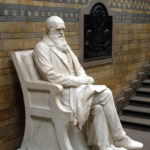
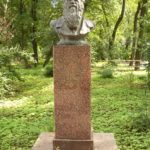
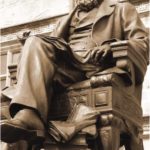
Овдовевшая Эмма переехала в Кембридж, где купила себе дом. Рядом с ней построили свои дома сыновья Гораций и Фрэнсис. В этом доме Эмма находилась только зимой, а летние месяцы проводила в семейном имении в Кенте. Ее не стало 7 октября 1896 года. Похоронили Эмму в Дауне, там, где покоится родной брат ее мужа – Эразм.
Ссылки
- Страница в Википедии
Для нас важна актуальность и достоверность информации. Если вы обнаружили ошибку или неточность, пожалуйста, сообщите нам. Выделите ошибку и нажмите сочетание клавиш Ctrl+Enter.
Биография Дарвина
12 Февраля 1809 – 19 Апреля 1882 гг. (73 года)
4.4
Средняя оценка: 4.4
Всего получено оценок: 1263.
Дарвин Чарльз Роберт (1809 – 1882) – английский ученый, натуралист, путешественник, автор одного из первых исследований о происхождении человека «Происхождение видов». Первым разрабатывал теорию об эволюции видов, а также естественном и половом отборе.
Детские годы
Чарльз Дарвин родился 12 февраля 1809 года в городе Шрусбери графства Шропшир в Великобритании в семье врача. Начальное образование будущий ученый получил в обычной школе. Уже в те годы своей краткой биографии Дарвин увлекался коллекционированием и естественной историей.
В 1818 году Чарльза отдают в Школу Шрюсбери. Классические языки и словесность давались мальчику очень плохо, при этом значительную часть времени он посвящал охоте, сбору коллекции минералов и бабочек, химии.
Образование
В 1825 году Дарвин поступает в Эдинбургский университет, где изучает сначала медицину, а затем таксидермию, естественную историю. В это время Чарльз участвовал в экспедиции в Южную Америку, ассистировал Р. Э. Гранту, посещал лекции Р. Джемсона.
В 1828 году Дарвин по настоянию отца поступил в колледж Христа Кембриджского университета для получения сана священника Англиканской церкви. В годы учебы Чарльз начал тесно общаться с профессором ботаники Д. С. Генслоу, увлекся трудами У. Пэйли, Гершеля, А. фон Гумбольта.
Кругосветное путешествие. Жизнь в Англии
В 1831 году Чарльз Дарвин, биография которого уже свидетельствовала о нем как о будущем биологе, при содействии друзей отправляется в кругосветное путешествие на судне капитана Р. Фицроя «Бигль». Во время экспедиции Чарльз собрал огромную коллекцию морских животных, вел заметки.
Вернувшись в 1836 году Лондон, Дарвин с 1838 года работал секретарем Лондонского геологического общества. В 1839 году была опубликована книга ученого, написанная по заметкам кругосветной экспедиции – «Путешествие натуралиста вокруг света на корабле «Бигль»». В 1842 году Дарвин переехал в графство Кент в город Даун. Здесь он прожил до конца дней, активно занимаясь научной деятельностью.
Умер Чарльз Дарвин 19 апреля 1882 года в городе Дауне. Похоронили великого ученого в Вестминстерском аббатстве.
Достижения в науке: главные труды ученого
В 1842 году биолог Дарвин написал первый очерк о происхождении видов. Более десяти лет ученый работал над своим фундаментальным трудом и только в 1858 году представил теорию научному обществу.
В 1859 году работа «Происхождение видов путём естественного отбора, или Сохранение благоприятствуемых пород в борьбе за жизнь» вышла отдельным изданием.
В 1868 году был опубликован второй значительный труд Дарвина – «Изменение животных и растений в домашнем состоянии». В 1871 году увидела свет работа ученого «Происхождение человека и половой отбор». В 1872 году вышел труд «Выражение эмоций у человека и животных».
Работы Дарвина на тему эволюции живых организмов оказали огромное влияние на историю человеческой мысли, ознаменовали начало новой эпохи в развитии биологии и других дисциплин.
Другие варианты биографии
Более сжатая для доклада или сообщения в классе
Вариант 2
Интересные факты
- Дедушка Дарвина, Эразм Дарвин, был известным английским врачом, натуралистом и поэтом.
- Во время кругосветного путешествия Дарвин побывал на островах Зеленого Мыса, в Уругвае, Аргентине, побережье Бразилии, на Тенерифе, в Тасмании и др.
- В 1839 году Чарльз Дарвин женился на Эмме Вэджвуд, за годы совместной жизни у них было десять детей.
- За значительный вклад в науку Дарвин был отмечен огромным количеством наград, среди которых – золотая медаль от Лондонского королевского общества (1864).
Тест по биографии
Чтобы лучше запомнить краткую биографию Дарвина – пройдите тест:
Доска почёта

Чтобы попасть сюда — пройдите тест.
-
Артем Хельберг
12/12
-
Светлана Шарипова
10/12
-
Костя Алексеев
12/12
-
Alex-Idm Klevcoff
11/12
-
Елена Милонова
11/12
-
Анастасия Галкина
12/12
-
Соня Сутягина
11/12
-
Светлана Шейко
10/12
-
Александра Миронова
9/12
-
Слава Ярый
12/12
Оценка по биографии
4.4
Средняя оценка: 4.4
Всего получено оценок: 1263.
А какая ваша оценка за эту биографию?
|
Charles Darwin FRS FRGS FLS FZS JP |
|
|---|---|
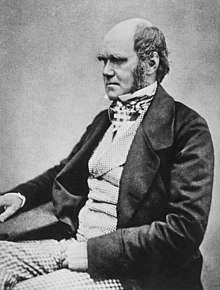
Darwin, c. 1854, when he was preparing On the Origin of Species for publication[1] |
|
| Born |
Charles Robert Darwin 12 February 1809 Shrewsbury, England |
| Died | 19 April 1882 (aged 73)
Down, Kent, England |
| Resting place | Westminster Abbey |
| Known for |
|
| Spouse |
Emma Wedgwood (m. 1839) |
| Children | 10 |
| Awards |
|
| Scientific career | |
| Fields | Natural history, geology |
| Institutions |
Tertiary education:
Professional institution:
|
| Academic advisors |
|
| Influences |
|
| Influenced |
|
| Author abbrev. (botany) | Darwin |
| Author abbrev. (zoology) | Darwin |
| Signature | |
 |
Charles Robert Darwin FRS FRGS FLS FZS JP[6] ([7] DAR-win; 12 February 1809 – 19 April 1882) was an English naturalist, geologist, and biologist,[8] widely known for his contributions to evolutionary biology. His proposition that all species of life have descended from a common ancestor is now generally accepted and considered a fundamental concept in science.[9] In a joint publication with Alfred Russel Wallace, he introduced his scientific theory that this branching pattern of evolution resulted from a process he called natural selection, in which the struggle for existence has a similar effect to the artificial selection involved in selective breeding.[10] Darwin has been described as one of the most influential figures in human history and was honoured by burial in Westminster Abbey.[11][12]
Darwin’s early interest in nature led him to neglect his medical education at the University of Edinburgh; instead, he helped to investigate marine invertebrates. His studies at the University of Cambridge’s Christ’s College from 1828 to 1831 encouraged his passion for natural science.[13] His five-year voyage on HMS Beagle from 1831 to 1836 established Darwin as an eminent geologist whose observations and theories supported Charles Lyell’s concept of gradual geological change. Publication of his journal of the voyage made Darwin famous as a popular author.[14]
Puzzled by the geographical distribution of wildlife and fossils he collected on the voyage, Darwin began detailed investigations and, in 1838, devised his theory of natural selection.[15] Although he discussed his ideas with several naturalists, he needed time for extensive research and his geological work had priority.[16] He was writing up his theory in 1858 when Alfred Russel Wallace sent him an essay that described the same idea, prompting immediate joint submission of both their theories to the Linnean Society of London.[17] Darwin’s work established evolutionary descent with modification as the dominant scientific explanation of diversification in nature.[18] In 1871, he examined human evolution and sexual selection in The Descent of Man, and Selection in Relation to Sex, followed by The Expression of the Emotions in Man and Animals (1872). His research on plants was published in a series of books, and in his final book, The Formation of Vegetable Mould, through the Actions of Worms (1881), he examined earthworms and their effect on soil.
Darwin published his theory of evolution with compelling evidence in his 1859 book On the Origin of Species.[19][20] By the 1870s, the scientific community and a majority of the educated public had accepted evolution as a fact. However, many favoured competing explanations that gave only a minor role to natural selection, and it was not until the emergence of the modern evolutionary synthesis from the 1930s to the 1950s that a broad consensus developed in which natural selection was the basic mechanism of evolution.[18][21] Darwin’s scientific discovery is the unifying theory of the life sciences, explaining the diversity of life.
Biography
Early life and education
Charles Robert Darwin was born in Shrewsbury, Shropshire, on 12 February 1809, at his family’s home, The Mount.[22][23] He was the fifth of six children of wealthy society doctor and financier Robert Darwin and Susannah Darwin (née Wedgwood). His grandfathers Erasmus Darwin and Josiah Wedgwood were both prominent abolitionists. Erasmus Darwin had praised general concepts of evolution and common descent in his Zoonomia (1794), a poetic fantasy of gradual creation including undeveloped ideas anticipating concepts his grandson expanded.[24]
A chalk drawing of the seven-year-old Darwin in 1816, with a potted plant, by Ellen Sharples
Both families were largely Unitarian, though the Wedgwoods were adopting Anglicanism. Robert Darwin, himself quietly a freethinker, had baby Charles baptised in November 1809 in the Anglican St Chad’s Church, Shrewsbury, but Charles and his siblings attended the Unitarian chapel with their mother. The eight-year-old Charles already had a taste for natural history and collecting when he joined the day school run by its preacher in 1817. That July, his mother died. From September 1818, he joined his older brother Erasmus in attending the nearby Anglican Shrewsbury School as a boarder.[25]
Darwin spent the summer of 1825 as an apprentice doctor, helping his father treat the poor of Shropshire, before going to the well regarded University of Edinburgh Medical School with his brother Erasmus in October 1825. Darwin found lectures dull and surgery distressing, so he neglected his studies.[26] He learned taxidermy in around 40 daily hour-long sessions from John Edmonstone, a freed black slave who had accompanied Charles Waterton in the South American rainforest.[27]
In Darwin’s second year at the university, he joined the Plinian Society, a student natural-history group featuring lively debates in which radical democratic students with materialistic views challenged orthodox religious concepts of science.[28] He assisted Robert Edmond Grant’s investigations of the anatomy and life cycle of marine invertebrates in the Firth of Forth, and on 27 March 1827 presented at the Plinian his own discovery that black spores found in oyster shells were the eggs of a skate leech. One day, Grant praised Lamarck’s evolutionary ideas. Darwin was astonished by Grant’s audacity, but had recently read similar ideas in his grandfather Erasmus’ journals.[29] Darwin was rather bored by Robert Jameson’s natural-history course, which covered geology—including the debate between Neptunism and Plutonism. He learned the classification of plants, and assisted with work on the collections of the University Museum, one of the largest museums in Europe at the time.[30]
Darwin’s neglect of medical studies annoyed his father, who shrewdly sent him to Christ’s College, Cambridge in January 1828, to study for a Bachelor of Arts degree as the first step towards becoming an Anglican country parson. Darwin was unqualified for Cambridge’s Tripos exams, and was required instead to join the ordinary degree course.[31] He preferred riding and shooting to studying.[32]
During the first few months of Darwin’s enrollment at Christ’s College, his second cousin William Darwin Fox was still studying there. Fox impressed him with his butterfly collection, introducing Darwin to entomology and influencing him to pursue beetle collecting.[34][35] He did this zealously, and had some of his finds published in James Francis Stephens’ Illustrations of British entomology (1829–32).[35][36]
Through Fox, Darwin became a close friend and follower of botany professor John Stevens Henslow.[34] He met other leading parson-naturalists who saw scientific work as religious natural theology, becoming known to these dons as «the man who walks with Henslow». When his own exams drew near, Darwin applied himself to his studies and was delighted by the language and logic of William Paley’s Evidences of Christianity (1795).[37] In his final examination in January 1831 Darwin did well, coming tenth out of 178 candidates for the ordinary degree.[38]
Darwin had to stay at Cambridge until June 1831. He studied Paley’s Natural Theology or Evidences of the Existence and Attributes of the Deity (first published in 1802), which made an argument for divine design in nature, explaining adaptation as God acting through laws of nature.[39] He read John Herschel’s new book, Preliminary Discourse on the Study of Natural Philosophy (1831), which described the highest aim of natural philosophy as understanding such laws through inductive reasoning based on observation, and Alexander von Humboldt’s Personal Narrative of scientific travels in 1799–1804. Inspired with «a burning zeal» to contribute, Darwin planned to visit Tenerife with some classmates after graduation to study natural history in the tropics. In preparation, he joined Adam Sedgwick’s geology course, then on 4 August travelled with him to spend a fortnight mapping strata in Wales.[40][41]
Survey voyage on HMS Beagle
The round-the-world voyage of the Beagle, 1831–1836
After leaving Sedgwick in Wales, Darwin spent a few days with student friends at Barmouth. He returned home on 29 August to find a letter from Henslow proposing him as a suitable (if unfinished) naturalist for a self-funded supernumerary place on HMS Beagle with captain Robert FitzRoy, a position for a gentleman rather than «a mere collector». The ship was to leave in four weeks on an expedition to chart the coastline of South America.[42][43] Robert Darwin objected to his son’s planned two-year voyage, regarding it as a waste of time, but was persuaded by his brother-in-law, Josiah Wedgwood II, to agree to (and fund) his son’s participation.[44] Darwin took care to remain in a private capacity to retain control over his collection, intending it for a major scientific institution.[45]
After delays, the voyage began on 27 December 1831; it lasted almost five years. As FitzRoy had intended, Darwin spent most of that time on land investigating geology and making natural history collections, while HMS Beagle surveyed and charted coasts.[18][46] He kept careful notes of his observations and theoretical speculations, and at intervals during the voyage his specimens were sent to Cambridge together with letters including a copy of his journal for his family.[47] He had some expertise in geology, beetle collecting and dissecting marine invertebrates, but in all other areas was a novice and ably collected specimens for expert appraisal.[48] Despite suffering badly from seasickness, Darwin wrote copious notes while on board the ship. Most of his zoology notes are about marine invertebrates, starting with plankton collected during a calm spell.[46][49]
On their first stop ashore at St Jago in Cape Verde, Darwin found that a white band high in the volcanic rock cliffs included seashells. FitzRoy had given him the first volume of Charles Lyell’s Principles of Geology, which set out uniformitarian concepts of land slowly rising or falling over immense periods,[II] and Darwin saw things Lyell’s way, theorising and thinking of writing a book on geology.[50] When they reached Brazil, Darwin was delighted by the tropical forest,[51] but detested the sight of slavery, and disputed this issue with Fitzroy.[52]
The survey continued to the south in Patagonia. They stopped at Bahía Blanca, and in cliffs near Punta Alta Darwin made a major find of fossil bones of huge extinct mammals beside modern seashells, indicating recent extinction with no signs of change in climate or catastrophe. He found bony plates like a giant version of the armour on local armadillos. From a jaw and tooth he identified the gigantic Megatherium, then from Cuvier’s description thought the armour was from this animal. The finds were shipped to England, and scientists found the fossils of great interest.[53][54] In Patagonia, Darwin came to wrongly believe the territory was devoid of reptiles.[55]
On rides with gauchos into the interior to explore geology and collect more fossils, Darwin gained social, political and anthropological insights into both native and colonial people at a time of revolution, and learnt that two types of rhea had separate but overlapping territories.[56][57] Further south, he saw stepped plains of shingle and seashells as raised beaches at a series of elevations. He read Lyell’s second volume and accepted its view of «centres of creation» of species, but his discoveries and theorising challenged Lyell’s ideas of smooth continuity and of extinction of species.[58][59]
Three Fuegians on board, who had been seized during the first Beagle voyage then given Christian education in England, were returning with a missionary. Darwin found them friendly and civilised, yet at Tierra del Fuego he met «miserable, degraded savages», as different as wild from domesticated animals.[60] He remained convinced that, despite this diversity, all humans were interrelated with a shared origin and potential for improvement towards civilisation. Unlike his scientist friends, he now thought there was no unbridgeable gap between humans and animals.[61] A year on, the mission had been abandoned. The Fuegian they had named Jemmy Button lived like the other natives, had a wife, and had no wish to return to England.[62]
As HMS Beagle surveyed the coasts of South America, Darwin theorised about geology and the extinction of giant mammals. Watercolour by the ship’s artist Conrad Martens, who replaced Augustus Earle, in Tierra del Fuego.
Darwin experienced an earthquake in Chile in 1835 and saw signs that the land had just been raised, including mussel-beds stranded above high tide. High in the Andes he saw seashells, and several fossil trees that had grown on a sand beach. He theorised that as the land rose, oceanic islands sank, and coral reefs round them grew to form atolls.[63][64]
On the geologically new Galápagos Islands, Darwin looked for evidence attaching wildlife to an older «centre of creation», and found mockingbirds allied to those in Chile but differing from island to island. He heard that slight variations in the shape of tortoise shells showed which island they came from, but failed to collect them, even after eating tortoises taken on board as food.[65][66] In Australia, the marsupial rat-kangaroo and the platypus seemed so unusual that Darwin thought it was almost as though two distinct Creators had been at work.[67] He found the Aborigines «good-humoured & pleasant», their numbers depleted by European settlement.[68]
FitzRoy investigated how the atolls of the Cocos (Keeling) Islands had formed, and the survey supported Darwin’s theorising.[64] FitzRoy began writing the official Narrative of the Beagle voyages, and after reading Darwin’s diary he proposed incorporating it into the account.[69] Darwin’s Journal was eventually rewritten as a separate third volume, on geology and natural history.[70][71]
In Cape Town, South Africa, Darwin and FitzRoy met John Herschel, who had recently written to Lyell praising his uniformitarianism as opening bold speculation on «that mystery of mysteries, the replacement of extinct species by others» as «a natural in contradistinction to a miraculous process».[72]
When organising his notes as the ship sailed home, Darwin wrote that, if his growing suspicions about the mockingbirds, the tortoises and the Falkland Islands fox were correct, «such facts undermine the stability of Species», then cautiously added «would» before «undermine».[73] He later wrote that such facts «seemed to me to throw some light on the origin of species».[74]
Without telling Darwin, extracts from his letters to Henslow had been read to scientific societies, printed as a pamphlet for private distribution among members of the Cambridge Philosophical Society, and reported in magazines,[75] including The Athenaeum.[76] Darwin first heard of this at Cape Town,[77] and at Ascension Island read of Sedgwick’s prediction that Darwin «will have a great name among the Naturalists of Europe».[78][79]
Inception of Darwin’s evolutionary theory
While still a young man, Darwin joined the scientific elite. Portrait by George Richmond.
On 2 October 1836 Beagle anchored at Falmouth, Cornwall. Darwin promptly made the long coach journey to Shrewsbury to visit his home and see relatives. He then hurried to Cambridge to see Henslow, who advised him on finding available naturalists to catalogue Darwin’s animal collections and to take on the botanical specimens. Darwin’s father organised investments, enabling his son to be a self-funded gentleman scientist, and an excited Darwin went round the London institutions being fêted and seeking experts to describe the collections. British zoologists at the time had a huge backlog of work, due to natural history collecting being encouraged throughout the British Empire, and there was a danger of specimens just being left in storage.[80]
Charles Lyell eagerly met Darwin for the first time on 29 October and soon introduced him to the up-and-coming anatomist Richard Owen, who had the facilities of the Royal College of Surgeons to work on the fossil bones collected by Darwin. Owen’s surprising results included other gigantic extinct ground sloths as well as the Megatherium Darwin had identified, a near complete skeleton of the unknown Scelidotherium and a hippopotamus-sized rodent-like skull named Toxodon resembling a giant capybara. The armour fragments were actually from Glyptodon, a huge armadillo-like creature, as Darwin had initially thought.[54][81] These extinct creatures were related to living species in South America.[82]
In mid-December, Darwin took lodgings in Cambridge to arrange expert classification of his collections, and prepare his own research for publication. Questions of how to combine his diary into the Narrative were resolved at the end of the month when FitzRoy accepted Broderip’s advice to make it a separate volume, and Darwin began work on his Journal and Remarks.[83][84]
Darwin’s first paper showed that the South American landmass was slowly rising, and with Lyell’s enthusiastic backing he read it to the Geological Society of London on 4 January 1837. On the same day, he presented his mammal and bird specimens to the Zoological Society. The ornithologist John Gould soon announced that the Galapagos birds that Darwin had thought a mixture of blackbirds, «gros-beaks» and finches, were, in fact, twelve separate species of finches. On 17 February, Darwin was elected to the Council of the Geological Society, and Lyell’s presidential address presented Owen’s findings on Darwin’s fossils, stressing geographical continuity of species as supporting his uniformitarian ideas.[85]
In mid-July 1837 Darwin started his «B» notebook on Transmutation of Species, and on page 36 wrote «I think» above his first evolutionary tree.
Early in March, Darwin moved to London to be near this work, joining Lyell’s social circle of scientists and experts such as Charles Babbage,[86] who described God as a programmer of laws. Darwin stayed with his freethinking brother Erasmus, part of this Whig circle and a close friend of the writer Harriet Martineau, who promoted the Malthusianism that underpinned the controversial Whig Poor Law reforms to stop welfare from causing overpopulation and more poverty. As a Unitarian, she welcomed the radical implications of transmutation of species, promoted by Grant and younger surgeons influenced by Geoffroy. Transmutation was anathema to Anglicans defending social order,[87] but reputable scientists openly discussed the subject and there was wide interest in John Herschel’s letter praising Lyell’s approach as a way to find a natural cause of the origin of new species.[72]
Gould met Darwin and told him that the Galápagos mockingbirds from different islands were separate species, not just varieties, and what Darwin had thought was a «wren» was in the finch group. Darwin had not labelled the finches by island, but from the notes of others on the ship, including FitzRoy, he allocated species to islands.[88] The two rheas were distinct species, and on 14 March Darwin announced how their distribution changed going southwards.[89]
By mid-March 1837, barely six months after his return to England, Darwin was speculating in his Red Notebook on the possibility that «one species does change into another» to explain the geographical distribution of living species such as the rheas, and extinct ones such as the strange extinct mammal Macrauchenia, which resembled a giant guanaco, a llama relative. Around mid-July, he recorded in his «B» notebook his thoughts on lifespan and variation across generations—explaining the variations he had observed in Galápagos tortoises, mockingbirds, and rheas. He sketched branching descent, and then a genealogical branching of a single evolutionary tree, in which «It is absurd to talk of one animal being higher than another», thereby discarding Lamarck’s idea of independent lineages progressing to higher forms.[90]
Overwork, illness, and marriage
While developing this intensive study of transmutation, Darwin became mired in more work. Still rewriting his Journal, he took on editing and publishing the expert reports on his collections, and with Henslow’s help obtained a Treasury grant of £1,000 to sponsor this multi-volume Zoology of the Voyage of H.M.S. Beagle, a sum equivalent to about £115,000 in 2021.[91] He stretched the funding to include his planned books on geology, and agreed to unrealistic dates with the publisher.[92] As the Victorian era began, Darwin pressed on with writing his Journal, and in August 1837 began correcting printer’s proofs.[93]
As Darwin worked under pressure, his health suffered. On 20 September he had «an uncomfortable palpitation of the heart», so his doctors urged him to «knock off all work» and live in the country for a few weeks. After visiting Shrewsbury he joined his Wedgwood relatives at Maer Hall, Staffordshire, but found them too eager for tales of his travels to give him much rest. His charming, intelligent, and cultured cousin Emma Wedgwood, nine months older than Darwin, was nursing his invalid aunt. His uncle Josiah pointed out an area of ground where cinders had disappeared under loam and suggested that this might have been the work of earthworms, inspiring «a new & important theory» on their role in soil formation, which Darwin presented at the Geological Society on 1 November 1837.[94] His Journal was printed and ready for publication by the end of February 1838, as was the first volume of the Narrative, but FitzRoy was still working hard to finish his own volume.[93]
William Whewell pushed Darwin to take on the duties of Secretary of the Geological Society. After initially declining the work, he accepted the post in March 1838.[95] Despite the grind of writing and editing the Beagle reports, Darwin made remarkable progress on transmutation, taking every opportunity to question expert naturalists and, unconventionally, people with practical experience in selective breeding such as farmers and pigeon fanciers.[18][96] Over time, his research drew on information from his relatives and children, the family butler, neighbours, colonists and former shipmates.[97] He included mankind in his speculations from the outset, and on seeing an orangutan in the zoo on 28 March 1838 noted its childlike behaviour.[98]
The strain took a toll, by June he was being laid up for days on end with stomach problems, headaches and heart symptoms. For the rest of his life, he was repeatedly incapacitated with episodes of stomach pains, vomiting, severe boils, palpitations, trembling and other symptoms, particularly during times of stress, such as attending meetings or making social visits. The cause of Darwin’s illness remained unknown, and attempts at treatment had only ephemeral success.[99]
On 23 June, he took a break and went «geologising» in Scotland. He visited Glen Roy in glorious weather to see the parallel «roads» cut into the hillsides at three heights. He later published his view that these were marine raised beaches, but then had to accept that they were shorelines of a proglacial lake.[100]
Fully recuperated, he returned to Shrewsbury in July. Used to jotting down daily notes on animal breeding, he scrawled rambling thoughts about marriage, career and prospects on two scraps of paper, one with columns headed «Marry» and «Not Marry». Advantages under «Marry» included «constant companion and a friend in old age … better than a dog anyhow», against points such as «less money for books» and «terrible loss of time».[101] Having decided in favour of marriage, he discussed it with his father, then went to visit his cousin Emma on 29 July. He did not get around to proposing, but against his father’s advice he mentioned his ideas on transmutation.[102]
Malthus and natural selection
Continuing his research in London, Darwin’s wide reading now included the sixth edition of Malthus’s An Essay on the Principle of Population. On 28 September 1838 he noted its assertion that human «population, when unchecked, goes on doubling itself every twenty five years, or increases in a geometrical ratio», a geometric progression so that population soon exceeds food supply in what is known as a Malthusian catastrophe. Darwin was well prepared to compare this to Augustin de Candolle’s «warring of the species» of plants and the struggle for existence among wildlife, explaining how numbers of a species kept roughly stable. As species always breed beyond available resources, favourable variations would make organisms better at surviving and passing the variations on to their offspring, while unfavourable variations would be lost. He wrote that the «final cause of all this wedging, must be to sort out proper structure, & adapt it to changes», so that «One may say there is a force like a hundred thousand wedges trying force into every kind of adapted structure into the gaps of in the economy of nature, or rather forming gaps by thrusting out weaker ones.»[18][103] This would result in the formation of new species.[18][104] As he later wrote in his Autobiography:
In October 1838, that is, fifteen months after I had begun my systematic enquiry, I happened to read for amusement Malthus on Population, and being well prepared to appreciate the struggle for existence which everywhere goes on from long-continued observation of the habits of animals and plants, it at once struck me that under these circumstances favourable variations would tend to be preserved, and unfavourable ones to be destroyed. The result of this would be the formation of new species. Here, then, I had at last got a theory by which to work…[105]
By mid-December, Darwin saw a similarity between farmers picking the best stock in selective breeding, and a Malthusian Nature selecting from chance variants so that «every part of newly acquired structure is fully practical and perfected»,[106] thinking this comparison «a beautiful part of my theory».[107] He later called his theory natural selection, an analogy with what he termed the «artificial selection» of selective breeding.[18]
On 11 November, he returned to Maer and proposed to Emma, once more telling her his ideas. She accepted, then in exchanges of loving letters she showed how she valued his openness in sharing their differences, while expressing her strong Unitarian beliefs and concerns that his honest doubts might separate them in the afterlife.[108] While he was house-hunting in London, bouts of illness continued and Emma wrote urging him to get some rest, almost prophetically remarking «So don’t be ill any more my dear Charley till I can be with you to nurse you.» He found what they called «Macaw Cottage» (because of its gaudy interiors) in Gower Street, then moved his «museum» in over Christmas. On 24 January 1839, Darwin was elected a Fellow of the Royal Society (FRS).[2][109]
On 29 January, Darwin and Emma Wedgwood were married at Maer in an Anglican ceremony arranged to suit the Unitarians, then immediately caught the train to London and their new home.[110]
Geology books, barnacles, evolutionary research
Darwin now had the framework of his theory of natural selection «by which to work»,[105] as his «prime hobby».[111] His research included extensive experimental selective breeding of plants and animals, finding evidence that species were not fixed and investigating many detailed ideas to refine and substantiate his theory.[18] For fifteen years this work was in the background to his main occupation of writing on geology and publishing expert reports on the Beagle collections, in particular, the barnacles.[112]
FitzRoy’s long delayed Narrative was published in May 1839. Darwin’s Journal and Remarks got good reviews as the third volume, and on 15 August it was published on its own. Early in 1842, Darwin wrote about his ideas to Charles Lyell, who noted that his ally «denies seeing a beginning to each crop of species».[71][113]
Darwin’s book The Structure and Distribution of Coral Reefs on his theory of atoll formation was published in May 1842 after more than three years of work, and he then wrote his first «pencil sketch» of his theory of natural selection.[114] To escape the pressures of London, the family moved to rural Down House in Kent in September.[115] On 11 January 1844, Darwin mentioned his theorising to the botanist Joseph Dalton Hooker, writing with melodramatic humour «it is like confessing a murder».[116][117] Hooker replied «There may in my opinion have been a series of productions on different spots, & also a gradual change of species. I shall be delighted to hear how you think that this change may have taken place, as no presently conceived opinions satisfy me on the subject.»[118]
By July, Darwin had expanded his «sketch» into a 230-page «Essay», to be expanded with his research results if he died prematurely.[120] In November, the anonymously published sensational best-seller Vestiges of the Natural History of Creation brought wide interest in transmutation. Darwin scorned its amateurish geology and zoology, but carefully reviewed his own arguments. Controversy erupted, and it continued to sell well despite contemptuous dismissal by scientists.[121][122]
Darwin completed his third geological book in 1846. He now renewed a fascination and expertise in marine invertebrates, dating back to his student days with Grant, by dissecting and classifying the barnacles he had collected on the voyage, enjoying observing beautiful structures and thinking about comparisons with allied structures.[123] In 1847, Hooker read the «Essay» and sent notes that provided Darwin with the calm critical feedback that he needed, but would not commit himself and questioned Darwin’s opposition to continuing acts of creation.[124]
In an attempt to improve his chronic ill health, Darwin went in 1849 to Dr. James Gully’s Malvern spa and was surprised to find some benefit from hydrotherapy.[125] Then, in 1851, his treasured daughter Annie fell ill, reawakening his fears that his illness might be hereditary, and after a long series of crises she died.[126]
In eight years of work on barnacles, Darwin’s theory helped him to find «homologies» showing that slightly changed body parts served different functions to meet new conditions, and in some genera he found minute males parasitic on hermaphrodites, showing an intermediate stage in evolution of distinct sexes.[127] In 1853, it earned him the Royal Society’s Royal Medal, and it made his reputation as a biologist.[128] In 1854 he became a Fellow of the Linnean Society of London, gaining postal access to its library.[129] He began a major reassessment of his theory of species, and in November realised that divergence in the character of descendants could be explained by them becoming adapted to «diversified places in the economy of nature».[130]
Publication of the theory of natural selection
Darwin aged 46 in 1855, by then working towards publication of his theory of natural selection. He wrote to Joseph Hooker about this portrait, «if I really have as bad an expression, as my photograph gives me, how I can have one single friend is surprising.»[131]
By the start of 1856, Darwin was investigating whether eggs and seeds could survive travel across seawater to spread species across oceans. Hooker increasingly doubted the traditional view that species were fixed, but their young friend Thomas Henry Huxley was still firmly against the transmutation of species. Lyell was intrigued by Darwin’s speculations without realising their extent. When he read a paper by Alfred Russel Wallace, «On the Law which has Regulated the Introduction of New Species», he saw similarities with Darwin’s thoughts and urged him to publish to establish precedence.[132]
Though Darwin saw no threat, on 14 May 1856 he began writing a short paper. Finding answers to difficult questions held him up repeatedly, and he expanded his plans to a «big book on species» titled Natural Selection, which was to include his «note on Man». He continued his researches, obtaining information and specimens from naturalists worldwide including Wallace who was working in Borneo.[132]
In mid-1857 he added a section heading; «Theory applied to Races of Man», but did not add text on this topic. On 5 September 1857, Darwin sent the American botanist Asa Gray a detailed outline of his ideas, including an abstract of Natural Selection, which omitted human origins and sexual selection. In December, Darwin received a letter from Wallace asking if the book would examine human origins. He responded that he would avoid that subject, «so surrounded with prejudices», while encouraging Wallace’s theorising and adding that «I go much further than you.»[132]
Darwin’s book was only partly written when, on 18 June 1858, he received a paper from Wallace describing natural selection. Shocked that he had been «forestalled», Darwin sent it on that day to Lyell, as requested by Wallace,[133][134] and although Wallace had not asked for publication, Darwin suggested he would send it to any journal that Wallace chose. His family was in crisis with children in the village dying of scarlet fever, and he put matters in the hands of his friends. After some discussion, with no reliable way of involving Wallace, Lyell and Hooker decided on a joint presentation at the Linnean Society on 1 July of On the Tendency of Species to form Varieties; and on the Perpetuation of Varieties and Species by Natural Means of Selection. On the evening of 28 June, Darwin’s baby son died of scarlet fever after almost a week of severe illness, and he was too distraught to attend.[135]
There was little immediate attention to this announcement of the theory; the president of the Linnean Society remarked in May 1859 that the year had not been marked by any revolutionary discoveries.[136] Only one review rankled enough for Darwin to recall it later; Professor Samuel Haughton of Dublin claimed that «all that was new in them was false, and what was true was old».[137] Darwin struggled for thirteen months to produce an abstract of his «big book», suffering from ill health but getting constant encouragement from his scientific friends. Lyell arranged to have it published by John Murray.[138]
On the Origin of Species proved unexpectedly popular, with the entire stock of 1,250 copies oversubscribed when it went on sale to booksellers on 22 November 1859.[139] In the book, Darwin set out «one long argument» of detailed observations, inferences and consideration of anticipated objections.[140] In making the case for common descent, he included evidence of homologies between humans and other mammals.[141][III] Having outlined sexual selection, he hinted that it could explain differences between human races.[142][IV] He avoided explicit discussion of human origins, but implied the significance of his work with the sentence; «Light will be thrown on the origin of man and his history.»[143][IV] His theory is simply stated in the introduction:
As many more individuals of each species are born than can possibly survive; and as, consequently, there is a frequently recurring struggle for existence, it follows that any being, if it vary however slightly in any manner profitable to itself, under the complex and sometimes varying conditions of life, will have a better chance of surviving, and thus be naturally selected. From the strong principle of inheritance, any selected variety will tend to propagate its new and modified form.[144]
At the end of the book he concluded that:
There is grandeur in this view of life, with its several powers, having been originally breathed into a few forms or into one; and that, whilst this planet has gone cycling on according to the fixed law of gravity, from so simple a beginning endless forms most beautiful and most wonderful have been, and are being, evolved.[145]
The last word was the only variant of «evolved» in the first five editions of the book. «Evolutionism» at that time was associated with other concepts, most commonly with embryological development. Darwin first used the word evolution in The Descent of Man in 1871, before adding it in 1872 to the 6th edition of The Origin of Species.[146]
Responses to publication
An 1871 caricature following publication of The Descent of Man was typical of many showing Darwin with an ape body, identifying him in popular culture as the leading author of evolutionary theory.[147]
The book aroused international interest, with less controversy than had greeted the popular and less scientific Vestiges of the Natural History of Creation.[148] Though Darwin’s illness kept him away from the public debates, he eagerly scrutinised the scientific response, commenting on press cuttings, reviews, articles, satires and caricatures, and corresponded on it with colleagues worldwide.[149] The book did not explicitly discuss human origins,[143][IV] but included a number of hints about the animal ancestry of humans from which the inference could be made.[150]
The first review asked, «If a monkey has become a man–what may not a man become?» It said this should be left to theologians as being too dangerous for ordinary readers.[151] Amongst early favourable responses, Huxley’s reviews swiped at Richard Owen, leader of the scientific establishment which Huxley was trying to overthrow.[152]
In April, Owen’s review attacked Darwin’s friends and condescendingly dismissed his ideas, angering Darwin,[153] but Owen and others began to promote ideas of supernaturally guided evolution. Patrick Matthew drew attention to his 1831 book which had a brief appendix suggesting a concept of natural selection leading to new species, but he had not developed the idea.[154]
The Church of England’s response was mixed. Darwin’s old Cambridge tutors Sedgwick and Henslow dismissed the ideas, but liberal clergymen interpreted natural selection as an instrument of God’s design, with the cleric Charles Kingsley seeing it as «just as noble a conception of Deity».[155] In 1860, the publication of Essays and Reviews by seven liberal Anglican theologians diverted clerical attention from Darwin. Its ideas, including higher criticism, were attacked by church authorities as heresy. In it, Baden Powell argued that miracles broke God’s laws, so belief in them was atheistic, and praised «Mr Darwin’s masterly volume [supporting] the grand principle of the self-evolving powers of nature».[156]
Asa Gray discussed teleology with Darwin, who imported and distributed Gray’s pamphlet on theistic evolution, Natural Selection is not inconsistent with natural theology.[155][157] The most famous confrontation was at the public 1860 Oxford evolution debate during a meeting of the British Association for the Advancement of Science, where the Bishop of Oxford Samuel Wilberforce, though not opposed to transmutation of species, argued against Darwin’s explanation and human descent from apes. Joseph Hooker argued strongly for Darwin, and Thomas Huxley’s legendary retort, that he would rather be descended from an ape than a man who misused his gifts, came to symbolise a triumph of science over religion.[155][158]
Even Darwin’s close friends Gray, Hooker, Huxley and Lyell still expressed various reservations but gave strong support, as did many others, particularly younger naturalists. Gray and Lyell sought reconciliation with faith, while Huxley portrayed a polarisation between religion and science. He campaigned pugnaciously against the authority of the clergy in education,[155] aiming to overturn the dominance of clergymen and aristocratic amateurs under Owen in favour of a new generation of professional scientists. Owen’s claim that brain anatomy proved humans to be a separate biological order from apes was shown to be false by Huxley in a long running dispute parodied by Kingsley as the «Great Hippocampus Question», and discredited Owen.[159]
In response to objections that the origin of life was unexplained, Darwin pointed to acceptance of Newton’s law even though the cause of gravity was unknown.[160]
Darwinism became a movement covering a wide range of evolutionary ideas. In 1863 Lyell’s Geological Evidences of the Antiquity of Man popularised prehistory, though his caution on evolution disappointed Darwin. Weeks later Huxley’s Evidence as to Man’s Place in Nature showed that anatomically, humans are apes, then The Naturalist on the River Amazons by Henry Walter Bates provided empirical evidence of natural selection.[161] Lobbying brought Darwin Britain’s highest scientific honour, the Royal Society’s Copley Medal, awarded on 3 November 1864.[162] That day, Huxley held the first meeting of what became the influential «X Club» devoted to «science, pure and free, untrammelled by religious dogmas».[163] By the end of the decade most scientists agreed that evolution occurred, but only a minority supported Darwin’s view that the chief mechanism was natural selection.[164]
The Origin of Species was translated into many languages, becoming a staple scientific text attracting thoughtful attention from all walks of life, including the «working men» who flocked to Huxley’s lectures.[165] Darwin’s theory resonated with various movements at the time[V] and became a key fixture of popular culture.[VI] Cartoonists parodied animal ancestry in an old tradition of showing humans with animal traits, and in Britain these droll images served to popularise Darwin’s theory in an unthreatening way. While ill in 1862 Darwin began growing a beard, and when he reappeared in public in 1866 caricatures of him as an ape helped to identify all forms of evolutionism with Darwinism.[147]
Descent of Man, sexual selection, and botany
By 1878, an increasingly famous Darwin had suffered years of illness.
Despite repeated bouts of illness during the last twenty-two years of his life, Darwin’s work continued. Having published On the Origin of Species as an abstract of his theory, he pressed on with experiments, research, and writing of his «big book». He covered human descent from earlier animals including evolution of society and of mental abilities, as well as explaining decorative beauty in wildlife and diversifying into innovative plant studies.
Enquiries about insect pollination led in 1861 to novel studies of wild orchids, showing adaptation of their flowers to attract specific moths to each species and ensure cross fertilisation. In 1862 Fertilisation of Orchids gave his first detailed demonstration of the power of natural selection to explain complex ecological relationships, making testable predictions. As his health declined, he lay on his sickbed in a room filled with inventive experiments to trace the movements of climbing plants.[166] Admiring visitors included Ernst Haeckel, a zealous proponent of Darwinismus incorporating Lamarckism and Goethe’s idealism.[167] Wallace remained supportive, though he increasingly turned to Spiritualism.[168]
Darwin’s book The Variation of Animals and Plants Under Domestication (1868) was the first part of his planned «big book», and included his unsuccessful hypothesis of pangenesis attempting to explain heredity. It sold briskly at first, despite its size, and was translated into many languages. He wrote most of a second part, on natural selection, but it remained unpublished in his lifetime.[169]
Lyell had already popularised human prehistory, and Huxley had shown that anatomically humans are apes.[161] With The Descent of Man, and Selection in Relation to Sex published in 1871, Darwin set out evidence from numerous sources that humans are animals, showing continuity of physical and mental attributes, and presented sexual selection to explain impractical animal features such as the peacock’s plumage as well as human evolution of culture, differences between sexes, and physical and cultural racial classification, while emphasising that humans are all one species.[170]
Punch‘s almanac for 1882, published shortly before Darwin’s death, depicts him amidst evolution from chaos to Victorian gentleman with the title Man Is But A Worm.
His research using images was expanded in his 1872 book The Expression of the Emotions in Man and Animals, one of the first books to feature printed photographs, which discussed the evolution of human psychology and its continuity with the behaviour of animals. Both books proved very popular, and Darwin was impressed by the general assent with which his views had been received, remarking that «everybody is talking about it without being shocked.»[171] His conclusion was «that man with all his noble qualities, with sympathy which feels for the most debased, with benevolence which extends not only to other men but to the humblest living creature, with his god-like intellect which has penetrated into the movements and constitution of the solar system—with all these exalted powers—Man still bears in his bodily frame the indelible stamp of his lowly origin.»[172]
His evolution-related experiments and investigations led to books on Insectivorous Plants, The Effects of Cross and Self Fertilisation in the Vegetable Kingdom, different forms of flowers on plants of the same species, and The Power of Movement in Plants. He continued to collect information and exchange views from scientific correspondents all over the world, including Mary Treat, whom he encouraged to persevere in her scientific work.[173] He was the first person to recognize the significance of carnivory in plants.[174] His botanical work[IX] was interpreted and popularised by various writers including Grant Allen and H. G. Wells, and helped transform plant science in the late 19th century and early 20th century.[175][176]
Death and funeral
In 1882 he was diagnosed with what was called «angina pectoris» which then meant coronary thrombosis and disease of the heart. At the time of his death, the physicians diagnosed «anginal attacks», and «heart-failure»; there has since been scholarly speculation about his life-long health issues.[177][178]
He died at Down House on 19 April 1882. His last words were to his family, telling Emma «I am not the least afraid of death—Remember what a good wife you have been to me—Tell all my children to remember how good they have been to me». While she rested, he repeatedly told Henrietta and Francis «It’s almost worth while to be sick to be nursed by you».[179]
He had expected to be buried in St Mary’s churchyard at Downe, but at the request of Darwin’s colleagues, after public and parliamentary petitioning, William Spottiswoode (President of the Royal Society) arranged for Darwin to be honoured by burial in Westminster Abbey, close to John Herschel and Isaac Newton. The funeral, held on Wednesday 26 April, was attended by thousands of people, including family, friends, scientists, philosophers and dignitaries.[180][12]
Legacy
In 1881, Darwin was an eminent figure, still working on his contributions to evolutionary thought that had an enormous effect on many fields of science. His portrait by John Collier was commissioned for the Linnean Society of London.
As Alfred Russel Wallace put it, Darwin had «wrought a greater revolution in human thought within a quarter of a century than any man of our time – or perhaps any time», having «given us a new conception of the world of life, and a theory which is itself a powerful instrument of research; has shown us how to combine into one consistent whole the facts accumulated by all the separate classes of workers, and has thereby revolutionised the whole study of nature».[181]
Most scientists were now convinced of evolution as descent with modification, though few agreed with Darwin that natural selection «has been the main but not the exclusive means of modification».[182]
During «the eclipse of Darwinism» scientists explored alternative mechanisms. Then Ronald Fisher incorporated Mendelian genetics in The Genetical Theory of Natural Selection,[183] leading to population genetics and the modern evolutionary synthesis, which continues to develop.[21] Scientific discoveries have confirmed and validated Darwin’s key insights.[181]
Commemoration
Geographical features given his name include Darwin Sound[184] and Mount Darwin,[185] both named while he was on the Beagle voyage, and Darwin Harbour, named by his former shipmates on its next voyage, which eventually became the location of Darwin, the capital city of Australia’s Northern Territory.[186]
Darwin’s name was given, formally or informally, to numerous plants and animals, including many he had collected on the voyage.[187][188] Some names were given later, for example, tanagers found in the Galápagos Islands became popularly known as «Darwin’s finches» in 1947.[189]
In 1883 Sir Joseph Boehm sculpted a white marble life-size seated statue of Darwin. It was installed at the top of the main staircase in the Central Hall of the Natural History Museum in London, and unveiled on 9 June 1885 by Thomas Huxley in the presence of Edward, Prince of Wales, Bartholomew Sulivan, and Joseph Parslow at the ceremony.[190][191] In 1927 its place was taken by an elephant, and in 1970 it was moved to the North Hall of the museum, then in May 2008 the statue was moved back to its original place, displacing a statue of the Museum’s founder Richard Owen.[191][192]
Darwin’s children, now eminent, preserved his memory. In 1887 Francis Darwin published Life and Letters with his own reminiscences of his father, an autobiography Darwin had written for his family (edited to spare the sensitivities of Darwin’s widow Emma), and correspondence. More volumes of correspondence followed.[193]
Unveiling in 1897 of the Darwin Statue at the former Shrewsbury School building where he had studied
The Shrewsbury School building, which Darwin attended as a boy, became the Free Library. A seated statue of Darwin was installed outside it, and unveiled in 1897.[191]
The Linnean Society of London began awards of the Darwin–Wallace Medal in 1908, to mark fifty years from the joint reading on 1 July 1858 of papers by Darwin and Wallace publishing their theory. Further awards were made in 1958 and 2008, since 2010 the medal awards have been annual.[194]
In June 1909, more than 400 officials and scientists from across the world met in Cambridge to commemorate Darwin’s centenary and the fiftieth anniversary of On the Origin of Species, with exhibitions and events.[195][196]
The Darwin Centennial Celebration in 1959, on the centenary of On the Origin of Species and 150 years from Darwin’s birth, had major commemorations at the University of Chicago. It featured the evolutionary synthesis, and claims to Darwin’s legacy by biologists with differing views. It was marked by Gavin de Beer beginning publication of Darwin’s manuscripts including his private notebooks, and a new generation of science historians began investigating the Darwin papers archived at Cambridge, starting the «Darwin Industry».[197]
Darwin College, a postgraduate college at Cambridge University founded in 1964, is named after the Darwin family.[198] From 2000 to 2017, UK £10 banknotes issued by the Bank of England featured Darwin’s portrait printed on the reverse,[199][200] along with a hummingbird and HMS Beagle.[201]
In 2009 worldwide events, programmes and publications celebrated the bicentenary of Darwin’s birth and the 150th anniversary of the publication of On the Origin of Species.[202][203] Marking his bicentenary, a statue of Darwin as a young man was placed in a courtyard of his alma mater, Christ’s College, Cambridge.[33] Darwin Day became an annual celebration. Darwin was further commemorated on a series of UK postage stamps issued by the Royal Mail in 2009 with six «jigsaw» shaped stamps symbolising how his studies of different disciplines formed his new ideas on evolution.[204]
Beagle: In Darwin’s wake was a Dutch-Flemish television series from 2009 and 2010 initiated by the VPRO in collaboration with Teleac and Canvas to commemorate the 150th anniversary of Darwin’s On the Origin of Species. The series features an 8-month voyage around the world (commenced on 1 September 2009) on board the clipper Stad Amsterdam, which follows the route of the five-year-long voyage of Darwin between 1831 and 1836. Biologist Sarah Darwin (the great-great-granddaughter of Charles Darwin) is one of the recurring shipmates who appear in the series.[205]
Children
| William Erasmus Darwin | 27 Dec 1839 – | 8 Sept 1914 |
| Anne Elizabeth Darwin | 2 Mar 1841 – | 23 Apr 1851 |
| Mary Eleanor Darwin | 23 Sept 1842– | 16 Oct 1842 |
| Henrietta Emma Darwin | 25 Sept 1843 – | 17 Dec 1927 |
| George Howard Darwin | 9 Jul 1845 – | 7 Dec 1912 |
| Elizabeth Darwin | 8 Jul 1847 – | 8 Jun 1926 |
| Francis Darwin | 16 Aug 1848 – | 19 Sept 1925 |
| Leonard Darwin | 15 Jan 1850 – | 26 Mar 1943 |
| Horace Darwin | 13 May 1851 – | 29 Sept 1928 |
| Charles Waring Darwin | 6 Dec 1856 – | 28 Jun 1858 |
The Darwins had ten children: two died in infancy, and Annie’s death at the age of ten had a devastating effect on her parents. Charles was a devoted father and uncommonly attentive to his children.[13] Whenever they fell ill, he feared that they might have inherited weaknesses from inbreeding due to the close family ties he shared with his wife and cousin, Emma Wedgwood. He examined inbreeding in his writings, contrasting it with the advantages of outcrossing in many species.[206]
Emma Darwin with Charles Waring Darwin
Charles Waring Darwin, born in December 1856, was the tenth and last of the children. Emma Darwin was aged 48 at the time of the birth, and the child was mentally subnormal and never learnt to walk or talk. He probably had Down syndrome, which had not then been medically described. The evidence is a photograph by William Erasmus Darwin of the infant and his mother, showing a characteristic head shape, and the family’s observations of the child.[207] Charles Waring died of scarlet fever on 28 June 1858,[208] when Darwin wrote in his journal «Poor dear Baby died.»[209]
Of his surviving children, George, Francis and Horace became Fellows of the Royal Society,[210] distinguished as astronomer,[211] botanist and civil engineer, respectively. All three were knighted.[212] Another son, Leonard, went on to be a soldier, politician, economist, eugenicist and mentor of the statistician and evolutionary biologist Ronald Fisher.[213]
Views and opinions
Religious views
Darwin’s family tradition was nonconformist Unitarianism, while his father and grandfather were freethinkers, and his baptism and boarding school were Church of England.[25] When going to Cambridge to become an Anglican clergyman, he did not «in the least doubt the strict and literal truth of every word in the Bible».[37] He learned John Herschel’s science which, like William Paley’s natural theology, sought explanations in laws of nature rather than miracles and saw adaptation of species as evidence of design.[39][40] On board HMS Beagle, Darwin was quite orthodox and would quote the Bible as an authority on morality.[214] He looked for «centres of creation» to explain distribution,[65] and suggested that the very similar antlions found in Australia and England were evidence of a divine hand.[67]
In 1851 Darwin was devastated when his daughter Annie died. By then his faith in Christianity had dwindled, and he had stopped going to church.[215]
By his return, he was critical of the Bible as history, and wondered why all religions should not be equally valid.[214] In the next few years, while intensively speculating on geology and the transmutation of species, he gave much thought to religion and openly discussed this with his wife Emma, whose beliefs similarly came from intensive study and questioning.[108]
The theodicy of Paley and Thomas Malthus vindicated evils such as starvation as a result of a benevolent creator’s laws, which had an overall good effect. To Darwin, natural selection produced the good of adaptation but removed the need for design,[216] and he could not see the work of an omnipotent deity in all the pain and suffering, such as the ichneumon wasp paralysing caterpillars as live food for its eggs.[157] Though he thought of religion as a tribal survival strategy, Darwin was reluctant to give up the idea of God as an ultimate lawgiver. He was increasingly troubled by the problem of evil.[217][218]
Darwin remained close friends with the vicar of Downe, John Brodie Innes, and continued to play a leading part in the parish work of the church,[219] but from around 1849 would go for a walk on Sundays while his family attended church.[215] He considered it «absurd to doubt that a man might be an ardent theist and an evolutionist»[220][221] and, though reticent about his religious views, in 1879 he wrote that «I have never been an atheist in the sense of denying the existence of a God. – I think that generally … an agnostic would be the most correct description of my state of mind».[108][220]
The «Lady Hope Story», published in 1915, claimed that Darwin had reverted to Christianity on his sickbed. The claims were repudiated by Darwin’s children and have been dismissed as false by historians.[222]
Human society
Darwin’s views on social and political issues reflected his time and social position. He grew up in a family of Whig reformers who, like his uncle Josiah Wedgwood, supported electoral reform and the emancipation of slaves. Darwin was passionately opposed to slavery, while seeing no problem with the working conditions of English factory workers or servants.[223]
Taking taxidermy lessons in 1826 from the freed slave John Edmonstone, whom Darwin long recalled as «a very pleasant and intelligent man», reinforced his belief that black people shared the same feelings, and could be as intelligent as people of other races. He took the same attitude to native people he met on the Beagle voyage.[224] Though commonplace in Britain at the time, Silliman and Bachman noticed the contrast with slave-owning America. Around twenty years later, racism became a feature of British society,[27][225] but Darwin remained strongly against slavery, against «ranking the so-called races of man as distinct species», and against ill-treatment of native people.[226][VII]
Darwin’s interaction with Yaghans (Fuegians) such as Jemmy Button during the second voyage of HMS Beagle had a profound impact on his view of indigenous peoples. At his arrival in Tierra del Fuego he made a colourful description of «Fuegian savages».[227] This view changed as he came to know Yaghan people more in detail. By studying the Yaghans, Darwin concluded that a number of basic emotions by different human groups were the same and that mental capabilities were roughly the same as for Europeans.[227] While interested in Yaghan culture Darwin failed to appreciate their deep ecological knowledge and elaborate cosmology until the 1850s when he inspected a dictionary of Yaghan detailing 32,000 words.[227] He saw that European colonisation would often lead to the extinction of native civilisations, and «tr[ied] to integrate colonialism into an evolutionary history of civilization analogous to natural history».[228]
He thought men’s eminence over women was the outcome of sexual selection, a view disputed by Antoinette Brown Blackwell in her 1875 book The Sexes Throughout Nature.[229]
Darwin was intrigued by his half-cousin Francis Galton’s argument, introduced in 1865, that statistical analysis of heredity showed that moral and mental human traits could be inherited, and principles of animal breeding could apply to humans. In The Descent of Man, Darwin noted that aiding the weak to survive and have families could lose the benefits of natural selection, but cautioned that withholding such aid would endanger the instinct of sympathy, «the noblest part of our nature», and factors such as education could be more important. When Galton suggested that publishing research could encourage intermarriage within a «caste» of «those who are naturally gifted», Darwin foresaw practical difficulties, and thought it «the sole feasible, yet I fear utopian, plan of procedure in improving the human race», preferring to simply publicise the importance of inheritance and leave decisions to individuals.[230] Francis Galton named this field of study «eugenics» in 1883,[VIII] after Darwin’s death, and his theories were cited to promote eugenic policies.[228]
Darwin’s fame and popularity led to his name being associated with ideas and movements that, at times, had only an indirect relation to his writings, and sometimes went directly against his express comments.
Thomas Malthus had argued that population growth beyond resources was ordained by God to get humans to work productively and show restraint in getting families; this was used in the 1830s to justify workhouses and laissez-faire economics.[231] Evolution was by then seen as having social implications, and Herbert Spencer’s 1851 book Social Statics based ideas of human freedom and individual liberties on his Lamarckian evolutionary theory.[232]
Soon after the Origin was published in 1859, critics derided his description of a struggle for existence as a Malthusian justification for the English industrial capitalism of the time. The term Darwinism was used for the evolutionary ideas of others, including Spencer’s «survival of the fittest» as free-market progress, and Ernst Haeckel’s polygenistic ideas of human development. Writers used natural selection to argue for various, often contradictory, ideologies such as laissez-faire dog-eat-dog capitalism, colonialism and imperialism. However, Darwin’s holistic view of nature included «dependence of one being on another»; thus pacifists, socialists, liberal social reformers and anarchists such as Peter Kropotkin stressed the value of co-operation over struggle within a species.[233] Darwin himself insisted that social policy should not simply be guided by concepts of struggle and selection in nature.[234]
After the 1880s, a eugenics movement developed on ideas of biological inheritance, and for scientific justification of their ideas appealed to some concepts of Darwinism. In Britain, most shared Darwin’s cautious views on voluntary improvement and sought to encourage those with good traits in «positive eugenics». During the «Eclipse of Darwinism», a scientific foundation for eugenics was provided by Mendelian genetics. Negative eugenics to remove the «feebleminded» were popular in America, Canada and Australia, and eugenics in the United States introduced compulsory sterilisation laws, followed by several other countries. Subsequently, Nazi eugenics brought the field into disrepute.[VIII]
The term «Social Darwinism» was used infrequently from around the 1890s, but became popular as a derogatory term in the 1940s when used by Richard Hofstadter to attack the laissez-faire conservatism of those like William Graham Sumner who opposed reform and socialism. Since then, it has been used as a term of abuse by those opposed to what they think are the moral consequences of evolution.[235][231]
Works
Darwin was a prolific writer. Even without publication of his works on evolution, he would have had a considerable reputation as the author of The Voyage of the Beagle, as a geologist who had published extensively on South America and had solved the puzzle of the formation of coral atolls, and as a biologist who had published the definitive work on barnacles. While On the Origin of Species dominates perceptions of his work, The Descent of Man and The Expression of the Emotions in Man and Animals had considerable impact, and his books on plants including The Power of Movement in Plants were innovative studies of great importance, as was his final work on The Formation of Vegetable Mould through the Action of Worms.[236][237]
See also
- 1991 Darwin
- Category:Cultural depictions of Charles Darwin
- Creation (biographical drama film)
- Creation–evolution controversy
- European and American voyages of scientific exploration
- History of biology
- History of evolutionary thought
- List of coupled cousins
- List of multiple discoveries
- Multiple discovery
- Portraits of Charles Darwin
- Tinamou egg
- Universal Darwinism
Notes
I. ^ Robert FitzRoy was to become known after the voyage for biblical literalism, but at this time he had considerable interest in Lyell’s ideas, and they met before the voyage when Lyell asked for observations to be made in South America. FitzRoy’s diary during the ascent of the River Santa Cruz in Patagonia recorded his opinion that the plains were raised beaches, but on return, newly married to a very religious lady, he recanted these ideas.(Browne 1995, pp. 186, 414)
II. ^ In the section «Morphology» of Chapter XIII of On the Origin of Species, Darwin commented on homologous bone patterns between humans and other mammals, writing: «What can be more curious than that the hand of a man, formed for grasping, that of a mole for digging, the leg of the horse, the paddle of the porpoise, and the wing of the bat, should all be constructed on the same pattern, and should include the same bones, in the same relative positions?»[238] and in the concluding chapter: «The framework of bones being the same in the hand of a man, wing of a bat, fin of the porpoise, and leg of the horse … at once explain themselves on the theory of descent with slow and slight successive modifications.»[239]
III. 1 2 3
In On the Origin of Species Darwin mentioned human origins in his concluding remark that «In the distant future I see open fields for far more important researches. Psychology will be based on a new foundation, that of the necessary acquirement of each mental power and capacity by gradation. Light will be thrown on the origin of man and his history.»[143]
In «Chapter VI: Difficulties on Theory» he referred to sexual selection: «I might have adduced for this same purpose the differences between the races of man, which are so strongly marked; I may add that some little light can apparently be thrown on the origin of these differences, chiefly through sexual selection of a particular kind, but without here entering on copious details my reasoning would appear frivolous.»[142]
In The Descent of Man of 1871, Darwin discussed the first passage:
«During many years I collected notes on the origin or descent of man, without any intention of publishing on the subject, but rather with the determination not to publish, as I thought that I should thus only add to the prejudices against my views. It seemed to me sufficient to indicate, in the first edition of my ‘Origin of Species,’ that by this work ‘light would be thrown on the origin of man and his history;’ and this implies that man must be included with other organic beings in any general conclusion respecting his manner of appearance on this earth.»[240] In a preface to the 1874 second edition, he added a reference to the second point: «it has been said by several critics, that when I found that many details of structure in man could not be explained through natural selection, I invented sexual selection; I gave, however, a tolerably clear sketch of this principle in the first edition of the ‘Origin of Species,’ and I there stated that it was applicable to man.»[241]
IV. ^ See, for example, WILLA volume 4, Charlotte Perkins Gilman and the Feminization of Education by Deborah M. De Simone: «Gilman shared many basic educational ideas with the generation of thinkers who matured during the period of «intellectual chaos» caused by Darwin’s Origin of the Species. Marked by the belief that individuals can direct human and social evolution, many progressives came to view education as the panacea for advancing social progress and for solving such problems as urbanisation, poverty, or immigration.»
V. ^ See, for example, the song «A lady fair of lineage high» from Gilbert and Sullivan’s Princess Ida, which describes the descent of man (but not woman!) from apes.
VI. ^ Darwin’s belief that black people had the same essential humanity as Europeans, and had many mental similarities, was reinforced by the lessons he had from John Edmonstone in 1826.[27] Early in the Beagle voyage, Darwin nearly lost his position on the ship when he criticised FitzRoy’s defence and praise of slavery. (Darwin 1958, p. 74) He wrote home about «how steadily the general feeling, as shown at elections, has been rising against Slavery. What a proud thing for England if she is the first European nation which utterly abolishes it! I was told before leaving England that after living in slave countries all my opinions would be altered; the only alteration I am aware of is forming a much higher estimate of the negro character.» (Darwin 1887, p. 246) Regarding Fuegians, he «could not have believed how wide was the difference between savage and civilized man: it is greater than between a wild and domesticated animal, inasmuch as in man there is a greater power of improvement», but he knew and liked civilised Fuegians like Jemmy Button: «It seems yet wonderful to me, when I think over all his many good qualities, that he should have been of the same race, and doubtless partaken of the same character, with the miserable, degraded savages whom we first met here.» (Darwin 1845, pp. 205, 207–208)
In the Descent of Man, he mentioned the similarity of Fuegians’ and Edmonstone’s minds to Europeans’ when arguing against «ranking the so-called races of man as distinct species».[242]
He rejected the ill-treatment of native people, and for example wrote of massacres of Patagonian men, women, and children, «Every one here is fully convinced that this is the most just war, because it is against barbarians. Who would believe in this age that such atrocities could be committed in a Christian civilized country?»(Darwin 1845, p. 102)
VII. 1 2 Geneticists studied human heredity as Mendelian inheritance, while eugenics movements sought to manage society, with a focus on social class in the United Kingdom, and on disability and ethnicity in the United States, leading to geneticists seeing this movement as impractical pseudoscience. A shift from voluntary arrangements to «negative» eugenics included compulsory sterilisation laws in the United States, copied by Nazi Germany as the basis for Nazi eugenics based on virulent racism and «racial hygiene».
(Thurtle, Phillip (17 December 1996). «the creation of genetic identity». SEHR. Vol. 5, no. Supplement: Cultural and Technological Incubations of Fascism. Retrieved 11 November 2008. Edwards, A. W. F. (1 April 2000). «The Genetical Theory of Natural Selection». Genetics. Vol. 154, no. April 2000. pp. 1419–1426. PMC 1461012. PMID 10747041. Retrieved 11 November 2008.Wilkins, John. «Evolving Thoughts: Darwin and the Holocaust 3: eugenics». Archived from the original on 5 December 2008. Retrieved 11 November 2008.)
VIII. ^ David Quammen writes of his «theory that [Darwin] turned to these arcane botanical studies – producing more than one book that was solidly empirical, discreetly evolutionary, yet a ‘horrid bore’ – at least partly so that the clamorous controversialists, fighting about apes and angels and souls, would leave him… alone». David Quammen, «The Brilliant Plodder» (review of Ken Thompson, Darwin’s Most Wonderful Plants: A Tour of His Botanical Legacy, University of Chicago Press, 255 pp.; Elizabeth Hennessy, On the Backs of Tortoises: Darwin, the Galápagos, and the Fate of an Evolutionary Eden, Yale University Press, 310 pp.; Bill Jenkins, Evolution Before Darwin: Theories of the Transmutation of Species in Edinburgh, 1804–1834, Edinburgh University Press, 222 pp.), The New York Review of Books, vol. LXVII, no. 7 (23 April 2020), pp. 22–24. Quammen, quoted from p. 24 of his review.
Citations
- ^ Freeman 2007, p. 76.
- ^ a b «Search Results: Record – Darwin; Charles Robert». catalogues.royalsociety.org. 20 June 2015. Retrieved 2 December 2021.
- ^ a b c d e Freeman 2007, p. 106
- ^ «Darwin Endless Forms » Darwin in Cambridge». Archived from the original on 23 March 2017.
- ^ «Charles Darwin’s personal finances revealed in new find». 22 March 2009. Archived from the original on 19 October 2017 – via www.telegraph.co.uk.
- ^ van Wyhe, John; Chua, Christine. Charles Darwin: Justice of the Peace: The Complete Records (1857–1882) (PDF).
- ^ «Darwin» Archived 18 July 2014 at the Wayback Machine entry in Collins English Dictionary.
- ^ Desmond, Moore & Browne 2004
- ^ Coyne, Jerry A. (2009). Why Evolution is True. Viking. pp. 8–11. ISBN 978-0-670-02053-9.
- ^ Larson 2004, pp. 79–111
- ^ «Special feature: Darwin 200». New Scientist. Archived from the original on 11 February 2011. Retrieved 2 April 2011.
- ^ a b «Westminster Abbey » Charles Darwin». Westminster Abbey. 2 January 2016. Archived from the original on 4 March 2016. Retrieved 2 January 2016.
Leff 2000, Darwin’s Burial - ^ a b Leff 2000, About Charles Darwin
- ^ Desmond & Moore 1991, pp. 210, 284–285
- ^ Desmond & Moore 1991, pp. 263–274
- ^ van Wyhe 2007, pp. 184, 187
- ^ Beddall, B. G. (1968). «Wallace, Darwin, and the Theory of Natural Selection». Journal of the History of Biology. 1 (2): 261–323. doi:10.1007/BF00351923. S2CID 81107747.
- ^ a b c d e f g h van Wyhe 2008
- ^ Coyne, Jerry A. (2009). Why Evolution is True. Oxford: Oxford University Press. p. 17. ISBN 978-0-19-923084-6.
In The Origin, Darwin provided an alternative hypothesis for the development, diversification, and design of life. Much of that book presents evidence that not only supports evolution but at the same time refutes creationism. In Darwin’s day, the evidence for his theories was compelling but not completely decisive.
- ^ Glass, Bentley (1959). Forerunners of Darwin. Baltimore, MD: Johns Hopkins University Press. p. iv. ISBN 978-0-8018-0222-5.
Darwin’s solution is a magnificent synthesis of evidence…a synthesis…compelling in honesty and comprehensiveness
- ^ a b Bowler 2003, pp. 178–179, 338, 347
- ^ Desmond, Adrian J. (13 September 2002). «Charles Darwin». Encyclopædia Britannica. Archived from the original on 6 February 2018. Retrieved 11 February 2018.
- ^ John H. Wahlert (11 June 2001). «The Mount House, Shrewsbury, England (Charles Darwin)». Darwin and Darwinism. Baruch College. Archived from the original on 6 December 2008. Retrieved 26 November 2008.
- ^ Smith, Homer W. (1952). Man and His Gods. New York: Grosset & Dunlap. pp. 339–40.
- ^ a b Desmond & Moore 1991, pp. 12–15
Darwin 1958, pp. 21–25 - ^ Darwin 1958, pp. 46–48.
- ^ a b c Darwin 1958, p. 51
Desmond & Moore 2009, pp. 18–26 - ^ Desmond & Moore 1991, pp. 31–34.
- ^ Browne 1995, pp. 72–88
- ^ Desmond & Moore 1991, pp. 42–43
- ^ Browne 1995, pp. 47–48, 89–91
Desmond & Moore 2009, pp. 47–48 - ^ Darwin 1887, p. 48.
- ^ a b «Darwin statue unveiled at college». BBC News. 12 February 2009. Retrieved 22 April 2022.
- ^ a b Smith, Homer W. (1952). Man and His Gods. New York: Grosset & Dunlap. pp. 357–58.
- ^ a b Darwin 1887, pp. 50–51
- ^ van Wyhe, John (ed.). «Darwin’s insects in Stephens’ Illustrations of British entomology (1829–32)». Darwin Online. Archived from the original on 1 September 2019. Retrieved 3 July 2020.
- ^ a b Desmond & Moore 1991, pp. 73–79, 763
Darwin 1958, pp. 57–67 - ^ Browne 1995, p. 97
- ^ a b von Sydow 2005, pp. 5–7
- ^ a b Darwin 1958, pp. 67–68
- ^ Browne 1995, pp. 128–129, 133–141
- ^ Peter Lucas (1 January 2010). «The recovery of time past: Darwin at Barmouth on the eve of the Beagle». Darwin Online. Retrieved 5 December 2021.
- ^ «Letter no. 105, Henslow, J. S. to Darwin, C. R., 24 Aug 1831». Darwin Correspondence Project. Retrieved 29 December 2021.
- ^ Desmond & Moore 1991, pp. 94–97
- ^ Browne 1995, pp. 204–210
- ^ a b Keynes 2000, pp. ix–xi
- ^ van Wyhe 2008b, pp. 18–21
- ^ Gordon Chancellor; Randal Keynes (October 2006). «Darwin’s field notes on the Galapagos: ‘A little world within itself’«. Darwin Online. Archived from the original on 1 September 2009. Retrieved 16 September 2009.
- ^ Keynes 2001, pp. 21–22
- ^ Browne 1995, pp. 183–190
- ^ Keynes 2001, pp. 41–42
- ^ Darwin 1958, pp. 73–74
- ^ Browne 1995, pp. 223–225
Darwin 1835, p. 7
«Letter no. 213, Henslow, J. S. to Darwin, C. R., 31 August 1833». Darwin Correspondence Project. Retrieved 29 December 2021. - ^ a b Keynes 2001, pp. 106–109
- ^ Jaksic, Fabian M. (2022). «Historical account and current ecological knowledge of the southernmost lizard in the world, Liolaemus magellanicus (Squamata: Liolaemidae)». Revista Chilena de Historia Natural. 95 (7). doi:10.1186/s40693-022-00112-y. S2CID 252717680.
- ^ Desmond & Moore 1991, pp. 189–192, 198
- ^ Eldredge 2006
- ^ Desmond & Moore 1991, pp. 131, 159
Herbert 1991, pp. 174–179 - ^ «Darwin Online: ‘Hurrah Chiloe’: an introduction to the Port Desire Notebook». Archived from the original on 4 December 2008. Retrieved 24 October 2008.
- ^ Darwin 1845, pp. 205–208
- ^ Browne 1995, pp. 243–244, 248–250, 382–383
- ^ Keynes 2001, pp. 226–227
- ^ Desmond & Moore 1991, pp. 160–168, 182
«Letter no. 275 – Charles Darwin to Susan Elizabeth Darwin – 23 April 1835». Darwin Correspondence Project. Retrieved 6 December 2021. - ^ a b Darwin 1958, pp. 98–99
- ^ a b Keynes 2001, pp. 356–357
- ^ Sulloway 1982, p. 19
- ^ a b «Darwin Online: Coccatoos & Crows: An introduction to the Sydney Notebook». Archived from the original on 14 January 2009. Retrieved 2 January 2009.
- ^ Keynes 2001, pp. 398–399.
- ^ «Letter no. 301, Charles Darwin to Caroline Darwin, 29 April 1836, Port Lewis, Mauritius». Darwin Correspondence Project. Retrieved 12 February 2022.
- ^ Browne 1995, p. 336
- ^ a b Darwin 1839, p. viii
- ^ a b van Wyhe 2007, p. 197
- ^ Keynes 2000, pp. xix–xx
Eldredge 2006 - ^ Darwin 1859, p. 1
- ^ Darwin 1835, p. 1.
- ^ «Letter no. 291, Caroline Darwin to Charles Darwin, 29 December [1835], [Shrewsbury]». Darwin Correspondence Project. Retrieved 19 January 2022.
- ^ «Letter no. 302, Charles Darwin to Catherine Darwin, 3 June 1836, Cape of Good Hope». Darwin Correspondence Project. Retrieved 19 January 2022.
- ^ «Letter no. 288, Susan Darwin to Charles Darwin, 22 November 1835, Shrewsbury». Darwin Correspondence Project. Retrieved 19 January 2022.
- ^ Darwin 1958, pp. 81–82.
- ^ Desmond & Moore 1991, pp. 195–198
- ^ Owen 1840, pp. 16, 73, 106
Eldredge 2006 - ^ Desmond & Moore 1991, pp. 201–205
Browne 1995, pp. 349–350 - ^ Browne 1995, pp. 345–347.
- ^ Keynes 2001, pp. xviii–xix.
- ^ Desmond & Moore 1991, pp. 207–210
Sulloway 1982, pp. 20–23 - ^ «Darwin Correspondence Project – Letter 346 – Darwin, C. R. to Darwin, C. S., 27 Feb 1837». Archived from the original on 29 June 2009. Retrieved 19 December 2008. proposes a move on Friday 3 March 1837,
Darwin’s Journal (Darwin 2006, pp. 12 verso) backdated from August 1838 gives a date of 6 March 1837 - ^ Desmond & Moore 1991, pp. 201, 212–221
- ^ Sulloway 1982, pp. 9, 20–23
- ^ Browne 1995, p. 360
«Darwin, C. R. (Read 14 March 1837) Notes on Rhea americana and Rhea darwinii, Proceedings of the Zoological Society of London«. Archived from the original on 10 February 2009. Retrieved 17 December 2008. - ^ Herbert 1980, pp. 7–10
van Wyhe 2008b, p. 44
Darwin 1837, pp. 1–13, 26, 36, 74
Desmond & Moore 1991, pp. 229–232 - ^ «£1,000 in 1832 → 2021 | UK Inflation Calculator». www.in2013dollars.com. Retrieved 8 August 2021.
- ^ Browne 1995, pp. 367–369
- ^ a b Keynes 2001, p. xix
- ^ Desmond & Moore 1991, pp. 233–234
«Darwin Correspondence Project – Letter 404 – Buckland, William to Geological Society of London, 9 Mar 1838». Archived from the original on 29 June 2009. Retrieved 23 December 2008. - ^ Desmond & Moore 1991, pp. 233–236.
- ^ Desmond & Moore 1991, pp. 241–244, 426
- ^ Browne 1995, p. xii
- ^ Desmond & Moore 1991, pp. 241–244
- ^ Desmond & Moore 1991, pp. 252, 476, 531
Darwin 1958, p. 115 - ^ Desmond & Moore 1991, p. 254
Browne 1995, pp. 377–378
Darwin 1958, p. 84 - ^ Darwin 1958, pp. 232–233
- ^ Desmond & Moore 1991, pp. 256–259
- ^ «Darwin transmutation notebook D pp. 134e–135e». Archived from the original on 18 July 2012. Retrieved 4 June 2012.
- ^ Desmond & Moore 1991, pp. 264–265
Browne 1995, pp. 385–388
Darwin 1842, p. 7 - ^ a b Darwin 1958, p. 120
- ^ «Darwin transmutation notebook E p. 75». Archived from the original on 28 June 2009. Retrieved 17 March 2009.
- ^ «Darwin transmutation notebook E p. 71». Archived from the original on 28 June 2009. Retrieved 17 March 2009.
- ^ a b c «Darwin Correspondence Project – Belief: historical essay». Archived from the original on 25 February 2009. Retrieved 25 November 2008.
- ^ Desmond & Moore 1991, pp. 272–279
- ^ Desmond & Moore 1991, p. 279
- ^ «Darwin Correspondence Project – Letter 419 – Darwin, C. R. to Fox, W. D., (15 June 1838)». Archived from the original on 4 September 2007. Retrieved 8 February 2008.
- ^ van Wyhe 2007, pp. 186–192
- ^ Desmond & Moore 1991, pp. 284–285, 292
- ^ Desmond & Moore 1991, pp. 292–293
Darwin 1842, pp. xvi–xvii - ^ Darwin 1958, p. 114
- ^ van Wyhe 2007, pp. 183–184
- ^ «Darwin Correspondence Project – Letter 729 – Darwin, C. R. to Hooker, J. D., (11 January 1844)». Archived from the original on 7 March 2008. Retrieved 8 February 2008.
- ^ «Darwin Correspondence Project – Letter 734 – Hooker, J. D. to Darwin, C. R., 29 January 1844». Archived from the original on 26 February 2009. Retrieved 8 February 2008.
- ^ «Charles Darwin: a life in pictures, The Sand Walk near Down House, Darwin’s thinking path». Darwin Online. Retrieved 1 October 2022.
- ^ van Wyhe 2007, p. 188
- ^ Browne 1995, pp. 461–465
- ^ «Darwin Correspondence Project – Letter 814 – Darwin, C. R. to Hooker, J. D., (7 Jan 1845)». Archived from the original on 5 December 2008. Retrieved 24 November 2008.
- ^ van Wyhe 2007, pp. 190–191
- ^ Desmond & Moore 1991, pp. 320–323, 339–348
- ^ «Darwin Correspondence Project – Letter 1236 – Darwin, C. R. to Hooker, J. D., 28 Mar 1849». Archived from the original on 7 December 2008. Retrieved 24 November 2008.
- ^ Browne 1995, pp. 498–501
- ^ Darwin 1958, pp. 117–118
- ^ Desmond & Moore 1991, pp. 383–387
- ^ Freeman 2007, pp. 107, 109
- ^ Desmond & Moore 1991, pp. 419–420
- ^ Darwin Online: Photograph of Charles Darwin by Maull and Polyblank for the Literary and Scientific Portrait Club (1855) Archived 7 January 2012 at the Wayback Machine, John van Wyhe, December 2006
- ^ a b c Desmond & Moore 1991, pp. 412–441, 457–458, 462–463
Desmond & Moore 2009, pp. 283–284, 290–292, 295 - ^ Ball, P. (2011). Shipping timetables debunk Darwin plagiarism accusations: Evidence challenges claims that Charles Darwin stole ideas from Alfred Russel Wallace. Nature. online Archived 22 February 2012 at the Wayback Machine
- ^ van Wyhe, John; Rookmaaker, Kees (2012). «A new theory to explain the receipt of Wallace’s Ternate Essay by Darwin in 1858». Biological Journal of the Linnean Society. 105: 249–252. doi:10.1111/j.1095-8312.2011.01808.x.
- ^ Desmond & Moore 1991, pp. 466–470
- ^ Browne 2002, pp. 40–42, 48–49
- ^ Darwin 1958, p. 122
- ^ Desmond & Moore 1991, pp. 374–474
- ^ Desmond & Moore 1991, p. 477
- ^ Darwin 1859, p. 459
- ^ van Wyhe 2008.
- ^ a b Darwin 1859, p. 199
Darwin & Costa 2009, p. 199
Desmond & Moore 2009, p. 310 - ^ a b c Darwin 1859, p. 488
Darwin & Costa 2009, pp. 199, 488
van Wyhe 2008 - ^ Darwin 1859, p. 5
- ^ Darwin 1859, p. 492
- ^ Browne 2002, p. 59, Freeman 1977, pp. 79–80
- ^ a b Browne 2002, pp. 373–379
- ^ van Wyhe 2008b, p. 48
- ^ Browne 2002, pp. 103–104, 379
- ^ Radick 2013, pp. 174–175
Huxley & Kettlewell 1965, p. 88 - ^ Browne 2002, p. 87
Leifchild 1859 - ^ Desmond & Moore 1991, pp. 477–491
- ^ Browne 2002, pp. 110–112
- ^ Bowler 2003, pp. 158, 186
- ^ a b c d «Darwin and design: historical essay». Darwin Correspondence Project. 2007. Archived from the original on 15 June 2009. Retrieved 17 September 2008.
- ^ Desmond & Moore 1991, pp. 487–488, 500
- ^ a b Miles 2001
- ^ Bowler 2003, p. 185
- ^ Browne 2002, pp. 156–159
- ^ «Science ahead of its time: Secret of 157-year old Darwin manuscript». National University of Singapore News. 24 November 2022. Retrieved 25 November 2022.
- ^ a b Browne 2002, pp. 217–226
- ^ «Darwin Correspondence Project – Letter 4652 – Falconer, Hugh to Darwin, C. R., 3 Nov (1864)». Archived from the original on 5 December 2008. Retrieved 1 December 2008.
- ^ «Darwin Correspondence Project – Letter 4807 – Hooker, J. D. to Darwin, C. R., (7–8 Apr 1865)». Archived from the original on 5 December 2008. Retrieved 1 December 2008.
- ^ Bowler 2003, p. 196
- ^ Desmond & Moore 1991, pp. 507–508
Browne 2002, pp. 128–129, 138 - ^ van Wyhe 2008b, pp. 50–55
- ^ «The correspondence of Charles Darwin, volume 14: 1866». Archived from the original on 5 June 2010. Retrieved 6 March 2009. Cambridge University Press. Retrieved 25 June 2012
- ^ Smith 1999.
- ^ Freeman 1977, p. 122
- ^ Darwin 1871, pp. 385–405
Browne 2002, pp. 339–343 - ^ Browne 2002, pp. 359–369
Darwin 1887, p. 133 - ^ Darwin 1871, p. 405
- ^ Darwin’s Women Archived 12 February 2020 at the Wayback Machine at Cambridge University
- ^ Hedrich, Rainer; Fukushima, Kenji (17 June 2021). «On the Origin of Carnivory: Molecular Physiology and Evolution of Plants on an Animal Diet». Annual Review of Plant Biology. 72 (1): 133–153. doi:10.1146/annurev-arplant-080620-010429. ISSN 1543-5008. PMID 33434053. S2CID 231595236. Retrieved 11 March 2022.
- ^ Pain, Stephanie (2 March 2022). «How plants turned predator». Knowable Magazine. doi:10.1146/knowable-030122-1. Retrieved 11 March 2022.
- ^ Endersby, Jim (June 2016). «Deceived by orchids: sex, science, fiction and Darwin». The British Journal for the History of Science. 49 (2): 205–229. doi:10.1017/S0007087416000352. ISSN 0007-0874. PMID 27278105. S2CID 23027055. Retrieved 17 March 2022.
- ^ Colp, Ralph (2008). «The Final Illnes [sic]». Darwin’s Illness. pp. 116–120. doi:10.5744/florida/9780813032313.003.0014. ISBN 978-0-8130-3231-3.
- ^ Clayton, Julie (24 June 2010). «Chagas disease 101». Nature. 465 (n7301_supp): S4–S5. Bibcode:2010Natur.465S…3C. doi:10.1038/nature09220. PMID 20571553. S2CID 205221512.
- ^ Darwin, Emma (1882). «[Reminiscences of Charles Darwin’s last years.] CUL-DAR210.9». Archived from the original on 28 June 2009. Retrieved 8 January 2009.
- ^ Desmond & Moore 1991, pp. 664–677
- ^ a b Van Wyhe, J. (2021). Charles Darwin: The Man, His Great Voyage, and His Theory of Evolution. Pioneers of Science. Rosen Publishing Group, Incorporated. pp. 154–155. ISBN 978-1-4994-7110-6. Retrieved 23 May 2022.
- ^ van Wyhe 2008
Darwin 1872, p. 421 - ^ Edwards, A. W. F. (1 April 2000). «The Genetical Theory of Natural Selection». Genetics. 154 (4): 1419–1426. doi:10.1093/genetics/154.4.1419. PMC 1461012. PMID 10747041. Archived from the original on 24 September 2015.
- ^ FitzRoy 1839, pp. 216–218
- ^ Leff 2000, Darwin’s Timeline
- ^ «Territory origins». Northern Territory Department of Planning and Infrastructure, Australia. Archived from the original on 18 September 2006. Retrieved 15 December 2006.
- ^ Heard, Stephen B. (17 March 2020). Charles Darwin’s barnacle and David Bowie’s spider : how scientific names celebrate adventurers, heroes, and even a few scoundrels. Damstra, Emily S. New Haven. ISBN 978-0-300-25269-9. OCLC 1143645266.
- ^ «Charles Darwin 200 years – Things you didn’t know about Charles Darwin». Archived from the original on 28 May 2009. Retrieved 23 May 2009.
- ^ Sulloway 1982, pp. 45–47
- ^ Freeman 2007, p. 94.
- ^ a b c Van Helvert, P.; Van Wyhe, J. (2021). Darwin: A Companion – With Iconographies By John Van Wyhe. World Scientific Publishing Company. pp. 115–117. ISBN 978-981-12-0822-5. Retrieved 22 April 2022.
- ^ «Darwin’s statue on the move». Natural History Museum. 23 May 2008. Archived from the original on 5 December 2011. Retrieved 7 February 2012.
- ^ Desmond, Moore & Browne 2007, p. 111.
- ^ «The Darwin-Wallace Medal». The Linnean Society. 1 February 2016. Retrieved 22 April 2022.
- ^ Bowler 2003, pp. 222–225
van Wyhe 2008 - ^ «1909: The first Darwin centenary». Darwin Online. 2014. Retrieved 2 August 2022.
- ^ Desmond, Moore & Browne 2007, pp. 114–115.
- ^ «Darwin College – Maps and directions – University of Kent». www.kent.ac.uk. Archived from the original on 31 October 2016. Retrieved 30 October 2016.
- ^ «How to join the noteworthy». BBC News. 7 November 2000. Retrieved 24 April 2022.
- ^ «Author Jane Austen to feature on new £10 note». CBBC Newsround. 24 July 2013. Retrieved 24 April 2022.
- ^ «Bank of England – Banknotes – Current Banknotes – £10». bankofengland.co.uk. 25 May 2005. Archived from the original on 25 May 2005. Retrieved 24 April 2022.
- ^ Shapin, Steven (7 January 2010). «The Darwin Show». London Review of Books. pp. 3–9. Archived from the original on 29 December 2009. Retrieved 25 January 2010.
- ^ «Darwin 2009 commemorations around the world». Darwin Online. 24 November 2009. Retrieved 2 August 2022.
- ^ «New Royal Mail stamps celebrate Charles Darwin». The Guardian. 17 February 2009. Retrieved 28 September 2022.
- ^ «Relative recreates Darwin voyage». BBC News. 1 September 2009
- ^ Desmond & Moore 1991, p. 447.
- ^ David P. Steensma (15 March 2005). «Down syndrome in Down House: trisomy 21, GATA1 mutations, and Charles Darwin». Blood 105 (6) 2614–2616
- ^ Freeman, R. B. (1984), Darwin Pedigrees, London, p. 43
- ^ Darwin, C. R. Journal (1809–1881), p. 37
- ^ «List of Fellows of the Royal Society, 1660–2006, A–J». Archived from the original (PDF) on 3 February 2017. Retrieved 16 September 2009.
- ^ O’Connor, John J.; Robertson, Edmund F., «Charles Darwin», MacTutor History of Mathematics archive, University of St Andrews
- ^ Berra, Tim M. Darwin and His Children: His Other Legacy, (Oxford: 2013, Oxford UP), 101, 129, 168. George became a knight commander of the Order of the Bath in 1905. Francis was knighted in 1912. Horace became a knight commander of the KBE in 1918.
- ^ Edwards, A. W. F. 2004. Darwin, Leonard (1850–1943). In: Oxford Dictionary of National Biography, Oxford University Press.
- ^ a b Darwin 1958, pp. 85–96
- ^ a b van Wyhe 2008b, p. 41
- ^ von Sydow 2005, pp. 8–14
- ^ von Sydow 2005, pp. 4–5, 12–14
- ^ Moore 2006
- ^ «Darwin Correspondence Project – Darwin and the church: historical essay». 5 June 2015. Archived from the original on 28 November 2016. Retrieved 26 November 2016.
- ^ a b Letter 12041 Archived 7 November 2009 at the Wayback Machine – Darwin, C. R. to Fordyce, John, 7 May 1879
- ^ Darwin’s Complex loss of Faith Archived 11 February 2017 at the Wayback Machine The Guardian 17 September 2009
- ^ Moore 2005
Yates 2003 - ^ Browne 1995, pp. 196–197.
- ^ Browne 1995, pp. 66, 198, 240.
- ^ Silliman, B. (1810). A Journal of Travels in England, Holland and Scotland: And of Two Passages Over the Atlantic, in the Years 1805 and 1806 … A Journal of Travels in England, Holland and Scotland: And of Two Passages Over the Atlantic, in the Years 1805 and 1806. D. & G. Bruce. pp. 216–217. Retrieved 29 August 2022.
As there are no slaves in England, perhaps the English have not learned to regard negroes as a degraded class of men, as we do in the United States
Bachman, J. (1850). The Doctrine of the Unity of the Human Race Examined on the Principles of Science. American culture series. C. Canning. p. 105. ISBN 978-0-608-43507-7. Retrieved 29 August 2022. - ^ Wilkins 2008, pp. 408–413
- ^ a b c Rozzi, Ricardo (2018). «Transformaciones del pensamiento de Darwin en cabo de hornos: Un legado para la ciencia y la etica ambiental» [Transformations of Darwin’s thought in cape horn: A legacy for science and environmental ethics]. Magallania (in Spanish). 46 (1): 267–277. doi:10.4067/S0718-22442018000100267.
- ^ a b Barta, Tony (2 June 2005). «Mr Darwin’s shooters: on natural selection and the naturalizing of genocide». Patterns of Prejudice. 39 (2): 116–137. doi:10.1080/00313220500106170. S2CID 159807728.
- ^ Vandermassen, Griet (2004). «Sexual Selection: A Tale of Male Bias and Feminist Denial». European Journal of Women’s Studies. 11 (9): 11–13. CiteSeerX 10.1.1.550.3672. doi:10.1177/1350506804039812. S2CID 145221350.
- ^ Desmond & Moore 1991, pp. 556–557, 572, 598
Darwin 1871, pp. 167–173, 402–403
«Correspondence between Francis Galton and Charles Darwin». Archived from the original on 2 January 2009. Retrieved 8 November 2008. - ^ a b Wilkins 1997
Moore 2006 - ^ Sweet 2004
- ^ Paul 2003, pp. 223–225
- ^ Bannister 1989
- ^ Paul 2003
Kotzin 2004 - ^ Balfour 1882
van Wyhe 2008
Anonymous 1882 - ^ Brummitt, R. K.; C. E. Powell (1992). Authors of Plant Names. Royal Botanic Gardens, Kew. ISBN 978-1-84246-085-6.
- ^ Darwin 1859, p. 434
- ^ Darwin 1859, p. 479
- ^ Darwin 1871, p. 1
- ^ Darwin 1874, p. vi
- ^ Darwin 1871, pp. 214, 232
References
- Anonymous (1882). «Obituary: Death Of Chas. Darwin». The New York Times. No. 21 April 1882. Archived from the original on 15 October 2009. Retrieved 30 October 2008.
- Balfour, J. H. (11 May 1882). «Obituary Notice of Charles Robert Darwin» . Transactions & Proceedings of the Botanical Society of Edinburgh (14): 284–298.
- Bannister, Robert C. (1989). Social Darwinism: Science and Myth in Anglo-American Social Thought. Philadelphia: Temple University Press. ISBN 978-0-87722-566-9.
- Bowler, Peter J. (2003). Evolution: The History of an Idea (3rd ed.). University of California Press. ISBN 978-0-520-23693-6.
- Browne, E. Janet (1995). Charles Darwin: vol. 1 Voyaging. London: Jonathan Cape. ISBN 978-1-84413-314-7.
- Browne, E. Janet (2002). Charles Darwin: vol. 2 The Power of Place. London: Jonathan Cape. ISBN 978-0-7126-6837-8.
- Darwin, Charles (1 December 1835). Henslow, J S (ed.). [Extracts from letters addressed to Professor Henslow]. Darwin Online. Cambridge: [privately printed]. Retrieved 27 January 2022.
- Darwin, Charles (1837). Notebook B: (Transmutation of species). Darwin Online. CUL-DAR121. Archived from the original on 8 February 2009. Retrieved 20 December 2008.
- Darwin, Charles (1839). Narrative of the surveying voyages of His Majesty’s Ships Adventure and Beagle between the years 1826 and 1836, describing their examination of the southern shores of South America, and the Beagle’s circumnavigation of the globe. Journal and remarks. 1832–1836. Vol. III. London: Henry Colburn. Archived from the original on 15 August 2012. Retrieved 24 October 2008.
- Darwin, Charles (1842). «Pencil Sketch of 1842». In Darwin, Francis (ed.). The foundations of The origin of species: Two essays written in 1842 and 1844. Cambridge University Press (published 1909). ISBN 978-0-548-79998-7. Archived from the original on 29 September 2011. Retrieved 13 December 2006.
- Darwin, Charles (1845). Journal of researches into the natural history and geology of the countries visited during the voyage of H.M.S. Beagle round the world, under the Command of Capt. Fitz Roy, R.N. 2d edition. London: John Murray. Archived from the original on 17 September 2011. Retrieved 24 October 2008.
- Darwin, Charles (1859). On the Origin of Species by Means of Natural Selection, or the Preservation of Favoured Races in the Struggle for Life (1st ed.). London: John Murray. ISBN 978-1-4353-9386-8. Archived from the original on 5 October 2008. Retrieved 24 October 2008.
- Darwin, Charles (1871). The Descent of Man, and Selection in Relation to Sex (1st ed.). London: John Murray. ISBN 978-0-8014-2085-6. Archived from the original on 12 July 2011. Retrieved 24 October 2008.
- Darwin, Charles (1872). The Origin of Species by Means of Natural Selection, or the Preservation of Favoured Races in the Struggle for Life (6th ed.). London: John Murray. ISBN 978-1-4353-9386-8. Archived from the original on 7 January 2010. Retrieved 1 November 2009.
- Darwin, Charles (1874). The Descent of Man, and Selection in Relation to Sex (2nd ed.). London: John Murray. ISBN 978-0-8014-2085-6. Archived from the original on 12 July 2011. Retrieved 16 January 2016.
- Darwin, Charles (1887). Darwin, Francis (ed.). The life and letters of Charles Darwin, including an autobiographical chapter. London: John Murray. ISBN 978-0-404-08417-2. Archived from the original on 5 March 2011. Retrieved 4 November 2008.
- Darwin, Charles (1958). Barlow, Nora (ed.). The Autobiography of Charles Darwin 1809–1882. With the original omissions restored. Edited and with appendix and notes by his granddaughter Nora Barlow. London: Collins. Archived from the original on 16 August 2013. Retrieved 28 September 2013.
- Darwin, Charles (2006). «Journal». In van Wyhe, John (ed.). Darwin’s personal ‘Journal’ (1809–1881). Darwin Online. CUL-DAR158.1–76. Archived from the original on 24 December 2008. Retrieved 20 December 2008.
- Darwin, Charles; Costa, James T. (2009). The Annotated Origin: A Facsimile of the First Edition of On the Origin of Species Annotated by James T. Costa. Cambridge, Massachusetts, and London, England: Belknap Press of Harvard University Press. ISBN 978-0-674-03281-1.
- Desmond, Adrian; Moore, James (1991). Darwin. London: Michael Joseph, Penguin Group. ISBN 978-0-7181-3430-3.
- Desmond, Adrian; Moore, James; Browne, Janet (2004). «Darwin, Charles Robert». Oxford Dictionary of National Biography (online ed.). Oxford, England: Oxford University Press. doi:10.1093/ref:odnb/7176. ISBN 978-0-19-861411-1. (Subscription or UK public library membership required.)
- Desmond, Adrian; Moore, James; Browne, Janet (2007). Charles Darwin (Very Interesting People). Oxford, England: Oxford University Press. ISBN 978-0-19-921354-2.
- Desmond, Adrian; Moore, James (2009). Darwin’s sacred cause : race, slavery and the quest for human origins. London: Allen Lane. ISBN 978-1-84614-035-8.
- Dobzhansky, Theodosius (March 1973). «Nothing in Biology Makes Sense Except in the Light of Evolution». The American Biology Teacher. 35 (3): 125–129. CiteSeerX 10.1.1.525.3586. doi:10.2307/4444260. JSTOR 4444260. S2CID 207358177.
- Eldredge, Niles (2006). «Confessions of a Darwinist». The Virginia Quarterly Review (Spring 2006): 32–53. Archived from the original on 24 December 2013. Retrieved 4 November 2008.
- FitzRoy, Robert (1839). Voyages of the Adventure and Beagle, Volume II. London: Henry Colburn. Archived from the original on 5 May 2011. Retrieved 4 November 2008.
- Freeman, R. B. (1977). The Works of Charles Darwin: An Annotated Bibliographical Handlist. Folkestone: Wm Dawson & Sons Ltd. ISBN 978-0-208-01658-4. Retrieved 4 November 2008.
- Freeman, R. B. (2007). Charles Darwin: A companion (2nd online ed.). The Complete Works of Charles Darwin Online. pp. 107, 109. Archived from the original on 25 December 2014. Retrieved 25 December 2014.
- Herbert, Sandra (1980). «The red notebook of Charles Darwin». Bulletin of the British Museum (Natural History), Historical Series (7 (24 April)): 1–164. doi:10.5962/p.272299. Archived from the original on 11 July 2007. Retrieved 11 January 2009.
- Herbert, Sandra (1991). «Charles Darwin as a prospective geological author». British Journal for the History of Science. 24 (2): 159–192. doi:10.1017/S0007087400027060. S2CID 143748414. Archived from the original on 29 March 2017. Retrieved 24 October 2008.
- Huxley, Julian; Kettlewell, H.B.D. (1965). Charles Darwin and His World. New York: the Viking Press.
- Keynes, Richard (2000). Charles Darwin’s zoology notes & specimen lists from H.M.S. Beagle. Cambridge University Press. ISBN 978-0-521-46569-4. Archived from the original on 5 December 2008. Retrieved 22 November 2008.
- Keynes, Richard (2001). Charles Darwin’s Beagle Diary. Cambridge University Press. ISBN 978-0-521-23503-7. Archived from the original on 4 June 2012. Retrieved 24 October 2008.
- Kotzin, Daniel (2004). «Point-Counterpoint: Social Darwinism». Columbia American History Online. Archived from the original on 19 July 2011. Retrieved 22 November 2008.
- Larson, Edward J. (2004). Evolution: The Remarkable History of a Scientific Theory. Modern Library. ISBN 978-0-679-64288-6.
- Leff, David (2000). «AboutDarwin.com» (2000–2008 ed.). Archived from the original on 28 August 2013. Retrieved 30 December 2008.
- Leifchild (19 November 1859). «Review of ‘Origin’«. Athenaeum (1673). Archived from the original on 5 December 2008. Retrieved 22 November 2008.
- Miles, Sara Joan (2001). «Charles Darwin and Asa Gray Discuss Teleology and Design». Perspectives on Science and Christian Faith. 53: 196–201. Archived from the original on 5 April 2020. Retrieved 22 November 2008.
- Moore, James (2005). «Darwin – A ‘Devil’s Chaplain’?» (PDF). American Public Media. Archived from the original (PDF) on 27 February 2008. Retrieved 22 November 2008.
- Moore, James (2006). «Evolution and Wonder – Understanding Charles Darwin». Speaking of Faith (Radio Program). American Public Media. Archived from the original on 22 December 2008. Retrieved 22 November 2008.
- Owen, Richard (1840). Darwin, C. R. (ed.). Fossil Mammalia Part 1. The zoology of the voyage of H.M.S. Beagle. London: Smith Elder and Co.
- Paul, Diane B. (2003). «Darwin, social Darwinism and eugenics». In Hodge, Jonathan; Radick, Gregory (eds.). The Cambridge Companion to Darwin. Cambridge University Press. pp. 214–239. ISBN 978-0-521-77730-8.
- Radick, Gregory (2013). «Darwin and Humans». In Ruse, Michael (ed.). The Cambridge Encyclopedia of Darwin and Evolutionary Thought. Cambridge University Press. pp. 173–181.
- Smith, Charles H. (1999). «Alfred Russel Wallace on Spiritualism, Man, and Evolution: An Analytical Essay». Archived from the original on 5 December 2008. Retrieved 7 December 2008.
- Sulloway, Frank J. (1982). «Darwin and His Finches: The Evolution of a Legend» (PDF). Journal of the History of Biology. 15 (1): 1–53. CiteSeerX 10.1.1.458.3975. doi:10.1007/BF00132004. S2CID 17161535. Archived from the original (PDF) on 16 December 2008. Retrieved 9 December 2008.
- Sweet, William (2004). «Herbert Spencer». Internet Encyclopedia of Philosophy. Archived from the original on 28 May 2010. Retrieved 16 December 2008.
- Wilkins, John S. (1997). «Evolution and Philosophy: Does evolution make might right?». TalkOrigins Archive. Archived from the original on 14 May 2011. Retrieved 22 November 2008.
- Wilkins, John S. (2008). «Darwin». In Tucker, Aviezer (ed.). A Companion to the Philosophy of History and Historiography. Blackwell Companions to Philosophy. Chichester: Wiley-Blackwell. pp. 405–415. ISBN 978-1-4051-4908-2.
- van Wyhe, John (27 March 2007). «Mind the gap: Did Darwin avoid publishing his theory for many years?». Notes and Records of the Royal Society. 61 (2): 177–205. doi:10.1098/rsnr.2006.0171. S2CID 202574857. Archived from the original on 11 January 2011. Retrieved 7 February 2008.
- van Wyhe, John (2008). «Charles Darwin: gentleman naturalist: A biographical sketch». Darwin Online. Archived from the original on 13 January 2020. Retrieved 17 November 2008.
- van Wyhe, John (2008b). Darwin: The Story of the Man and His Theories of Evolution. London: Andre Deutsch Ltd (published 1 September 2008). ISBN 978-0-233-00251-4.
- von Sydow, Momme (2005). «Darwin – A Christian Undermining Christianity? On Self-Undermining Dynamics of Ideas Between Belief and Science» (PDF). In Knight, David M.; Eddy, Matthew D. (eds.). Science and Beliefs: From Natural Philosophy to Natural Science, 1700–1900. Burlington: Ashgate. pp. 141–156. ISBN 978-0-7546-3996-1. Archived from the original (PDF) on 26 March 2009. Retrieved 16 December 2008.
- Yates, Simon (2003). «The Lady Hope Story: A Widespread Falsehood». TalkOrigins Archive. Archived from the original on 12 October 2009. Retrieved 15 December 2006.
External links
- Works by Charles Darwin in eBook form at Standard Ebooks
- Works by Charles Darwin at Project Gutenberg
- Works by or about Charles Robert Darwin at Internet Archive
- Works by Charles Darwin at LibriVox (public domain audiobooks)
- The Complete Works of Charles Darwin Online – Darwin Online; Darwin’s publications, private papers and bibliography, supplementary works including biographies, obituaries and reviews
- Darwin Correspondence Project Full text and notes for complete correspondence to 1867, with summaries of all the rest, and pages of commentary
- Darwin Manuscript Project
- «Archival material relating to Charles Darwin». UK National Archives.
- View books owned and annotated by Charles Darwin at the online Biodiversity Heritage Library.
- Digitised Darwin Manuscripts in Cambridge Digital Library
- Portraits of Charles Darwin at the National Portrait Gallery, London
- Newspaper clippings about Charles Darwin in the 20th Century Press Archives of the ZBW
- Charles Darwin in the British horticultural press – Occasional Papers from RHS Lindley Library, volume 3 July 2010
- Scientific American, 29 April 1882, pp. 256, Obituary of Charles Darwin
|
Charles Darwin FRS FRGS FLS FZS JP |
|
|---|---|

Darwin, c. 1854, when he was preparing On the Origin of Species for publication[1] |
|
| Born |
Charles Robert Darwin 12 February 1809 Shrewsbury, England |
| Died | 19 April 1882 (aged 73)
Down, Kent, England |
| Resting place | Westminster Abbey |
| Known for |
|
| Spouse |
Emma Wedgwood (m. 1839) |
| Children | 10 |
| Awards |
|
| Scientific career | |
| Fields | Natural history, geology |
| Institutions |
Tertiary education:
Professional institution:
|
| Academic advisors |
|
| Influences |
|
| Influenced |
|
| Author abbrev. (botany) | Darwin |
| Author abbrev. (zoology) | Darwin |
| Signature | |
 |
Charles Robert Darwin FRS FRGS FLS FZS JP[6] ([7] DAR-win; 12 February 1809 – 19 April 1882) was an English naturalist, geologist, and biologist,[8] widely known for his contributions to evolutionary biology. His proposition that all species of life have descended from a common ancestor is now generally accepted and considered a fundamental concept in science.[9] In a joint publication with Alfred Russel Wallace, he introduced his scientific theory that this branching pattern of evolution resulted from a process he called natural selection, in which the struggle for existence has a similar effect to the artificial selection involved in selective breeding.[10] Darwin has been described as one of the most influential figures in human history and was honoured by burial in Westminster Abbey.[11][12]
Darwin’s early interest in nature led him to neglect his medical education at the University of Edinburgh; instead, he helped to investigate marine invertebrates. His studies at the University of Cambridge’s Christ’s College from 1828 to 1831 encouraged his passion for natural science.[13] His five-year voyage on HMS Beagle from 1831 to 1836 established Darwin as an eminent geologist whose observations and theories supported Charles Lyell’s concept of gradual geological change. Publication of his journal of the voyage made Darwin famous as a popular author.[14]
Puzzled by the geographical distribution of wildlife and fossils he collected on the voyage, Darwin began detailed investigations and, in 1838, devised his theory of natural selection.[15] Although he discussed his ideas with several naturalists, he needed time for extensive research and his geological work had priority.[16] He was writing up his theory in 1858 when Alfred Russel Wallace sent him an essay that described the same idea, prompting immediate joint submission of both their theories to the Linnean Society of London.[17] Darwin’s work established evolutionary descent with modification as the dominant scientific explanation of diversification in nature.[18] In 1871, he examined human evolution and sexual selection in The Descent of Man, and Selection in Relation to Sex, followed by The Expression of the Emotions in Man and Animals (1872). His research on plants was published in a series of books, and in his final book, The Formation of Vegetable Mould, through the Actions of Worms (1881), he examined earthworms and their effect on soil.
Darwin published his theory of evolution with compelling evidence in his 1859 book On the Origin of Species.[19][20] By the 1870s, the scientific community and a majority of the educated public had accepted evolution as a fact. However, many favoured competing explanations that gave only a minor role to natural selection, and it was not until the emergence of the modern evolutionary synthesis from the 1930s to the 1950s that a broad consensus developed in which natural selection was the basic mechanism of evolution.[18][21] Darwin’s scientific discovery is the unifying theory of the life sciences, explaining the diversity of life.
Biography
Early life and education
Charles Robert Darwin was born in Shrewsbury, Shropshire, on 12 February 1809, at his family’s home, The Mount.[22][23] He was the fifth of six children of wealthy society doctor and financier Robert Darwin and Susannah Darwin (née Wedgwood). His grandfathers Erasmus Darwin and Josiah Wedgwood were both prominent abolitionists. Erasmus Darwin had praised general concepts of evolution and common descent in his Zoonomia (1794), a poetic fantasy of gradual creation including undeveloped ideas anticipating concepts his grandson expanded.[24]
A chalk drawing of the seven-year-old Darwin in 1816, with a potted plant, by Ellen Sharples
Both families were largely Unitarian, though the Wedgwoods were adopting Anglicanism. Robert Darwin, himself quietly a freethinker, had baby Charles baptised in November 1809 in the Anglican St Chad’s Church, Shrewsbury, but Charles and his siblings attended the Unitarian chapel with their mother. The eight-year-old Charles already had a taste for natural history and collecting when he joined the day school run by its preacher in 1817. That July, his mother died. From September 1818, he joined his older brother Erasmus in attending the nearby Anglican Shrewsbury School as a boarder.[25]
Darwin spent the summer of 1825 as an apprentice doctor, helping his father treat the poor of Shropshire, before going to the well regarded University of Edinburgh Medical School with his brother Erasmus in October 1825. Darwin found lectures dull and surgery distressing, so he neglected his studies.[26] He learned taxidermy in around 40 daily hour-long sessions from John Edmonstone, a freed black slave who had accompanied Charles Waterton in the South American rainforest.[27]
In Darwin’s second year at the university, he joined the Plinian Society, a student natural-history group featuring lively debates in which radical democratic students with materialistic views challenged orthodox religious concepts of science.[28] He assisted Robert Edmond Grant’s investigations of the anatomy and life cycle of marine invertebrates in the Firth of Forth, and on 27 March 1827 presented at the Plinian his own discovery that black spores found in oyster shells were the eggs of a skate leech. One day, Grant praised Lamarck’s evolutionary ideas. Darwin was astonished by Grant’s audacity, but had recently read similar ideas in his grandfather Erasmus’ journals.[29] Darwin was rather bored by Robert Jameson’s natural-history course, which covered geology—including the debate between Neptunism and Plutonism. He learned the classification of plants, and assisted with work on the collections of the University Museum, one of the largest museums in Europe at the time.[30]
Darwin’s neglect of medical studies annoyed his father, who shrewdly sent him to Christ’s College, Cambridge in January 1828, to study for a Bachelor of Arts degree as the first step towards becoming an Anglican country parson. Darwin was unqualified for Cambridge’s Tripos exams, and was required instead to join the ordinary degree course.[31] He preferred riding and shooting to studying.[32]
During the first few months of Darwin’s enrollment at Christ’s College, his second cousin William Darwin Fox was still studying there. Fox impressed him with his butterfly collection, introducing Darwin to entomology and influencing him to pursue beetle collecting.[34][35] He did this zealously, and had some of his finds published in James Francis Stephens’ Illustrations of British entomology (1829–32).[35][36]
Through Fox, Darwin became a close friend and follower of botany professor John Stevens Henslow.[34] He met other leading parson-naturalists who saw scientific work as religious natural theology, becoming known to these dons as «the man who walks with Henslow». When his own exams drew near, Darwin applied himself to his studies and was delighted by the language and logic of William Paley’s Evidences of Christianity (1795).[37] In his final examination in January 1831 Darwin did well, coming tenth out of 178 candidates for the ordinary degree.[38]
Darwin had to stay at Cambridge until June 1831. He studied Paley’s Natural Theology or Evidences of the Existence and Attributes of the Deity (first published in 1802), which made an argument for divine design in nature, explaining adaptation as God acting through laws of nature.[39] He read John Herschel’s new book, Preliminary Discourse on the Study of Natural Philosophy (1831), which described the highest aim of natural philosophy as understanding such laws through inductive reasoning based on observation, and Alexander von Humboldt’s Personal Narrative of scientific travels in 1799–1804. Inspired with «a burning zeal» to contribute, Darwin planned to visit Tenerife with some classmates after graduation to study natural history in the tropics. In preparation, he joined Adam Sedgwick’s geology course, then on 4 August travelled with him to spend a fortnight mapping strata in Wales.[40][41]
Survey voyage on HMS Beagle
The round-the-world voyage of the Beagle, 1831–1836
After leaving Sedgwick in Wales, Darwin spent a few days with student friends at Barmouth. He returned home on 29 August to find a letter from Henslow proposing him as a suitable (if unfinished) naturalist for a self-funded supernumerary place on HMS Beagle with captain Robert FitzRoy, a position for a gentleman rather than «a mere collector». The ship was to leave in four weeks on an expedition to chart the coastline of South America.[42][43] Robert Darwin objected to his son’s planned two-year voyage, regarding it as a waste of time, but was persuaded by his brother-in-law, Josiah Wedgwood II, to agree to (and fund) his son’s participation.[44] Darwin took care to remain in a private capacity to retain control over his collection, intending it for a major scientific institution.[45]
After delays, the voyage began on 27 December 1831; it lasted almost five years. As FitzRoy had intended, Darwin spent most of that time on land investigating geology and making natural history collections, while HMS Beagle surveyed and charted coasts.[18][46] He kept careful notes of his observations and theoretical speculations, and at intervals during the voyage his specimens were sent to Cambridge together with letters including a copy of his journal for his family.[47] He had some expertise in geology, beetle collecting and dissecting marine invertebrates, but in all other areas was a novice and ably collected specimens for expert appraisal.[48] Despite suffering badly from seasickness, Darwin wrote copious notes while on board the ship. Most of his zoology notes are about marine invertebrates, starting with plankton collected during a calm spell.[46][49]
On their first stop ashore at St Jago in Cape Verde, Darwin found that a white band high in the volcanic rock cliffs included seashells. FitzRoy had given him the first volume of Charles Lyell’s Principles of Geology, which set out uniformitarian concepts of land slowly rising or falling over immense periods,[II] and Darwin saw things Lyell’s way, theorising and thinking of writing a book on geology.[50] When they reached Brazil, Darwin was delighted by the tropical forest,[51] but detested the sight of slavery, and disputed this issue with Fitzroy.[52]
The survey continued to the south in Patagonia. They stopped at Bahía Blanca, and in cliffs near Punta Alta Darwin made a major find of fossil bones of huge extinct mammals beside modern seashells, indicating recent extinction with no signs of change in climate or catastrophe. He found bony plates like a giant version of the armour on local armadillos. From a jaw and tooth he identified the gigantic Megatherium, then from Cuvier’s description thought the armour was from this animal. The finds were shipped to England, and scientists found the fossils of great interest.[53][54] In Patagonia, Darwin came to wrongly believe the territory was devoid of reptiles.[55]
On rides with gauchos into the interior to explore geology and collect more fossils, Darwin gained social, political and anthropological insights into both native and colonial people at a time of revolution, and learnt that two types of rhea had separate but overlapping territories.[56][57] Further south, he saw stepped plains of shingle and seashells as raised beaches at a series of elevations. He read Lyell’s second volume and accepted its view of «centres of creation» of species, but his discoveries and theorising challenged Lyell’s ideas of smooth continuity and of extinction of species.[58][59]
Three Fuegians on board, who had been seized during the first Beagle voyage then given Christian education in England, were returning with a missionary. Darwin found them friendly and civilised, yet at Tierra del Fuego he met «miserable, degraded savages», as different as wild from domesticated animals.[60] He remained convinced that, despite this diversity, all humans were interrelated with a shared origin and potential for improvement towards civilisation. Unlike his scientist friends, he now thought there was no unbridgeable gap between humans and animals.[61] A year on, the mission had been abandoned. The Fuegian they had named Jemmy Button lived like the other natives, had a wife, and had no wish to return to England.[62]
As HMS Beagle surveyed the coasts of South America, Darwin theorised about geology and the extinction of giant mammals. Watercolour by the ship’s artist Conrad Martens, who replaced Augustus Earle, in Tierra del Fuego.
Darwin experienced an earthquake in Chile in 1835 and saw signs that the land had just been raised, including mussel-beds stranded above high tide. High in the Andes he saw seashells, and several fossil trees that had grown on a sand beach. He theorised that as the land rose, oceanic islands sank, and coral reefs round them grew to form atolls.[63][64]
On the geologically new Galápagos Islands, Darwin looked for evidence attaching wildlife to an older «centre of creation», and found mockingbirds allied to those in Chile but differing from island to island. He heard that slight variations in the shape of tortoise shells showed which island they came from, but failed to collect them, even after eating tortoises taken on board as food.[65][66] In Australia, the marsupial rat-kangaroo and the platypus seemed so unusual that Darwin thought it was almost as though two distinct Creators had been at work.[67] He found the Aborigines «good-humoured & pleasant», their numbers depleted by European settlement.[68]
FitzRoy investigated how the atolls of the Cocos (Keeling) Islands had formed, and the survey supported Darwin’s theorising.[64] FitzRoy began writing the official Narrative of the Beagle voyages, and after reading Darwin’s diary he proposed incorporating it into the account.[69] Darwin’s Journal was eventually rewritten as a separate third volume, on geology and natural history.[70][71]
In Cape Town, South Africa, Darwin and FitzRoy met John Herschel, who had recently written to Lyell praising his uniformitarianism as opening bold speculation on «that mystery of mysteries, the replacement of extinct species by others» as «a natural in contradistinction to a miraculous process».[72]
When organising his notes as the ship sailed home, Darwin wrote that, if his growing suspicions about the mockingbirds, the tortoises and the Falkland Islands fox were correct, «such facts undermine the stability of Species», then cautiously added «would» before «undermine».[73] He later wrote that such facts «seemed to me to throw some light on the origin of species».[74]
Without telling Darwin, extracts from his letters to Henslow had been read to scientific societies, printed as a pamphlet for private distribution among members of the Cambridge Philosophical Society, and reported in magazines,[75] including The Athenaeum.[76] Darwin first heard of this at Cape Town,[77] and at Ascension Island read of Sedgwick’s prediction that Darwin «will have a great name among the Naturalists of Europe».[78][79]
Inception of Darwin’s evolutionary theory
While still a young man, Darwin joined the scientific elite. Portrait by George Richmond.
On 2 October 1836 Beagle anchored at Falmouth, Cornwall. Darwin promptly made the long coach journey to Shrewsbury to visit his home and see relatives. He then hurried to Cambridge to see Henslow, who advised him on finding available naturalists to catalogue Darwin’s animal collections and to take on the botanical specimens. Darwin’s father organised investments, enabling his son to be a self-funded gentleman scientist, and an excited Darwin went round the London institutions being fêted and seeking experts to describe the collections. British zoologists at the time had a huge backlog of work, due to natural history collecting being encouraged throughout the British Empire, and there was a danger of specimens just being left in storage.[80]
Charles Lyell eagerly met Darwin for the first time on 29 October and soon introduced him to the up-and-coming anatomist Richard Owen, who had the facilities of the Royal College of Surgeons to work on the fossil bones collected by Darwin. Owen’s surprising results included other gigantic extinct ground sloths as well as the Megatherium Darwin had identified, a near complete skeleton of the unknown Scelidotherium and a hippopotamus-sized rodent-like skull named Toxodon resembling a giant capybara. The armour fragments were actually from Glyptodon, a huge armadillo-like creature, as Darwin had initially thought.[54][81] These extinct creatures were related to living species in South America.[82]
In mid-December, Darwin took lodgings in Cambridge to arrange expert classification of his collections, and prepare his own research for publication. Questions of how to combine his diary into the Narrative were resolved at the end of the month when FitzRoy accepted Broderip’s advice to make it a separate volume, and Darwin began work on his Journal and Remarks.[83][84]
Darwin’s first paper showed that the South American landmass was slowly rising, and with Lyell’s enthusiastic backing he read it to the Geological Society of London on 4 January 1837. On the same day, he presented his mammal and bird specimens to the Zoological Society. The ornithologist John Gould soon announced that the Galapagos birds that Darwin had thought a mixture of blackbirds, «gros-beaks» and finches, were, in fact, twelve separate species of finches. On 17 February, Darwin was elected to the Council of the Geological Society, and Lyell’s presidential address presented Owen’s findings on Darwin’s fossils, stressing geographical continuity of species as supporting his uniformitarian ideas.[85]
In mid-July 1837 Darwin started his «B» notebook on Transmutation of Species, and on page 36 wrote «I think» above his first evolutionary tree.
Early in March, Darwin moved to London to be near this work, joining Lyell’s social circle of scientists and experts such as Charles Babbage,[86] who described God as a programmer of laws. Darwin stayed with his freethinking brother Erasmus, part of this Whig circle and a close friend of the writer Harriet Martineau, who promoted the Malthusianism that underpinned the controversial Whig Poor Law reforms to stop welfare from causing overpopulation and more poverty. As a Unitarian, she welcomed the radical implications of transmutation of species, promoted by Grant and younger surgeons influenced by Geoffroy. Transmutation was anathema to Anglicans defending social order,[87] but reputable scientists openly discussed the subject and there was wide interest in John Herschel’s letter praising Lyell’s approach as a way to find a natural cause of the origin of new species.[72]
Gould met Darwin and told him that the Galápagos mockingbirds from different islands were separate species, not just varieties, and what Darwin had thought was a «wren» was in the finch group. Darwin had not labelled the finches by island, but from the notes of others on the ship, including FitzRoy, he allocated species to islands.[88] The two rheas were distinct species, and on 14 March Darwin announced how their distribution changed going southwards.[89]
By mid-March 1837, barely six months after his return to England, Darwin was speculating in his Red Notebook on the possibility that «one species does change into another» to explain the geographical distribution of living species such as the rheas, and extinct ones such as the strange extinct mammal Macrauchenia, which resembled a giant guanaco, a llama relative. Around mid-July, he recorded in his «B» notebook his thoughts on lifespan and variation across generations—explaining the variations he had observed in Galápagos tortoises, mockingbirds, and rheas. He sketched branching descent, and then a genealogical branching of a single evolutionary tree, in which «It is absurd to talk of one animal being higher than another», thereby discarding Lamarck’s idea of independent lineages progressing to higher forms.[90]
Overwork, illness, and marriage
While developing this intensive study of transmutation, Darwin became mired in more work. Still rewriting his Journal, he took on editing and publishing the expert reports on his collections, and with Henslow’s help obtained a Treasury grant of £1,000 to sponsor this multi-volume Zoology of the Voyage of H.M.S. Beagle, a sum equivalent to about £115,000 in 2021.[91] He stretched the funding to include his planned books on geology, and agreed to unrealistic dates with the publisher.[92] As the Victorian era began, Darwin pressed on with writing his Journal, and in August 1837 began correcting printer’s proofs.[93]
As Darwin worked under pressure, his health suffered. On 20 September he had «an uncomfortable palpitation of the heart», so his doctors urged him to «knock off all work» and live in the country for a few weeks. After visiting Shrewsbury he joined his Wedgwood relatives at Maer Hall, Staffordshire, but found them too eager for tales of his travels to give him much rest. His charming, intelligent, and cultured cousin Emma Wedgwood, nine months older than Darwin, was nursing his invalid aunt. His uncle Josiah pointed out an area of ground where cinders had disappeared under loam and suggested that this might have been the work of earthworms, inspiring «a new & important theory» on their role in soil formation, which Darwin presented at the Geological Society on 1 November 1837.[94] His Journal was printed and ready for publication by the end of February 1838, as was the first volume of the Narrative, but FitzRoy was still working hard to finish his own volume.[93]
William Whewell pushed Darwin to take on the duties of Secretary of the Geological Society. After initially declining the work, he accepted the post in March 1838.[95] Despite the grind of writing and editing the Beagle reports, Darwin made remarkable progress on transmutation, taking every opportunity to question expert naturalists and, unconventionally, people with practical experience in selective breeding such as farmers and pigeon fanciers.[18][96] Over time, his research drew on information from his relatives and children, the family butler, neighbours, colonists and former shipmates.[97] He included mankind in his speculations from the outset, and on seeing an orangutan in the zoo on 28 March 1838 noted its childlike behaviour.[98]
The strain took a toll, by June he was being laid up for days on end with stomach problems, headaches and heart symptoms. For the rest of his life, he was repeatedly incapacitated with episodes of stomach pains, vomiting, severe boils, palpitations, trembling and other symptoms, particularly during times of stress, such as attending meetings or making social visits. The cause of Darwin’s illness remained unknown, and attempts at treatment had only ephemeral success.[99]
On 23 June, he took a break and went «geologising» in Scotland. He visited Glen Roy in glorious weather to see the parallel «roads» cut into the hillsides at three heights. He later published his view that these were marine raised beaches, but then had to accept that they were shorelines of a proglacial lake.[100]
Fully recuperated, he returned to Shrewsbury in July. Used to jotting down daily notes on animal breeding, he scrawled rambling thoughts about marriage, career and prospects on two scraps of paper, one with columns headed «Marry» and «Not Marry». Advantages under «Marry» included «constant companion and a friend in old age … better than a dog anyhow», against points such as «less money for books» and «terrible loss of time».[101] Having decided in favour of marriage, he discussed it with his father, then went to visit his cousin Emma on 29 July. He did not get around to proposing, but against his father’s advice he mentioned his ideas on transmutation.[102]
Malthus and natural selection
Continuing his research in London, Darwin’s wide reading now included the sixth edition of Malthus’s An Essay on the Principle of Population. On 28 September 1838 he noted its assertion that human «population, when unchecked, goes on doubling itself every twenty five years, or increases in a geometrical ratio», a geometric progression so that population soon exceeds food supply in what is known as a Malthusian catastrophe. Darwin was well prepared to compare this to Augustin de Candolle’s «warring of the species» of plants and the struggle for existence among wildlife, explaining how numbers of a species kept roughly stable. As species always breed beyond available resources, favourable variations would make organisms better at surviving and passing the variations on to their offspring, while unfavourable variations would be lost. He wrote that the «final cause of all this wedging, must be to sort out proper structure, & adapt it to changes», so that «One may say there is a force like a hundred thousand wedges trying force into every kind of adapted structure into the gaps of in the economy of nature, or rather forming gaps by thrusting out weaker ones.»[18][103] This would result in the formation of new species.[18][104] As he later wrote in his Autobiography:
In October 1838, that is, fifteen months after I had begun my systematic enquiry, I happened to read for amusement Malthus on Population, and being well prepared to appreciate the struggle for existence which everywhere goes on from long-continued observation of the habits of animals and plants, it at once struck me that under these circumstances favourable variations would tend to be preserved, and unfavourable ones to be destroyed. The result of this would be the formation of new species. Here, then, I had at last got a theory by which to work…[105]
By mid-December, Darwin saw a similarity between farmers picking the best stock in selective breeding, and a Malthusian Nature selecting from chance variants so that «every part of newly acquired structure is fully practical and perfected»,[106] thinking this comparison «a beautiful part of my theory».[107] He later called his theory natural selection, an analogy with what he termed the «artificial selection» of selective breeding.[18]
On 11 November, he returned to Maer and proposed to Emma, once more telling her his ideas. She accepted, then in exchanges of loving letters she showed how she valued his openness in sharing their differences, while expressing her strong Unitarian beliefs and concerns that his honest doubts might separate them in the afterlife.[108] While he was house-hunting in London, bouts of illness continued and Emma wrote urging him to get some rest, almost prophetically remarking «So don’t be ill any more my dear Charley till I can be with you to nurse you.» He found what they called «Macaw Cottage» (because of its gaudy interiors) in Gower Street, then moved his «museum» in over Christmas. On 24 January 1839, Darwin was elected a Fellow of the Royal Society (FRS).[2][109]
On 29 January, Darwin and Emma Wedgwood were married at Maer in an Anglican ceremony arranged to suit the Unitarians, then immediately caught the train to London and their new home.[110]
Geology books, barnacles, evolutionary research
Darwin now had the framework of his theory of natural selection «by which to work»,[105] as his «prime hobby».[111] His research included extensive experimental selective breeding of plants and animals, finding evidence that species were not fixed and investigating many detailed ideas to refine and substantiate his theory.[18] For fifteen years this work was in the background to his main occupation of writing on geology and publishing expert reports on the Beagle collections, in particular, the barnacles.[112]
FitzRoy’s long delayed Narrative was published in May 1839. Darwin’s Journal and Remarks got good reviews as the third volume, and on 15 August it was published on its own. Early in 1842, Darwin wrote about his ideas to Charles Lyell, who noted that his ally «denies seeing a beginning to each crop of species».[71][113]
Darwin’s book The Structure and Distribution of Coral Reefs on his theory of atoll formation was published in May 1842 after more than three years of work, and he then wrote his first «pencil sketch» of his theory of natural selection.[114] To escape the pressures of London, the family moved to rural Down House in Kent in September.[115] On 11 January 1844, Darwin mentioned his theorising to the botanist Joseph Dalton Hooker, writing with melodramatic humour «it is like confessing a murder».[116][117] Hooker replied «There may in my opinion have been a series of productions on different spots, & also a gradual change of species. I shall be delighted to hear how you think that this change may have taken place, as no presently conceived opinions satisfy me on the subject.»[118]
By July, Darwin had expanded his «sketch» into a 230-page «Essay», to be expanded with his research results if he died prematurely.[120] In November, the anonymously published sensational best-seller Vestiges of the Natural History of Creation brought wide interest in transmutation. Darwin scorned its amateurish geology and zoology, but carefully reviewed his own arguments. Controversy erupted, and it continued to sell well despite contemptuous dismissal by scientists.[121][122]
Darwin completed his third geological book in 1846. He now renewed a fascination and expertise in marine invertebrates, dating back to his student days with Grant, by dissecting and classifying the barnacles he had collected on the voyage, enjoying observing beautiful structures and thinking about comparisons with allied structures.[123] In 1847, Hooker read the «Essay» and sent notes that provided Darwin with the calm critical feedback that he needed, but would not commit himself and questioned Darwin’s opposition to continuing acts of creation.[124]
In an attempt to improve his chronic ill health, Darwin went in 1849 to Dr. James Gully’s Malvern spa and was surprised to find some benefit from hydrotherapy.[125] Then, in 1851, his treasured daughter Annie fell ill, reawakening his fears that his illness might be hereditary, and after a long series of crises she died.[126]
In eight years of work on barnacles, Darwin’s theory helped him to find «homologies» showing that slightly changed body parts served different functions to meet new conditions, and in some genera he found minute males parasitic on hermaphrodites, showing an intermediate stage in evolution of distinct sexes.[127] In 1853, it earned him the Royal Society’s Royal Medal, and it made his reputation as a biologist.[128] In 1854 he became a Fellow of the Linnean Society of London, gaining postal access to its library.[129] He began a major reassessment of his theory of species, and in November realised that divergence in the character of descendants could be explained by them becoming adapted to «diversified places in the economy of nature».[130]
Publication of the theory of natural selection
Darwin aged 46 in 1855, by then working towards publication of his theory of natural selection. He wrote to Joseph Hooker about this portrait, «if I really have as bad an expression, as my photograph gives me, how I can have one single friend is surprising.»[131]
By the start of 1856, Darwin was investigating whether eggs and seeds could survive travel across seawater to spread species across oceans. Hooker increasingly doubted the traditional view that species were fixed, but their young friend Thomas Henry Huxley was still firmly against the transmutation of species. Lyell was intrigued by Darwin’s speculations without realising their extent. When he read a paper by Alfred Russel Wallace, «On the Law which has Regulated the Introduction of New Species», he saw similarities with Darwin’s thoughts and urged him to publish to establish precedence.[132]
Though Darwin saw no threat, on 14 May 1856 he began writing a short paper. Finding answers to difficult questions held him up repeatedly, and he expanded his plans to a «big book on species» titled Natural Selection, which was to include his «note on Man». He continued his researches, obtaining information and specimens from naturalists worldwide including Wallace who was working in Borneo.[132]
In mid-1857 he added a section heading; «Theory applied to Races of Man», but did not add text on this topic. On 5 September 1857, Darwin sent the American botanist Asa Gray a detailed outline of his ideas, including an abstract of Natural Selection, which omitted human origins and sexual selection. In December, Darwin received a letter from Wallace asking if the book would examine human origins. He responded that he would avoid that subject, «so surrounded with prejudices», while encouraging Wallace’s theorising and adding that «I go much further than you.»[132]
Darwin’s book was only partly written when, on 18 June 1858, he received a paper from Wallace describing natural selection. Shocked that he had been «forestalled», Darwin sent it on that day to Lyell, as requested by Wallace,[133][134] and although Wallace had not asked for publication, Darwin suggested he would send it to any journal that Wallace chose. His family was in crisis with children in the village dying of scarlet fever, and he put matters in the hands of his friends. After some discussion, with no reliable way of involving Wallace, Lyell and Hooker decided on a joint presentation at the Linnean Society on 1 July of On the Tendency of Species to form Varieties; and on the Perpetuation of Varieties and Species by Natural Means of Selection. On the evening of 28 June, Darwin’s baby son died of scarlet fever after almost a week of severe illness, and he was too distraught to attend.[135]
There was little immediate attention to this announcement of the theory; the president of the Linnean Society remarked in May 1859 that the year had not been marked by any revolutionary discoveries.[136] Only one review rankled enough for Darwin to recall it later; Professor Samuel Haughton of Dublin claimed that «all that was new in them was false, and what was true was old».[137] Darwin struggled for thirteen months to produce an abstract of his «big book», suffering from ill health but getting constant encouragement from his scientific friends. Lyell arranged to have it published by John Murray.[138]
On the Origin of Species proved unexpectedly popular, with the entire stock of 1,250 copies oversubscribed when it went on sale to booksellers on 22 November 1859.[139] In the book, Darwin set out «one long argument» of detailed observations, inferences and consideration of anticipated objections.[140] In making the case for common descent, he included evidence of homologies between humans and other mammals.[141][III] Having outlined sexual selection, he hinted that it could explain differences between human races.[142][IV] He avoided explicit discussion of human origins, but implied the significance of his work with the sentence; «Light will be thrown on the origin of man and his history.»[143][IV] His theory is simply stated in the introduction:
As many more individuals of each species are born than can possibly survive; and as, consequently, there is a frequently recurring struggle for existence, it follows that any being, if it vary however slightly in any manner profitable to itself, under the complex and sometimes varying conditions of life, will have a better chance of surviving, and thus be naturally selected. From the strong principle of inheritance, any selected variety will tend to propagate its new and modified form.[144]
At the end of the book he concluded that:
There is grandeur in this view of life, with its several powers, having been originally breathed into a few forms or into one; and that, whilst this planet has gone cycling on according to the fixed law of gravity, from so simple a beginning endless forms most beautiful and most wonderful have been, and are being, evolved.[145]
The last word was the only variant of «evolved» in the first five editions of the book. «Evolutionism» at that time was associated with other concepts, most commonly with embryological development. Darwin first used the word evolution in The Descent of Man in 1871, before adding it in 1872 to the 6th edition of The Origin of Species.[146]
Responses to publication
An 1871 caricature following publication of The Descent of Man was typical of many showing Darwin with an ape body, identifying him in popular culture as the leading author of evolutionary theory.[147]
The book aroused international interest, with less controversy than had greeted the popular and less scientific Vestiges of the Natural History of Creation.[148] Though Darwin’s illness kept him away from the public debates, he eagerly scrutinised the scientific response, commenting on press cuttings, reviews, articles, satires and caricatures, and corresponded on it with colleagues worldwide.[149] The book did not explicitly discuss human origins,[143][IV] but included a number of hints about the animal ancestry of humans from which the inference could be made.[150]
The first review asked, «If a monkey has become a man–what may not a man become?» It said this should be left to theologians as being too dangerous for ordinary readers.[151] Amongst early favourable responses, Huxley’s reviews swiped at Richard Owen, leader of the scientific establishment which Huxley was trying to overthrow.[152]
In April, Owen’s review attacked Darwin’s friends and condescendingly dismissed his ideas, angering Darwin,[153] but Owen and others began to promote ideas of supernaturally guided evolution. Patrick Matthew drew attention to his 1831 book which had a brief appendix suggesting a concept of natural selection leading to new species, but he had not developed the idea.[154]
The Church of England’s response was mixed. Darwin’s old Cambridge tutors Sedgwick and Henslow dismissed the ideas, but liberal clergymen interpreted natural selection as an instrument of God’s design, with the cleric Charles Kingsley seeing it as «just as noble a conception of Deity».[155] In 1860, the publication of Essays and Reviews by seven liberal Anglican theologians diverted clerical attention from Darwin. Its ideas, including higher criticism, were attacked by church authorities as heresy. In it, Baden Powell argued that miracles broke God’s laws, so belief in them was atheistic, and praised «Mr Darwin’s masterly volume [supporting] the grand principle of the self-evolving powers of nature».[156]
Asa Gray discussed teleology with Darwin, who imported and distributed Gray’s pamphlet on theistic evolution, Natural Selection is not inconsistent with natural theology.[155][157] The most famous confrontation was at the public 1860 Oxford evolution debate during a meeting of the British Association for the Advancement of Science, where the Bishop of Oxford Samuel Wilberforce, though not opposed to transmutation of species, argued against Darwin’s explanation and human descent from apes. Joseph Hooker argued strongly for Darwin, and Thomas Huxley’s legendary retort, that he would rather be descended from an ape than a man who misused his gifts, came to symbolise a triumph of science over religion.[155][158]
Even Darwin’s close friends Gray, Hooker, Huxley and Lyell still expressed various reservations but gave strong support, as did many others, particularly younger naturalists. Gray and Lyell sought reconciliation with faith, while Huxley portrayed a polarisation between religion and science. He campaigned pugnaciously against the authority of the clergy in education,[155] aiming to overturn the dominance of clergymen and aristocratic amateurs under Owen in favour of a new generation of professional scientists. Owen’s claim that brain anatomy proved humans to be a separate biological order from apes was shown to be false by Huxley in a long running dispute parodied by Kingsley as the «Great Hippocampus Question», and discredited Owen.[159]
In response to objections that the origin of life was unexplained, Darwin pointed to acceptance of Newton’s law even though the cause of gravity was unknown.[160]
Darwinism became a movement covering a wide range of evolutionary ideas. In 1863 Lyell’s Geological Evidences of the Antiquity of Man popularised prehistory, though his caution on evolution disappointed Darwin. Weeks later Huxley’s Evidence as to Man’s Place in Nature showed that anatomically, humans are apes, then The Naturalist on the River Amazons by Henry Walter Bates provided empirical evidence of natural selection.[161] Lobbying brought Darwin Britain’s highest scientific honour, the Royal Society’s Copley Medal, awarded on 3 November 1864.[162] That day, Huxley held the first meeting of what became the influential «X Club» devoted to «science, pure and free, untrammelled by religious dogmas».[163] By the end of the decade most scientists agreed that evolution occurred, but only a minority supported Darwin’s view that the chief mechanism was natural selection.[164]
The Origin of Species was translated into many languages, becoming a staple scientific text attracting thoughtful attention from all walks of life, including the «working men» who flocked to Huxley’s lectures.[165] Darwin’s theory resonated with various movements at the time[V] and became a key fixture of popular culture.[VI] Cartoonists parodied animal ancestry in an old tradition of showing humans with animal traits, and in Britain these droll images served to popularise Darwin’s theory in an unthreatening way. While ill in 1862 Darwin began growing a beard, and when he reappeared in public in 1866 caricatures of him as an ape helped to identify all forms of evolutionism with Darwinism.[147]
Descent of Man, sexual selection, and botany
By 1878, an increasingly famous Darwin had suffered years of illness.
Despite repeated bouts of illness during the last twenty-two years of his life, Darwin’s work continued. Having published On the Origin of Species as an abstract of his theory, he pressed on with experiments, research, and writing of his «big book». He covered human descent from earlier animals including evolution of society and of mental abilities, as well as explaining decorative beauty in wildlife and diversifying into innovative plant studies.
Enquiries about insect pollination led in 1861 to novel studies of wild orchids, showing adaptation of their flowers to attract specific moths to each species and ensure cross fertilisation. In 1862 Fertilisation of Orchids gave his first detailed demonstration of the power of natural selection to explain complex ecological relationships, making testable predictions. As his health declined, he lay on his sickbed in a room filled with inventive experiments to trace the movements of climbing plants.[166] Admiring visitors included Ernst Haeckel, a zealous proponent of Darwinismus incorporating Lamarckism and Goethe’s idealism.[167] Wallace remained supportive, though he increasingly turned to Spiritualism.[168]
Darwin’s book The Variation of Animals and Plants Under Domestication (1868) was the first part of his planned «big book», and included his unsuccessful hypothesis of pangenesis attempting to explain heredity. It sold briskly at first, despite its size, and was translated into many languages. He wrote most of a second part, on natural selection, but it remained unpublished in his lifetime.[169]
Lyell had already popularised human prehistory, and Huxley had shown that anatomically humans are apes.[161] With The Descent of Man, and Selection in Relation to Sex published in 1871, Darwin set out evidence from numerous sources that humans are animals, showing continuity of physical and mental attributes, and presented sexual selection to explain impractical animal features such as the peacock’s plumage as well as human evolution of culture, differences between sexes, and physical and cultural racial classification, while emphasising that humans are all one species.[170]
Punch‘s almanac for 1882, published shortly before Darwin’s death, depicts him amidst evolution from chaos to Victorian gentleman with the title Man Is But A Worm.
His research using images was expanded in his 1872 book The Expression of the Emotions in Man and Animals, one of the first books to feature printed photographs, which discussed the evolution of human psychology and its continuity with the behaviour of animals. Both books proved very popular, and Darwin was impressed by the general assent with which his views had been received, remarking that «everybody is talking about it without being shocked.»[171] His conclusion was «that man with all his noble qualities, with sympathy which feels for the most debased, with benevolence which extends not only to other men but to the humblest living creature, with his god-like intellect which has penetrated into the movements and constitution of the solar system—with all these exalted powers—Man still bears in his bodily frame the indelible stamp of his lowly origin.»[172]
His evolution-related experiments and investigations led to books on Insectivorous Plants, The Effects of Cross and Self Fertilisation in the Vegetable Kingdom, different forms of flowers on plants of the same species, and The Power of Movement in Plants. He continued to collect information and exchange views from scientific correspondents all over the world, including Mary Treat, whom he encouraged to persevere in her scientific work.[173] He was the first person to recognize the significance of carnivory in plants.[174] His botanical work[IX] was interpreted and popularised by various writers including Grant Allen and H. G. Wells, and helped transform plant science in the late 19th century and early 20th century.[175][176]
Death and funeral
In 1882 he was diagnosed with what was called «angina pectoris» which then meant coronary thrombosis and disease of the heart. At the time of his death, the physicians diagnosed «anginal attacks», and «heart-failure»; there has since been scholarly speculation about his life-long health issues.[177][178]
He died at Down House on 19 April 1882. His last words were to his family, telling Emma «I am not the least afraid of death—Remember what a good wife you have been to me—Tell all my children to remember how good they have been to me». While she rested, he repeatedly told Henrietta and Francis «It’s almost worth while to be sick to be nursed by you».[179]
He had expected to be buried in St Mary’s churchyard at Downe, but at the request of Darwin’s colleagues, after public and parliamentary petitioning, William Spottiswoode (President of the Royal Society) arranged for Darwin to be honoured by burial in Westminster Abbey, close to John Herschel and Isaac Newton. The funeral, held on Wednesday 26 April, was attended by thousands of people, including family, friends, scientists, philosophers and dignitaries.[180][12]
Legacy
In 1881, Darwin was an eminent figure, still working on his contributions to evolutionary thought that had an enormous effect on many fields of science. His portrait by John Collier was commissioned for the Linnean Society of London.
As Alfred Russel Wallace put it, Darwin had «wrought a greater revolution in human thought within a quarter of a century than any man of our time – or perhaps any time», having «given us a new conception of the world of life, and a theory which is itself a powerful instrument of research; has shown us how to combine into one consistent whole the facts accumulated by all the separate classes of workers, and has thereby revolutionised the whole study of nature».[181]
Most scientists were now convinced of evolution as descent with modification, though few agreed with Darwin that natural selection «has been the main but not the exclusive means of modification».[182]
During «the eclipse of Darwinism» scientists explored alternative mechanisms. Then Ronald Fisher incorporated Mendelian genetics in The Genetical Theory of Natural Selection,[183] leading to population genetics and the modern evolutionary synthesis, which continues to develop.[21] Scientific discoveries have confirmed and validated Darwin’s key insights.[181]
Commemoration
Geographical features given his name include Darwin Sound[184] and Mount Darwin,[185] both named while he was on the Beagle voyage, and Darwin Harbour, named by his former shipmates on its next voyage, which eventually became the location of Darwin, the capital city of Australia’s Northern Territory.[186]
Darwin’s name was given, formally or informally, to numerous plants and animals, including many he had collected on the voyage.[187][188] Some names were given later, for example, tanagers found in the Galápagos Islands became popularly known as «Darwin’s finches» in 1947.[189]
In 1883 Sir Joseph Boehm sculpted a white marble life-size seated statue of Darwin. It was installed at the top of the main staircase in the Central Hall of the Natural History Museum in London, and unveiled on 9 June 1885 by Thomas Huxley in the presence of Edward, Prince of Wales, Bartholomew Sulivan, and Joseph Parslow at the ceremony.[190][191] In 1927 its place was taken by an elephant, and in 1970 it was moved to the North Hall of the museum, then in May 2008 the statue was moved back to its original place, displacing a statue of the Museum’s founder Richard Owen.[191][192]
Darwin’s children, now eminent, preserved his memory. In 1887 Francis Darwin published Life and Letters with his own reminiscences of his father, an autobiography Darwin had written for his family (edited to spare the sensitivities of Darwin’s widow Emma), and correspondence. More volumes of correspondence followed.[193]
Unveiling in 1897 of the Darwin Statue at the former Shrewsbury School building where he had studied
The Shrewsbury School building, which Darwin attended as a boy, became the Free Library. A seated statue of Darwin was installed outside it, and unveiled in 1897.[191]
The Linnean Society of London began awards of the Darwin–Wallace Medal in 1908, to mark fifty years from the joint reading on 1 July 1858 of papers by Darwin and Wallace publishing their theory. Further awards were made in 1958 and 2008, since 2010 the medal awards have been annual.[194]
In June 1909, more than 400 officials and scientists from across the world met in Cambridge to commemorate Darwin’s centenary and the fiftieth anniversary of On the Origin of Species, with exhibitions and events.[195][196]
The Darwin Centennial Celebration in 1959, on the centenary of On the Origin of Species and 150 years from Darwin’s birth, had major commemorations at the University of Chicago. It featured the evolutionary synthesis, and claims to Darwin’s legacy by biologists with differing views. It was marked by Gavin de Beer beginning publication of Darwin’s manuscripts including his private notebooks, and a new generation of science historians began investigating the Darwin papers archived at Cambridge, starting the «Darwin Industry».[197]
Darwin College, a postgraduate college at Cambridge University founded in 1964, is named after the Darwin family.[198] From 2000 to 2017, UK £10 banknotes issued by the Bank of England featured Darwin’s portrait printed on the reverse,[199][200] along with a hummingbird and HMS Beagle.[201]
In 2009 worldwide events, programmes and publications celebrated the bicentenary of Darwin’s birth and the 150th anniversary of the publication of On the Origin of Species.[202][203] Marking his bicentenary, a statue of Darwin as a young man was placed in a courtyard of his alma mater, Christ’s College, Cambridge.[33] Darwin Day became an annual celebration. Darwin was further commemorated on a series of UK postage stamps issued by the Royal Mail in 2009 with six «jigsaw» shaped stamps symbolising how his studies of different disciplines formed his new ideas on evolution.[204]
Beagle: In Darwin’s wake was a Dutch-Flemish television series from 2009 and 2010 initiated by the VPRO in collaboration with Teleac and Canvas to commemorate the 150th anniversary of Darwin’s On the Origin of Species. The series features an 8-month voyage around the world (commenced on 1 September 2009) on board the clipper Stad Amsterdam, which follows the route of the five-year-long voyage of Darwin between 1831 and 1836. Biologist Sarah Darwin (the great-great-granddaughter of Charles Darwin) is one of the recurring shipmates who appear in the series.[205]
Children
| William Erasmus Darwin | 27 Dec 1839 – | 8 Sept 1914 |
| Anne Elizabeth Darwin | 2 Mar 1841 – | 23 Apr 1851 |
| Mary Eleanor Darwin | 23 Sept 1842– | 16 Oct 1842 |
| Henrietta Emma Darwin | 25 Sept 1843 – | 17 Dec 1927 |
| George Howard Darwin | 9 Jul 1845 – | 7 Dec 1912 |
| Elizabeth Darwin | 8 Jul 1847 – | 8 Jun 1926 |
| Francis Darwin | 16 Aug 1848 – | 19 Sept 1925 |
| Leonard Darwin | 15 Jan 1850 – | 26 Mar 1943 |
| Horace Darwin | 13 May 1851 – | 29 Sept 1928 |
| Charles Waring Darwin | 6 Dec 1856 – | 28 Jun 1858 |
The Darwins had ten children: two died in infancy, and Annie’s death at the age of ten had a devastating effect on her parents. Charles was a devoted father and uncommonly attentive to his children.[13] Whenever they fell ill, he feared that they might have inherited weaknesses from inbreeding due to the close family ties he shared with his wife and cousin, Emma Wedgwood. He examined inbreeding in his writings, contrasting it with the advantages of outcrossing in many species.[206]
Emma Darwin with Charles Waring Darwin
Charles Waring Darwin, born in December 1856, was the tenth and last of the children. Emma Darwin was aged 48 at the time of the birth, and the child was mentally subnormal and never learnt to walk or talk. He probably had Down syndrome, which had not then been medically described. The evidence is a photograph by William Erasmus Darwin of the infant and his mother, showing a characteristic head shape, and the family’s observations of the child.[207] Charles Waring died of scarlet fever on 28 June 1858,[208] when Darwin wrote in his journal «Poor dear Baby died.»[209]
Of his surviving children, George, Francis and Horace became Fellows of the Royal Society,[210] distinguished as astronomer,[211] botanist and civil engineer, respectively. All three were knighted.[212] Another son, Leonard, went on to be a soldier, politician, economist, eugenicist and mentor of the statistician and evolutionary biologist Ronald Fisher.[213]
Views and opinions
Religious views
Darwin’s family tradition was nonconformist Unitarianism, while his father and grandfather were freethinkers, and his baptism and boarding school were Church of England.[25] When going to Cambridge to become an Anglican clergyman, he did not «in the least doubt the strict and literal truth of every word in the Bible».[37] He learned John Herschel’s science which, like William Paley’s natural theology, sought explanations in laws of nature rather than miracles and saw adaptation of species as evidence of design.[39][40] On board HMS Beagle, Darwin was quite orthodox and would quote the Bible as an authority on morality.[214] He looked for «centres of creation» to explain distribution,[65] and suggested that the very similar antlions found in Australia and England were evidence of a divine hand.[67]
In 1851 Darwin was devastated when his daughter Annie died. By then his faith in Christianity had dwindled, and he had stopped going to church.[215]
By his return, he was critical of the Bible as history, and wondered why all religions should not be equally valid.[214] In the next few years, while intensively speculating on geology and the transmutation of species, he gave much thought to religion and openly discussed this with his wife Emma, whose beliefs similarly came from intensive study and questioning.[108]
The theodicy of Paley and Thomas Malthus vindicated evils such as starvation as a result of a benevolent creator’s laws, which had an overall good effect. To Darwin, natural selection produced the good of adaptation but removed the need for design,[216] and he could not see the work of an omnipotent deity in all the pain and suffering, such as the ichneumon wasp paralysing caterpillars as live food for its eggs.[157] Though he thought of religion as a tribal survival strategy, Darwin was reluctant to give up the idea of God as an ultimate lawgiver. He was increasingly troubled by the problem of evil.[217][218]
Darwin remained close friends with the vicar of Downe, John Brodie Innes, and continued to play a leading part in the parish work of the church,[219] but from around 1849 would go for a walk on Sundays while his family attended church.[215] He considered it «absurd to doubt that a man might be an ardent theist and an evolutionist»[220][221] and, though reticent about his religious views, in 1879 he wrote that «I have never been an atheist in the sense of denying the existence of a God. – I think that generally … an agnostic would be the most correct description of my state of mind».[108][220]
The «Lady Hope Story», published in 1915, claimed that Darwin had reverted to Christianity on his sickbed. The claims were repudiated by Darwin’s children and have been dismissed as false by historians.[222]
Human society
Darwin’s views on social and political issues reflected his time and social position. He grew up in a family of Whig reformers who, like his uncle Josiah Wedgwood, supported electoral reform and the emancipation of slaves. Darwin was passionately opposed to slavery, while seeing no problem with the working conditions of English factory workers or servants.[223]
Taking taxidermy lessons in 1826 from the freed slave John Edmonstone, whom Darwin long recalled as «a very pleasant and intelligent man», reinforced his belief that black people shared the same feelings, and could be as intelligent as people of other races. He took the same attitude to native people he met on the Beagle voyage.[224] Though commonplace in Britain at the time, Silliman and Bachman noticed the contrast with slave-owning America. Around twenty years later, racism became a feature of British society,[27][225] but Darwin remained strongly against slavery, against «ranking the so-called races of man as distinct species», and against ill-treatment of native people.[226][VII]
Darwin’s interaction with Yaghans (Fuegians) such as Jemmy Button during the second voyage of HMS Beagle had a profound impact on his view of indigenous peoples. At his arrival in Tierra del Fuego he made a colourful description of «Fuegian savages».[227] This view changed as he came to know Yaghan people more in detail. By studying the Yaghans, Darwin concluded that a number of basic emotions by different human groups were the same and that mental capabilities were roughly the same as for Europeans.[227] While interested in Yaghan culture Darwin failed to appreciate their deep ecological knowledge and elaborate cosmology until the 1850s when he inspected a dictionary of Yaghan detailing 32,000 words.[227] He saw that European colonisation would often lead to the extinction of native civilisations, and «tr[ied] to integrate colonialism into an evolutionary history of civilization analogous to natural history».[228]
He thought men’s eminence over women was the outcome of sexual selection, a view disputed by Antoinette Brown Blackwell in her 1875 book The Sexes Throughout Nature.[229]
Darwin was intrigued by his half-cousin Francis Galton’s argument, introduced in 1865, that statistical analysis of heredity showed that moral and mental human traits could be inherited, and principles of animal breeding could apply to humans. In The Descent of Man, Darwin noted that aiding the weak to survive and have families could lose the benefits of natural selection, but cautioned that withholding such aid would endanger the instinct of sympathy, «the noblest part of our nature», and factors such as education could be more important. When Galton suggested that publishing research could encourage intermarriage within a «caste» of «those who are naturally gifted», Darwin foresaw practical difficulties, and thought it «the sole feasible, yet I fear utopian, plan of procedure in improving the human race», preferring to simply publicise the importance of inheritance and leave decisions to individuals.[230] Francis Galton named this field of study «eugenics» in 1883,[VIII] after Darwin’s death, and his theories were cited to promote eugenic policies.[228]
Darwin’s fame and popularity led to his name being associated with ideas and movements that, at times, had only an indirect relation to his writings, and sometimes went directly against his express comments.
Thomas Malthus had argued that population growth beyond resources was ordained by God to get humans to work productively and show restraint in getting families; this was used in the 1830s to justify workhouses and laissez-faire economics.[231] Evolution was by then seen as having social implications, and Herbert Spencer’s 1851 book Social Statics based ideas of human freedom and individual liberties on his Lamarckian evolutionary theory.[232]
Soon after the Origin was published in 1859, critics derided his description of a struggle for existence as a Malthusian justification for the English industrial capitalism of the time. The term Darwinism was used for the evolutionary ideas of others, including Spencer’s «survival of the fittest» as free-market progress, and Ernst Haeckel’s polygenistic ideas of human development. Writers used natural selection to argue for various, often contradictory, ideologies such as laissez-faire dog-eat-dog capitalism, colonialism and imperialism. However, Darwin’s holistic view of nature included «dependence of one being on another»; thus pacifists, socialists, liberal social reformers and anarchists such as Peter Kropotkin stressed the value of co-operation over struggle within a species.[233] Darwin himself insisted that social policy should not simply be guided by concepts of struggle and selection in nature.[234]
After the 1880s, a eugenics movement developed on ideas of biological inheritance, and for scientific justification of their ideas appealed to some concepts of Darwinism. In Britain, most shared Darwin’s cautious views on voluntary improvement and sought to encourage those with good traits in «positive eugenics». During the «Eclipse of Darwinism», a scientific foundation for eugenics was provided by Mendelian genetics. Negative eugenics to remove the «feebleminded» were popular in America, Canada and Australia, and eugenics in the United States introduced compulsory sterilisation laws, followed by several other countries. Subsequently, Nazi eugenics brought the field into disrepute.[VIII]
The term «Social Darwinism» was used infrequently from around the 1890s, but became popular as a derogatory term in the 1940s when used by Richard Hofstadter to attack the laissez-faire conservatism of those like William Graham Sumner who opposed reform and socialism. Since then, it has been used as a term of abuse by those opposed to what they think are the moral consequences of evolution.[235][231]
Works
Darwin was a prolific writer. Even without publication of his works on evolution, he would have had a considerable reputation as the author of The Voyage of the Beagle, as a geologist who had published extensively on South America and had solved the puzzle of the formation of coral atolls, and as a biologist who had published the definitive work on barnacles. While On the Origin of Species dominates perceptions of his work, The Descent of Man and The Expression of the Emotions in Man and Animals had considerable impact, and his books on plants including The Power of Movement in Plants were innovative studies of great importance, as was his final work on The Formation of Vegetable Mould through the Action of Worms.[236][237]
See also
- 1991 Darwin
- Category:Cultural depictions of Charles Darwin
- Creation (biographical drama film)
- Creation–evolution controversy
- European and American voyages of scientific exploration
- History of biology
- History of evolutionary thought
- List of coupled cousins
- List of multiple discoveries
- Multiple discovery
- Portraits of Charles Darwin
- Tinamou egg
- Universal Darwinism
Notes
I. ^ Robert FitzRoy was to become known after the voyage for biblical literalism, but at this time he had considerable interest in Lyell’s ideas, and they met before the voyage when Lyell asked for observations to be made in South America. FitzRoy’s diary during the ascent of the River Santa Cruz in Patagonia recorded his opinion that the plains were raised beaches, but on return, newly married to a very religious lady, he recanted these ideas.(Browne 1995, pp. 186, 414)
II. ^ In the section «Morphology» of Chapter XIII of On the Origin of Species, Darwin commented on homologous bone patterns between humans and other mammals, writing: «What can be more curious than that the hand of a man, formed for grasping, that of a mole for digging, the leg of the horse, the paddle of the porpoise, and the wing of the bat, should all be constructed on the same pattern, and should include the same bones, in the same relative positions?»[238] and in the concluding chapter: «The framework of bones being the same in the hand of a man, wing of a bat, fin of the porpoise, and leg of the horse … at once explain themselves on the theory of descent with slow and slight successive modifications.»[239]
III. 1 2 3
In On the Origin of Species Darwin mentioned human origins in his concluding remark that «In the distant future I see open fields for far more important researches. Psychology will be based on a new foundation, that of the necessary acquirement of each mental power and capacity by gradation. Light will be thrown on the origin of man and his history.»[143]
In «Chapter VI: Difficulties on Theory» he referred to sexual selection: «I might have adduced for this same purpose the differences between the races of man, which are so strongly marked; I may add that some little light can apparently be thrown on the origin of these differences, chiefly through sexual selection of a particular kind, but without here entering on copious details my reasoning would appear frivolous.»[142]
In The Descent of Man of 1871, Darwin discussed the first passage:
«During many years I collected notes on the origin or descent of man, without any intention of publishing on the subject, but rather with the determination not to publish, as I thought that I should thus only add to the prejudices against my views. It seemed to me sufficient to indicate, in the first edition of my ‘Origin of Species,’ that by this work ‘light would be thrown on the origin of man and his history;’ and this implies that man must be included with other organic beings in any general conclusion respecting his manner of appearance on this earth.»[240] In a preface to the 1874 second edition, he added a reference to the second point: «it has been said by several critics, that when I found that many details of structure in man could not be explained through natural selection, I invented sexual selection; I gave, however, a tolerably clear sketch of this principle in the first edition of the ‘Origin of Species,’ and I there stated that it was applicable to man.»[241]
IV. ^ See, for example, WILLA volume 4, Charlotte Perkins Gilman and the Feminization of Education by Deborah M. De Simone: «Gilman shared many basic educational ideas with the generation of thinkers who matured during the period of «intellectual chaos» caused by Darwin’s Origin of the Species. Marked by the belief that individuals can direct human and social evolution, many progressives came to view education as the panacea for advancing social progress and for solving such problems as urbanisation, poverty, or immigration.»
V. ^ See, for example, the song «A lady fair of lineage high» from Gilbert and Sullivan’s Princess Ida, which describes the descent of man (but not woman!) from apes.
VI. ^ Darwin’s belief that black people had the same essential humanity as Europeans, and had many mental similarities, was reinforced by the lessons he had from John Edmonstone in 1826.[27] Early in the Beagle voyage, Darwin nearly lost his position on the ship when he criticised FitzRoy’s defence and praise of slavery. (Darwin 1958, p. 74) He wrote home about «how steadily the general feeling, as shown at elections, has been rising against Slavery. What a proud thing for England if she is the first European nation which utterly abolishes it! I was told before leaving England that after living in slave countries all my opinions would be altered; the only alteration I am aware of is forming a much higher estimate of the negro character.» (Darwin 1887, p. 246) Regarding Fuegians, he «could not have believed how wide was the difference between savage and civilized man: it is greater than between a wild and domesticated animal, inasmuch as in man there is a greater power of improvement», but he knew and liked civilised Fuegians like Jemmy Button: «It seems yet wonderful to me, when I think over all his many good qualities, that he should have been of the same race, and doubtless partaken of the same character, with the miserable, degraded savages whom we first met here.» (Darwin 1845, pp. 205, 207–208)
In the Descent of Man, he mentioned the similarity of Fuegians’ and Edmonstone’s minds to Europeans’ when arguing against «ranking the so-called races of man as distinct species».[242]
He rejected the ill-treatment of native people, and for example wrote of massacres of Patagonian men, women, and children, «Every one here is fully convinced that this is the most just war, because it is against barbarians. Who would believe in this age that such atrocities could be committed in a Christian civilized country?»(Darwin 1845, p. 102)
VII. 1 2 Geneticists studied human heredity as Mendelian inheritance, while eugenics movements sought to manage society, with a focus on social class in the United Kingdom, and on disability and ethnicity in the United States, leading to geneticists seeing this movement as impractical pseudoscience. A shift from voluntary arrangements to «negative» eugenics included compulsory sterilisation laws in the United States, copied by Nazi Germany as the basis for Nazi eugenics based on virulent racism and «racial hygiene».
(Thurtle, Phillip (17 December 1996). «the creation of genetic identity». SEHR. Vol. 5, no. Supplement: Cultural and Technological Incubations of Fascism. Retrieved 11 November 2008. Edwards, A. W. F. (1 April 2000). «The Genetical Theory of Natural Selection». Genetics. Vol. 154, no. April 2000. pp. 1419–1426. PMC 1461012. PMID 10747041. Retrieved 11 November 2008.Wilkins, John. «Evolving Thoughts: Darwin and the Holocaust 3: eugenics». Archived from the original on 5 December 2008. Retrieved 11 November 2008.)
VIII. ^ David Quammen writes of his «theory that [Darwin] turned to these arcane botanical studies – producing more than one book that was solidly empirical, discreetly evolutionary, yet a ‘horrid bore’ – at least partly so that the clamorous controversialists, fighting about apes and angels and souls, would leave him… alone». David Quammen, «The Brilliant Plodder» (review of Ken Thompson, Darwin’s Most Wonderful Plants: A Tour of His Botanical Legacy, University of Chicago Press, 255 pp.; Elizabeth Hennessy, On the Backs of Tortoises: Darwin, the Galápagos, and the Fate of an Evolutionary Eden, Yale University Press, 310 pp.; Bill Jenkins, Evolution Before Darwin: Theories of the Transmutation of Species in Edinburgh, 1804–1834, Edinburgh University Press, 222 pp.), The New York Review of Books, vol. LXVII, no. 7 (23 April 2020), pp. 22–24. Quammen, quoted from p. 24 of his review.
Citations
- ^ Freeman 2007, p. 76.
- ^ a b «Search Results: Record – Darwin; Charles Robert». catalogues.royalsociety.org. 20 June 2015. Retrieved 2 December 2021.
- ^ a b c d e Freeman 2007, p. 106
- ^ «Darwin Endless Forms » Darwin in Cambridge». Archived from the original on 23 March 2017.
- ^ «Charles Darwin’s personal finances revealed in new find». 22 March 2009. Archived from the original on 19 October 2017 – via www.telegraph.co.uk.
- ^ van Wyhe, John; Chua, Christine. Charles Darwin: Justice of the Peace: The Complete Records (1857–1882) (PDF).
- ^ «Darwin» Archived 18 July 2014 at the Wayback Machine entry in Collins English Dictionary.
- ^ Desmond, Moore & Browne 2004
- ^ Coyne, Jerry A. (2009). Why Evolution is True. Viking. pp. 8–11. ISBN 978-0-670-02053-9.
- ^ Larson 2004, pp. 79–111
- ^ «Special feature: Darwin 200». New Scientist. Archived from the original on 11 February 2011. Retrieved 2 April 2011.
- ^ a b «Westminster Abbey » Charles Darwin». Westminster Abbey. 2 January 2016. Archived from the original on 4 March 2016. Retrieved 2 January 2016.
Leff 2000, Darwin’s Burial - ^ a b Leff 2000, About Charles Darwin
- ^ Desmond & Moore 1991, pp. 210, 284–285
- ^ Desmond & Moore 1991, pp. 263–274
- ^ van Wyhe 2007, pp. 184, 187
- ^ Beddall, B. G. (1968). «Wallace, Darwin, and the Theory of Natural Selection». Journal of the History of Biology. 1 (2): 261–323. doi:10.1007/BF00351923. S2CID 81107747.
- ^ a b c d e f g h van Wyhe 2008
- ^ Coyne, Jerry A. (2009). Why Evolution is True. Oxford: Oxford University Press. p. 17. ISBN 978-0-19-923084-6.
In The Origin, Darwin provided an alternative hypothesis for the development, diversification, and design of life. Much of that book presents evidence that not only supports evolution but at the same time refutes creationism. In Darwin’s day, the evidence for his theories was compelling but not completely decisive.
- ^ Glass, Bentley (1959). Forerunners of Darwin. Baltimore, MD: Johns Hopkins University Press. p. iv. ISBN 978-0-8018-0222-5.
Darwin’s solution is a magnificent synthesis of evidence…a synthesis…compelling in honesty and comprehensiveness
- ^ a b Bowler 2003, pp. 178–179, 338, 347
- ^ Desmond, Adrian J. (13 September 2002). «Charles Darwin». Encyclopædia Britannica. Archived from the original on 6 February 2018. Retrieved 11 February 2018.
- ^ John H. Wahlert (11 June 2001). «The Mount House, Shrewsbury, England (Charles Darwin)». Darwin and Darwinism. Baruch College. Archived from the original on 6 December 2008. Retrieved 26 November 2008.
- ^ Smith, Homer W. (1952). Man and His Gods. New York: Grosset & Dunlap. pp. 339–40.
- ^ a b Desmond & Moore 1991, pp. 12–15
Darwin 1958, pp. 21–25 - ^ Darwin 1958, pp. 46–48.
- ^ a b c Darwin 1958, p. 51
Desmond & Moore 2009, pp. 18–26 - ^ Desmond & Moore 1991, pp. 31–34.
- ^ Browne 1995, pp. 72–88
- ^ Desmond & Moore 1991, pp. 42–43
- ^ Browne 1995, pp. 47–48, 89–91
Desmond & Moore 2009, pp. 47–48 - ^ Darwin 1887, p. 48.
- ^ a b «Darwin statue unveiled at college». BBC News. 12 February 2009. Retrieved 22 April 2022.
- ^ a b Smith, Homer W. (1952). Man and His Gods. New York: Grosset & Dunlap. pp. 357–58.
- ^ a b Darwin 1887, pp. 50–51
- ^ van Wyhe, John (ed.). «Darwin’s insects in Stephens’ Illustrations of British entomology (1829–32)». Darwin Online. Archived from the original on 1 September 2019. Retrieved 3 July 2020.
- ^ a b Desmond & Moore 1991, pp. 73–79, 763
Darwin 1958, pp. 57–67 - ^ Browne 1995, p. 97
- ^ a b von Sydow 2005, pp. 5–7
- ^ a b Darwin 1958, pp. 67–68
- ^ Browne 1995, pp. 128–129, 133–141
- ^ Peter Lucas (1 January 2010). «The recovery of time past: Darwin at Barmouth on the eve of the Beagle». Darwin Online. Retrieved 5 December 2021.
- ^ «Letter no. 105, Henslow, J. S. to Darwin, C. R., 24 Aug 1831». Darwin Correspondence Project. Retrieved 29 December 2021.
- ^ Desmond & Moore 1991, pp. 94–97
- ^ Browne 1995, pp. 204–210
- ^ a b Keynes 2000, pp. ix–xi
- ^ van Wyhe 2008b, pp. 18–21
- ^ Gordon Chancellor; Randal Keynes (October 2006). «Darwin’s field notes on the Galapagos: ‘A little world within itself’«. Darwin Online. Archived from the original on 1 September 2009. Retrieved 16 September 2009.
- ^ Keynes 2001, pp. 21–22
- ^ Browne 1995, pp. 183–190
- ^ Keynes 2001, pp. 41–42
- ^ Darwin 1958, pp. 73–74
- ^ Browne 1995, pp. 223–225
Darwin 1835, p. 7
«Letter no. 213, Henslow, J. S. to Darwin, C. R., 31 August 1833». Darwin Correspondence Project. Retrieved 29 December 2021. - ^ a b Keynes 2001, pp. 106–109
- ^ Jaksic, Fabian M. (2022). «Historical account and current ecological knowledge of the southernmost lizard in the world, Liolaemus magellanicus (Squamata: Liolaemidae)». Revista Chilena de Historia Natural. 95 (7). doi:10.1186/s40693-022-00112-y. S2CID 252717680.
- ^ Desmond & Moore 1991, pp. 189–192, 198
- ^ Eldredge 2006
- ^ Desmond & Moore 1991, pp. 131, 159
Herbert 1991, pp. 174–179 - ^ «Darwin Online: ‘Hurrah Chiloe’: an introduction to the Port Desire Notebook». Archived from the original on 4 December 2008. Retrieved 24 October 2008.
- ^ Darwin 1845, pp. 205–208
- ^ Browne 1995, pp. 243–244, 248–250, 382–383
- ^ Keynes 2001, pp. 226–227
- ^ Desmond & Moore 1991, pp. 160–168, 182
«Letter no. 275 – Charles Darwin to Susan Elizabeth Darwin – 23 April 1835». Darwin Correspondence Project. Retrieved 6 December 2021. - ^ a b Darwin 1958, pp. 98–99
- ^ a b Keynes 2001, pp. 356–357
- ^ Sulloway 1982, p. 19
- ^ a b «Darwin Online: Coccatoos & Crows: An introduction to the Sydney Notebook». Archived from the original on 14 January 2009. Retrieved 2 January 2009.
- ^ Keynes 2001, pp. 398–399.
- ^ «Letter no. 301, Charles Darwin to Caroline Darwin, 29 April 1836, Port Lewis, Mauritius». Darwin Correspondence Project. Retrieved 12 February 2022.
- ^ Browne 1995, p. 336
- ^ a b Darwin 1839, p. viii
- ^ a b van Wyhe 2007, p. 197
- ^ Keynes 2000, pp. xix–xx
Eldredge 2006 - ^ Darwin 1859, p. 1
- ^ Darwin 1835, p. 1.
- ^ «Letter no. 291, Caroline Darwin to Charles Darwin, 29 December [1835], [Shrewsbury]». Darwin Correspondence Project. Retrieved 19 January 2022.
- ^ «Letter no. 302, Charles Darwin to Catherine Darwin, 3 June 1836, Cape of Good Hope». Darwin Correspondence Project. Retrieved 19 January 2022.
- ^ «Letter no. 288, Susan Darwin to Charles Darwin, 22 November 1835, Shrewsbury». Darwin Correspondence Project. Retrieved 19 January 2022.
- ^ Darwin 1958, pp. 81–82.
- ^ Desmond & Moore 1991, pp. 195–198
- ^ Owen 1840, pp. 16, 73, 106
Eldredge 2006 - ^ Desmond & Moore 1991, pp. 201–205
Browne 1995, pp. 349–350 - ^ Browne 1995, pp. 345–347.
- ^ Keynes 2001, pp. xviii–xix.
- ^ Desmond & Moore 1991, pp. 207–210
Sulloway 1982, pp. 20–23 - ^ «Darwin Correspondence Project – Letter 346 – Darwin, C. R. to Darwin, C. S., 27 Feb 1837». Archived from the original on 29 June 2009. Retrieved 19 December 2008. proposes a move on Friday 3 March 1837,
Darwin’s Journal (Darwin 2006, pp. 12 verso) backdated from August 1838 gives a date of 6 March 1837 - ^ Desmond & Moore 1991, pp. 201, 212–221
- ^ Sulloway 1982, pp. 9, 20–23
- ^ Browne 1995, p. 360
«Darwin, C. R. (Read 14 March 1837) Notes on Rhea americana and Rhea darwinii, Proceedings of the Zoological Society of London«. Archived from the original on 10 February 2009. Retrieved 17 December 2008. - ^ Herbert 1980, pp. 7–10
van Wyhe 2008b, p. 44
Darwin 1837, pp. 1–13, 26, 36, 74
Desmond & Moore 1991, pp. 229–232 - ^ «£1,000 in 1832 → 2021 | UK Inflation Calculator». www.in2013dollars.com. Retrieved 8 August 2021.
- ^ Browne 1995, pp. 367–369
- ^ a b Keynes 2001, p. xix
- ^ Desmond & Moore 1991, pp. 233–234
«Darwin Correspondence Project – Letter 404 – Buckland, William to Geological Society of London, 9 Mar 1838». Archived from the original on 29 June 2009. Retrieved 23 December 2008. - ^ Desmond & Moore 1991, pp. 233–236.
- ^ Desmond & Moore 1991, pp. 241–244, 426
- ^ Browne 1995, p. xii
- ^ Desmond & Moore 1991, pp. 241–244
- ^ Desmond & Moore 1991, pp. 252, 476, 531
Darwin 1958, p. 115 - ^ Desmond & Moore 1991, p. 254
Browne 1995, pp. 377–378
Darwin 1958, p. 84 - ^ Darwin 1958, pp. 232–233
- ^ Desmond & Moore 1991, pp. 256–259
- ^ «Darwin transmutation notebook D pp. 134e–135e». Archived from the original on 18 July 2012. Retrieved 4 June 2012.
- ^ Desmond & Moore 1991, pp. 264–265
Browne 1995, pp. 385–388
Darwin 1842, p. 7 - ^ a b Darwin 1958, p. 120
- ^ «Darwin transmutation notebook E p. 75». Archived from the original on 28 June 2009. Retrieved 17 March 2009.
- ^ «Darwin transmutation notebook E p. 71». Archived from the original on 28 June 2009. Retrieved 17 March 2009.
- ^ a b c «Darwin Correspondence Project – Belief: historical essay». Archived from the original on 25 February 2009. Retrieved 25 November 2008.
- ^ Desmond & Moore 1991, pp. 272–279
- ^ Desmond & Moore 1991, p. 279
- ^ «Darwin Correspondence Project – Letter 419 – Darwin, C. R. to Fox, W. D., (15 June 1838)». Archived from the original on 4 September 2007. Retrieved 8 February 2008.
- ^ van Wyhe 2007, pp. 186–192
- ^ Desmond & Moore 1991, pp. 284–285, 292
- ^ Desmond & Moore 1991, pp. 292–293
Darwin 1842, pp. xvi–xvii - ^ Darwin 1958, p. 114
- ^ van Wyhe 2007, pp. 183–184
- ^ «Darwin Correspondence Project – Letter 729 – Darwin, C. R. to Hooker, J. D., (11 January 1844)». Archived from the original on 7 March 2008. Retrieved 8 February 2008.
- ^ «Darwin Correspondence Project – Letter 734 – Hooker, J. D. to Darwin, C. R., 29 January 1844». Archived from the original on 26 February 2009. Retrieved 8 February 2008.
- ^ «Charles Darwin: a life in pictures, The Sand Walk near Down House, Darwin’s thinking path». Darwin Online. Retrieved 1 October 2022.
- ^ van Wyhe 2007, p. 188
- ^ Browne 1995, pp. 461–465
- ^ «Darwin Correspondence Project – Letter 814 – Darwin, C. R. to Hooker, J. D., (7 Jan 1845)». Archived from the original on 5 December 2008. Retrieved 24 November 2008.
- ^ van Wyhe 2007, pp. 190–191
- ^ Desmond & Moore 1991, pp. 320–323, 339–348
- ^ «Darwin Correspondence Project – Letter 1236 – Darwin, C. R. to Hooker, J. D., 28 Mar 1849». Archived from the original on 7 December 2008. Retrieved 24 November 2008.
- ^ Browne 1995, pp. 498–501
- ^ Darwin 1958, pp. 117–118
- ^ Desmond & Moore 1991, pp. 383–387
- ^ Freeman 2007, pp. 107, 109
- ^ Desmond & Moore 1991, pp. 419–420
- ^ Darwin Online: Photograph of Charles Darwin by Maull and Polyblank for the Literary and Scientific Portrait Club (1855) Archived 7 January 2012 at the Wayback Machine, John van Wyhe, December 2006
- ^ a b c Desmond & Moore 1991, pp. 412–441, 457–458, 462–463
Desmond & Moore 2009, pp. 283–284, 290–292, 295 - ^ Ball, P. (2011). Shipping timetables debunk Darwin plagiarism accusations: Evidence challenges claims that Charles Darwin stole ideas from Alfred Russel Wallace. Nature. online Archived 22 February 2012 at the Wayback Machine
- ^ van Wyhe, John; Rookmaaker, Kees (2012). «A new theory to explain the receipt of Wallace’s Ternate Essay by Darwin in 1858». Biological Journal of the Linnean Society. 105: 249–252. doi:10.1111/j.1095-8312.2011.01808.x.
- ^ Desmond & Moore 1991, pp. 466–470
- ^ Browne 2002, pp. 40–42, 48–49
- ^ Darwin 1958, p. 122
- ^ Desmond & Moore 1991, pp. 374–474
- ^ Desmond & Moore 1991, p. 477
- ^ Darwin 1859, p. 459
- ^ van Wyhe 2008.
- ^ a b Darwin 1859, p. 199
Darwin & Costa 2009, p. 199
Desmond & Moore 2009, p. 310 - ^ a b c Darwin 1859, p. 488
Darwin & Costa 2009, pp. 199, 488
van Wyhe 2008 - ^ Darwin 1859, p. 5
- ^ Darwin 1859, p. 492
- ^ Browne 2002, p. 59, Freeman 1977, pp. 79–80
- ^ a b Browne 2002, pp. 373–379
- ^ van Wyhe 2008b, p. 48
- ^ Browne 2002, pp. 103–104, 379
- ^ Radick 2013, pp. 174–175
Huxley & Kettlewell 1965, p. 88 - ^ Browne 2002, p. 87
Leifchild 1859 - ^ Desmond & Moore 1991, pp. 477–491
- ^ Browne 2002, pp. 110–112
- ^ Bowler 2003, pp. 158, 186
- ^ a b c d «Darwin and design: historical essay». Darwin Correspondence Project. 2007. Archived from the original on 15 June 2009. Retrieved 17 September 2008.
- ^ Desmond & Moore 1991, pp. 487–488, 500
- ^ a b Miles 2001
- ^ Bowler 2003, p. 185
- ^ Browne 2002, pp. 156–159
- ^ «Science ahead of its time: Secret of 157-year old Darwin manuscript». National University of Singapore News. 24 November 2022. Retrieved 25 November 2022.
- ^ a b Browne 2002, pp. 217–226
- ^ «Darwin Correspondence Project – Letter 4652 – Falconer, Hugh to Darwin, C. R., 3 Nov (1864)». Archived from the original on 5 December 2008. Retrieved 1 December 2008.
- ^ «Darwin Correspondence Project – Letter 4807 – Hooker, J. D. to Darwin, C. R., (7–8 Apr 1865)». Archived from the original on 5 December 2008. Retrieved 1 December 2008.
- ^ Bowler 2003, p. 196
- ^ Desmond & Moore 1991, pp. 507–508
Browne 2002, pp. 128–129, 138 - ^ van Wyhe 2008b, pp. 50–55
- ^ «The correspondence of Charles Darwin, volume 14: 1866». Archived from the original on 5 June 2010. Retrieved 6 March 2009. Cambridge University Press. Retrieved 25 June 2012
- ^ Smith 1999.
- ^ Freeman 1977, p. 122
- ^ Darwin 1871, pp. 385–405
Browne 2002, pp. 339–343 - ^ Browne 2002, pp. 359–369
Darwin 1887, p. 133 - ^ Darwin 1871, p. 405
- ^ Darwin’s Women Archived 12 February 2020 at the Wayback Machine at Cambridge University
- ^ Hedrich, Rainer; Fukushima, Kenji (17 June 2021). «On the Origin of Carnivory: Molecular Physiology and Evolution of Plants on an Animal Diet». Annual Review of Plant Biology. 72 (1): 133–153. doi:10.1146/annurev-arplant-080620-010429. ISSN 1543-5008. PMID 33434053. S2CID 231595236. Retrieved 11 March 2022.
- ^ Pain, Stephanie (2 March 2022). «How plants turned predator». Knowable Magazine. doi:10.1146/knowable-030122-1. Retrieved 11 March 2022.
- ^ Endersby, Jim (June 2016). «Deceived by orchids: sex, science, fiction and Darwin». The British Journal for the History of Science. 49 (2): 205–229. doi:10.1017/S0007087416000352. ISSN 0007-0874. PMID 27278105. S2CID 23027055. Retrieved 17 March 2022.
- ^ Colp, Ralph (2008). «The Final Illnes [sic]». Darwin’s Illness. pp. 116–120. doi:10.5744/florida/9780813032313.003.0014. ISBN 978-0-8130-3231-3.
- ^ Clayton, Julie (24 June 2010). «Chagas disease 101». Nature. 465 (n7301_supp): S4–S5. Bibcode:2010Natur.465S…3C. doi:10.1038/nature09220. PMID 20571553. S2CID 205221512.
- ^ Darwin, Emma (1882). «[Reminiscences of Charles Darwin’s last years.] CUL-DAR210.9». Archived from the original on 28 June 2009. Retrieved 8 January 2009.
- ^ Desmond & Moore 1991, pp. 664–677
- ^ a b Van Wyhe, J. (2021). Charles Darwin: The Man, His Great Voyage, and His Theory of Evolution. Pioneers of Science. Rosen Publishing Group, Incorporated. pp. 154–155. ISBN 978-1-4994-7110-6. Retrieved 23 May 2022.
- ^ van Wyhe 2008
Darwin 1872, p. 421 - ^ Edwards, A. W. F. (1 April 2000). «The Genetical Theory of Natural Selection». Genetics. 154 (4): 1419–1426. doi:10.1093/genetics/154.4.1419. PMC 1461012. PMID 10747041. Archived from the original on 24 September 2015.
- ^ FitzRoy 1839, pp. 216–218
- ^ Leff 2000, Darwin’s Timeline
- ^ «Territory origins». Northern Territory Department of Planning and Infrastructure, Australia. Archived from the original on 18 September 2006. Retrieved 15 December 2006.
- ^ Heard, Stephen B. (17 March 2020). Charles Darwin’s barnacle and David Bowie’s spider : how scientific names celebrate adventurers, heroes, and even a few scoundrels. Damstra, Emily S. New Haven. ISBN 978-0-300-25269-9. OCLC 1143645266.
- ^ «Charles Darwin 200 years – Things you didn’t know about Charles Darwin». Archived from the original on 28 May 2009. Retrieved 23 May 2009.
- ^ Sulloway 1982, pp. 45–47
- ^ Freeman 2007, p. 94.
- ^ a b c Van Helvert, P.; Van Wyhe, J. (2021). Darwin: A Companion – With Iconographies By John Van Wyhe. World Scientific Publishing Company. pp. 115–117. ISBN 978-981-12-0822-5. Retrieved 22 April 2022.
- ^ «Darwin’s statue on the move». Natural History Museum. 23 May 2008. Archived from the original on 5 December 2011. Retrieved 7 February 2012.
- ^ Desmond, Moore & Browne 2007, p. 111.
- ^ «The Darwin-Wallace Medal». The Linnean Society. 1 February 2016. Retrieved 22 April 2022.
- ^ Bowler 2003, pp. 222–225
van Wyhe 2008 - ^ «1909: The first Darwin centenary». Darwin Online. 2014. Retrieved 2 August 2022.
- ^ Desmond, Moore & Browne 2007, pp. 114–115.
- ^ «Darwin College – Maps and directions – University of Kent». www.kent.ac.uk. Archived from the original on 31 October 2016. Retrieved 30 October 2016.
- ^ «How to join the noteworthy». BBC News. 7 November 2000. Retrieved 24 April 2022.
- ^ «Author Jane Austen to feature on new £10 note». CBBC Newsround. 24 July 2013. Retrieved 24 April 2022.
- ^ «Bank of England – Banknotes – Current Banknotes – £10». bankofengland.co.uk. 25 May 2005. Archived from the original on 25 May 2005. Retrieved 24 April 2022.
- ^ Shapin, Steven (7 January 2010). «The Darwin Show». London Review of Books. pp. 3–9. Archived from the original on 29 December 2009. Retrieved 25 January 2010.
- ^ «Darwin 2009 commemorations around the world». Darwin Online. 24 November 2009. Retrieved 2 August 2022.
- ^ «New Royal Mail stamps celebrate Charles Darwin». The Guardian. 17 February 2009. Retrieved 28 September 2022.
- ^ «Relative recreates Darwin voyage». BBC News. 1 September 2009
- ^ Desmond & Moore 1991, p. 447.
- ^ David P. Steensma (15 March 2005). «Down syndrome in Down House: trisomy 21, GATA1 mutations, and Charles Darwin». Blood 105 (6) 2614–2616
- ^ Freeman, R. B. (1984), Darwin Pedigrees, London, p. 43
- ^ Darwin, C. R. Journal (1809–1881), p. 37
- ^ «List of Fellows of the Royal Society, 1660–2006, A–J». Archived from the original (PDF) on 3 February 2017. Retrieved 16 September 2009.
- ^ O’Connor, John J.; Robertson, Edmund F., «Charles Darwin», MacTutor History of Mathematics archive, University of St Andrews
- ^ Berra, Tim M. Darwin and His Children: His Other Legacy, (Oxford: 2013, Oxford UP), 101, 129, 168. George became a knight commander of the Order of the Bath in 1905. Francis was knighted in 1912. Horace became a knight commander of the KBE in 1918.
- ^ Edwards, A. W. F. 2004. Darwin, Leonard (1850–1943). In: Oxford Dictionary of National Biography, Oxford University Press.
- ^ a b Darwin 1958, pp. 85–96
- ^ a b van Wyhe 2008b, p. 41
- ^ von Sydow 2005, pp. 8–14
- ^ von Sydow 2005, pp. 4–5, 12–14
- ^ Moore 2006
- ^ «Darwin Correspondence Project – Darwin and the church: historical essay». 5 June 2015. Archived from the original on 28 November 2016. Retrieved 26 November 2016.
- ^ a b Letter 12041 Archived 7 November 2009 at the Wayback Machine – Darwin, C. R. to Fordyce, John, 7 May 1879
- ^ Darwin’s Complex loss of Faith Archived 11 February 2017 at the Wayback Machine The Guardian 17 September 2009
- ^ Moore 2005
Yates 2003 - ^ Browne 1995, pp. 196–197.
- ^ Browne 1995, pp. 66, 198, 240.
- ^ Silliman, B. (1810). A Journal of Travels in England, Holland and Scotland: And of Two Passages Over the Atlantic, in the Years 1805 and 1806 … A Journal of Travels in England, Holland and Scotland: And of Two Passages Over the Atlantic, in the Years 1805 and 1806. D. & G. Bruce. pp. 216–217. Retrieved 29 August 2022.
As there are no slaves in England, perhaps the English have not learned to regard negroes as a degraded class of men, as we do in the United States
Bachman, J. (1850). The Doctrine of the Unity of the Human Race Examined on the Principles of Science. American culture series. C. Canning. p. 105. ISBN 978-0-608-43507-7. Retrieved 29 August 2022. - ^ Wilkins 2008, pp. 408–413
- ^ a b c Rozzi, Ricardo (2018). «Transformaciones del pensamiento de Darwin en cabo de hornos: Un legado para la ciencia y la etica ambiental» [Transformations of Darwin’s thought in cape horn: A legacy for science and environmental ethics]. Magallania (in Spanish). 46 (1): 267–277. doi:10.4067/S0718-22442018000100267.
- ^ a b Barta, Tony (2 June 2005). «Mr Darwin’s shooters: on natural selection and the naturalizing of genocide». Patterns of Prejudice. 39 (2): 116–137. doi:10.1080/00313220500106170. S2CID 159807728.
- ^ Vandermassen, Griet (2004). «Sexual Selection: A Tale of Male Bias and Feminist Denial». European Journal of Women’s Studies. 11 (9): 11–13. CiteSeerX 10.1.1.550.3672. doi:10.1177/1350506804039812. S2CID 145221350.
- ^ Desmond & Moore 1991, pp. 556–557, 572, 598
Darwin 1871, pp. 167–173, 402–403
«Correspondence between Francis Galton and Charles Darwin». Archived from the original on 2 January 2009. Retrieved 8 November 2008. - ^ a b Wilkins 1997
Moore 2006 - ^ Sweet 2004
- ^ Paul 2003, pp. 223–225
- ^ Bannister 1989
- ^ Paul 2003
Kotzin 2004 - ^ Balfour 1882
van Wyhe 2008
Anonymous 1882 - ^ Brummitt, R. K.; C. E. Powell (1992). Authors of Plant Names. Royal Botanic Gardens, Kew. ISBN 978-1-84246-085-6.
- ^ Darwin 1859, p. 434
- ^ Darwin 1859, p. 479
- ^ Darwin 1871, p. 1
- ^ Darwin 1874, p. vi
- ^ Darwin 1871, pp. 214, 232
References
- Anonymous (1882). «Obituary: Death Of Chas. Darwin». The New York Times. No. 21 April 1882. Archived from the original on 15 October 2009. Retrieved 30 October 2008.
- Balfour, J. H. (11 May 1882). «Obituary Notice of Charles Robert Darwin» . Transactions & Proceedings of the Botanical Society of Edinburgh (14): 284–298.
- Bannister, Robert C. (1989). Social Darwinism: Science and Myth in Anglo-American Social Thought. Philadelphia: Temple University Press. ISBN 978-0-87722-566-9.
- Bowler, Peter J. (2003). Evolution: The History of an Idea (3rd ed.). University of California Press. ISBN 978-0-520-23693-6.
- Browne, E. Janet (1995). Charles Darwin: vol. 1 Voyaging. London: Jonathan Cape. ISBN 978-1-84413-314-7.
- Browne, E. Janet (2002). Charles Darwin: vol. 2 The Power of Place. London: Jonathan Cape. ISBN 978-0-7126-6837-8.
- Darwin, Charles (1 December 1835). Henslow, J S (ed.). [Extracts from letters addressed to Professor Henslow]. Darwin Online. Cambridge: [privately printed]. Retrieved 27 January 2022.
- Darwin, Charles (1837). Notebook B: (Transmutation of species). Darwin Online. CUL-DAR121. Archived from the original on 8 February 2009. Retrieved 20 December 2008.
- Darwin, Charles (1839). Narrative of the surveying voyages of His Majesty’s Ships Adventure and Beagle between the years 1826 and 1836, describing their examination of the southern shores of South America, and the Beagle’s circumnavigation of the globe. Journal and remarks. 1832–1836. Vol. III. London: Henry Colburn. Archived from the original on 15 August 2012. Retrieved 24 October 2008.
- Darwin, Charles (1842). «Pencil Sketch of 1842». In Darwin, Francis (ed.). The foundations of The origin of species: Two essays written in 1842 and 1844. Cambridge University Press (published 1909). ISBN 978-0-548-79998-7. Archived from the original on 29 September 2011. Retrieved 13 December 2006.
- Darwin, Charles (1845). Journal of researches into the natural history and geology of the countries visited during the voyage of H.M.S. Beagle round the world, under the Command of Capt. Fitz Roy, R.N. 2d edition. London: John Murray. Archived from the original on 17 September 2011. Retrieved 24 October 2008.
- Darwin, Charles (1859). On the Origin of Species by Means of Natural Selection, or the Preservation of Favoured Races in the Struggle for Life (1st ed.). London: John Murray. ISBN 978-1-4353-9386-8. Archived from the original on 5 October 2008. Retrieved 24 October 2008.
- Darwin, Charles (1871). The Descent of Man, and Selection in Relation to Sex (1st ed.). London: John Murray. ISBN 978-0-8014-2085-6. Archived from the original on 12 July 2011. Retrieved 24 October 2008.
- Darwin, Charles (1872). The Origin of Species by Means of Natural Selection, or the Preservation of Favoured Races in the Struggle for Life (6th ed.). London: John Murray. ISBN 978-1-4353-9386-8. Archived from the original on 7 January 2010. Retrieved 1 November 2009.
- Darwin, Charles (1874). The Descent of Man, and Selection in Relation to Sex (2nd ed.). London: John Murray. ISBN 978-0-8014-2085-6. Archived from the original on 12 July 2011. Retrieved 16 January 2016.
- Darwin, Charles (1887). Darwin, Francis (ed.). The life and letters of Charles Darwin, including an autobiographical chapter. London: John Murray. ISBN 978-0-404-08417-2. Archived from the original on 5 March 2011. Retrieved 4 November 2008.
- Darwin, Charles (1958). Barlow, Nora (ed.). The Autobiography of Charles Darwin 1809–1882. With the original omissions restored. Edited and with appendix and notes by his granddaughter Nora Barlow. London: Collins. Archived from the original on 16 August 2013. Retrieved 28 September 2013.
- Darwin, Charles (2006). «Journal». In van Wyhe, John (ed.). Darwin’s personal ‘Journal’ (1809–1881). Darwin Online. CUL-DAR158.1–76. Archived from the original on 24 December 2008. Retrieved 20 December 2008.
- Darwin, Charles; Costa, James T. (2009). The Annotated Origin: A Facsimile of the First Edition of On the Origin of Species Annotated by James T. Costa. Cambridge, Massachusetts, and London, England: Belknap Press of Harvard University Press. ISBN 978-0-674-03281-1.
- Desmond, Adrian; Moore, James (1991). Darwin. London: Michael Joseph, Penguin Group. ISBN 978-0-7181-3430-3.
- Desmond, Adrian; Moore, James; Browne, Janet (2004). «Darwin, Charles Robert». Oxford Dictionary of National Biography (online ed.). Oxford, England: Oxford University Press. doi:10.1093/ref:odnb/7176. ISBN 978-0-19-861411-1. (Subscription or UK public library membership required.)
- Desmond, Adrian; Moore, James; Browne, Janet (2007). Charles Darwin (Very Interesting People). Oxford, England: Oxford University Press. ISBN 978-0-19-921354-2.
- Desmond, Adrian; Moore, James (2009). Darwin’s sacred cause : race, slavery and the quest for human origins. London: Allen Lane. ISBN 978-1-84614-035-8.
- Dobzhansky, Theodosius (March 1973). «Nothing in Biology Makes Sense Except in the Light of Evolution». The American Biology Teacher. 35 (3): 125–129. CiteSeerX 10.1.1.525.3586. doi:10.2307/4444260. JSTOR 4444260. S2CID 207358177.
- Eldredge, Niles (2006). «Confessions of a Darwinist». The Virginia Quarterly Review (Spring 2006): 32–53. Archived from the original on 24 December 2013. Retrieved 4 November 2008.
- FitzRoy, Robert (1839). Voyages of the Adventure and Beagle, Volume II. London: Henry Colburn. Archived from the original on 5 May 2011. Retrieved 4 November 2008.
- Freeman, R. B. (1977). The Works of Charles Darwin: An Annotated Bibliographical Handlist. Folkestone: Wm Dawson & Sons Ltd. ISBN 978-0-208-01658-4. Retrieved 4 November 2008.
- Freeman, R. B. (2007). Charles Darwin: A companion (2nd online ed.). The Complete Works of Charles Darwin Online. pp. 107, 109. Archived from the original on 25 December 2014. Retrieved 25 December 2014.
- Herbert, Sandra (1980). «The red notebook of Charles Darwin». Bulletin of the British Museum (Natural History), Historical Series (7 (24 April)): 1–164. doi:10.5962/p.272299. Archived from the original on 11 July 2007. Retrieved 11 January 2009.
- Herbert, Sandra (1991). «Charles Darwin as a prospective geological author». British Journal for the History of Science. 24 (2): 159–192. doi:10.1017/S0007087400027060. S2CID 143748414. Archived from the original on 29 March 2017. Retrieved 24 October 2008.
- Huxley, Julian; Kettlewell, H.B.D. (1965). Charles Darwin and His World. New York: the Viking Press.
- Keynes, Richard (2000). Charles Darwin’s zoology notes & specimen lists from H.M.S. Beagle. Cambridge University Press. ISBN 978-0-521-46569-4. Archived from the original on 5 December 2008. Retrieved 22 November 2008.
- Keynes, Richard (2001). Charles Darwin’s Beagle Diary. Cambridge University Press. ISBN 978-0-521-23503-7. Archived from the original on 4 June 2012. Retrieved 24 October 2008.
- Kotzin, Daniel (2004). «Point-Counterpoint: Social Darwinism». Columbia American History Online. Archived from the original on 19 July 2011. Retrieved 22 November 2008.
- Larson, Edward J. (2004). Evolution: The Remarkable History of a Scientific Theory. Modern Library. ISBN 978-0-679-64288-6.
- Leff, David (2000). «AboutDarwin.com» (2000–2008 ed.). Archived from the original on 28 August 2013. Retrieved 30 December 2008.
- Leifchild (19 November 1859). «Review of ‘Origin’«. Athenaeum (1673). Archived from the original on 5 December 2008. Retrieved 22 November 2008.
- Miles, Sara Joan (2001). «Charles Darwin and Asa Gray Discuss Teleology and Design». Perspectives on Science and Christian Faith. 53: 196–201. Archived from the original on 5 April 2020. Retrieved 22 November 2008.
- Moore, James (2005). «Darwin – A ‘Devil’s Chaplain’?» (PDF). American Public Media. Archived from the original (PDF) on 27 February 2008. Retrieved 22 November 2008.
- Moore, James (2006). «Evolution and Wonder – Understanding Charles Darwin». Speaking of Faith (Radio Program). American Public Media. Archived from the original on 22 December 2008. Retrieved 22 November 2008.
- Owen, Richard (1840). Darwin, C. R. (ed.). Fossil Mammalia Part 1. The zoology of the voyage of H.M.S. Beagle. London: Smith Elder and Co.
- Paul, Diane B. (2003). «Darwin, social Darwinism and eugenics». In Hodge, Jonathan; Radick, Gregory (eds.). The Cambridge Companion to Darwin. Cambridge University Press. pp. 214–239. ISBN 978-0-521-77730-8.
- Radick, Gregory (2013). «Darwin and Humans». In Ruse, Michael (ed.). The Cambridge Encyclopedia of Darwin and Evolutionary Thought. Cambridge University Press. pp. 173–181.
- Smith, Charles H. (1999). «Alfred Russel Wallace on Spiritualism, Man, and Evolution: An Analytical Essay». Archived from the original on 5 December 2008. Retrieved 7 December 2008.
- Sulloway, Frank J. (1982). «Darwin and His Finches: The Evolution of a Legend» (PDF). Journal of the History of Biology. 15 (1): 1–53. CiteSeerX 10.1.1.458.3975. doi:10.1007/BF00132004. S2CID 17161535. Archived from the original (PDF) on 16 December 2008. Retrieved 9 December 2008.
- Sweet, William (2004). «Herbert Spencer». Internet Encyclopedia of Philosophy. Archived from the original on 28 May 2010. Retrieved 16 December 2008.
- Wilkins, John S. (1997). «Evolution and Philosophy: Does evolution make might right?». TalkOrigins Archive. Archived from the original on 14 May 2011. Retrieved 22 November 2008.
- Wilkins, John S. (2008). «Darwin». In Tucker, Aviezer (ed.). A Companion to the Philosophy of History and Historiography. Blackwell Companions to Philosophy. Chichester: Wiley-Blackwell. pp. 405–415. ISBN 978-1-4051-4908-2.
- van Wyhe, John (27 March 2007). «Mind the gap: Did Darwin avoid publishing his theory for many years?». Notes and Records of the Royal Society. 61 (2): 177–205. doi:10.1098/rsnr.2006.0171. S2CID 202574857. Archived from the original on 11 January 2011. Retrieved 7 February 2008.
- van Wyhe, John (2008). «Charles Darwin: gentleman naturalist: A biographical sketch». Darwin Online. Archived from the original on 13 January 2020. Retrieved 17 November 2008.
- van Wyhe, John (2008b). Darwin: The Story of the Man and His Theories of Evolution. London: Andre Deutsch Ltd (published 1 September 2008). ISBN 978-0-233-00251-4.
- von Sydow, Momme (2005). «Darwin – A Christian Undermining Christianity? On Self-Undermining Dynamics of Ideas Between Belief and Science» (PDF). In Knight, David M.; Eddy, Matthew D. (eds.). Science and Beliefs: From Natural Philosophy to Natural Science, 1700–1900. Burlington: Ashgate. pp. 141–156. ISBN 978-0-7546-3996-1. Archived from the original (PDF) on 26 March 2009. Retrieved 16 December 2008.
- Yates, Simon (2003). «The Lady Hope Story: A Widespread Falsehood». TalkOrigins Archive. Archived from the original on 12 October 2009. Retrieved 15 December 2006.
External links
- Works by Charles Darwin in eBook form at Standard Ebooks
- Works by Charles Darwin at Project Gutenberg
- Works by or about Charles Robert Darwin at Internet Archive
- Works by Charles Darwin at LibriVox (public domain audiobooks)
- The Complete Works of Charles Darwin Online – Darwin Online; Darwin’s publications, private papers and bibliography, supplementary works including biographies, obituaries and reviews
- Darwin Correspondence Project Full text and notes for complete correspondence to 1867, with summaries of all the rest, and pages of commentary
- Darwin Manuscript Project
- «Archival material relating to Charles Darwin». UK National Archives.
- View books owned and annotated by Charles Darwin at the online Biodiversity Heritage Library.
- Digitised Darwin Manuscripts in Cambridge Digital Library
- Portraits of Charles Darwin at the National Portrait Gallery, London
- Newspaper clippings about Charles Darwin in the 20th Century Press Archives of the ZBW
- Charles Darwin in the British horticultural press – Occasional Papers from RHS Lindley Library, volume 3 July 2010
- Scientific American, 29 April 1882, pp. 256, Obituary of Charles Darwin

Происхождение и ранние годы
Полное имя ученого – Чарльз Роберт Дарвин. Мальчик появился на свет 12 февраля 1809 года в Великобритании, в маленьком городке Шрусбери графства Шропшир, и стал пятым, предпоследним ребенком в состоятельной семье Роберта Дарвина. Глава семьи занимался врачебной практикой и был в своем городе известным и уважаемым доктором. Впоследствии он сменил профессию и стал весьма
Дом, где родился Дарвин
успешным финансистом. Мать Чарльза, Сьюзанн, была благородного происхождения, ее предками были выходцы из старинного аристократического рода. Дед мальчика со стороны отца, Эразм Дарвин, был довольно известным ученым-натуралистом, изобретателем и поэтом. Часто в поисках новых идей он отправлялся в дальние путешествия, и эта страсть, по мнению многих биографов, передалась его внуку Чарльзу.
В семье исповедовали унитарианство (движение в протестантизме), которое не принимало догмат о Троице и божественности Иисуса Христа. Но родители не были истыми религиозными фанатиками, поэтому их вера носила больше формальный характер. Отец, придерживаясь свободных взглядов, никогда не запрещал детям посещать англиканскую церковь.
Образование
В 1817 году Чарльз потерял мать. Женщина скончалась скоропостижно, и все заботы о детях легли на плечи отца, который до этого момента практически не участвовал в их воспитании. В этом же году мальчик поступил в дневную школу, но акцент учебной программы был направлен на изучение языков и литературы, что никак не соответствовало интересам юного Дарвина.
Чарльзу 7 лет. Портрет 1816 года
Через год, в 1818 году отец перевел Чарльза и его старшего брата Эразма в англиканскую школу-пансион Шрюсбери, программа которой почти не отличалась от предыдущей школы. Изучение древних классических языков и словесности вовсе не вдохновляло Чарльза, который с детства живо интересовался природой и всем, что с ней связано. Уже на втором году обучения он начал коллекционировать бабочек, различные минералы и раковины. Помимо этого у него появилась страсть к охоте – и всё это на фоне полной неуспеваемости по школьным предметам. Незадолго до окончания школы он увлекся химией, за что получил строгий выговор от директора, который считал это пустой тратой времени. Такое поведение Чарльза не могло не сказаться на его отношениях с отцом. В итоге старший Дарвин поставил сыну условия: или он оканчивает пансион и получает аттестат, или подвергается жесткому наказанию.
Окончив школу с посредственными оценками, Чарльз в 1825 году вместе со своим братом отправился в Эдинбург и поступил на медицинский факультет местного университета. Поначалу всё складывалось хорошо. Чарльзу нравилась университетская атмосфера, он с удовольствием посещал занятия, принимал участие в операциях, проводимых опытными профессорами. Внутренний голос подсказывал ему, что он сделал правильный выбор. Но в течение нескольких месяцев всё изменилось: юноша разочаровался в медицине и решил оставить университет.
В 1826 году Дарвин стал членом Плиниевского студенческого общества. В этот же период он занялся изучением естественной истории у Роберта Джемсона, выступал ассистентом Роберта Гранта и исследовал морских беспозвоночных. В 1827 году Дарвин выступил со своим первым научным докладом.
Памятник молодому Дарвину в саду колледжа Христа
Спустя какое-то время Чарльз увлекся геологией и прослушал курс лекций Роберта Джемсона, но главной его страстью оставалась биология. Этой науке Дарвин посвящал все свое время, пытаясь сформулировать первые, зарождавшиеся у него теории. Еще больший интерес к биологии вызвал невольно подслушанный им диалог между двумя учеными, в котором обсуждалась теория Ламарка о происхождении жизни на Земле. После этого Дарвин окончательно решил посвятить свою жизнь изучению этой науки.
О том, что Чарльз перестал посещать университет и снова занялся коллекционированием, отец узнал лишь в 1827 году. Поскольку его мечтой было сделать из сына состоятельного человека, он предложил Чарльзу поступить в Кембриджский колледж Христа. Перспектива стать священником не слишком привлекала Дарвина, но ему ничего не оставалось, как уступить отцу. В 1828 году молодой человек стал студентом Кембриджа.
Научная деятельность
Надеждам отца не суждено было сбыться, так как Чарльз почти сразу разочаровался в учебе. Он, как начинающий натуралист, не мог принять те религиозные догмы, которые проповедовались в колледже. В итоге Дарвин большую часть времени посвящал не занятиям, а своему любимому делу – коллекционированию и охоте. Но пребывание в Кембридже имело и свои плюсы: здесь он
Дарвин и профессор Генслоу
познакомился со многими именитыми профессорами-биологами. С некоторыми из них у него завязались прочные дружеские отношения. Особое внимание своему подопечному уделял известный профессор ботаники Джон Стивенс Генслоу, благодаря которому Чарльз приобрел бесценный опыт в изучении естественных наук.
В 1831 году Чарльз окончил университет, получил степень бакалавра и в этом же году отправился в кругосветное путешествие на судне под названием «Бигль». Дарвин вернулся в Англию только в 1836 году, проведя в экспедиции долгих пять лет. Во время стоянок у разных островов он занимался составлением карт, отмечал, какая флора и фауна населяет эти земли, собирал геологические материалы. Ему удалось собрать огромную коллекцию минералов, составить гербарии, в которые вошли неизвестные ранее растения, а также изготовить чучела многих животных. Все данные Дарвин старался классифицировать и по возможности отсылать в Кембридж, чтобы ученые смогли продолжить исследования собранного им материала.
Экспедиция сыграла важную роль в жизни молодого ученого. Материалы, которые ему удалось собрать во время путешествия, имели огромное значение для развития его теории эволюции. Вернувшись в Лондон, Дарвин занялся обработкой и публикацией полученных данных, а также вплотную подошел к разработке теории об историческом развитии органического мира. Все последующие двадцать лет ученый посвятил доказательству этой идеи, обобщая имеющиеся у него данные из области ботаники, зоологии, палеонтологии.
Эдинбургский университет
В 1836 году Чарльз вступил в должность секретаря Лондонского геологического общества, а в 1839 году вышла его книга, которая явилась итогом его исследований, проводимых им в экспедиции. Это издание, вышедшее под названием «Путешествие натуралиста вокруг света на корабле «Бигль», получило широкое признание в научных кругах. Особый интерес к нему проявляли ведущие зоологи, потому что на тот момент данные, полученные Дарвином, были поистине уникальны.
Успех от публикации первого труда вдохновил Чарльза на написание работы, посвященной происхождению видов. На основании своих многочисленных заметок, которые он делал в Южной Америке, Дарвин пришел к заключению, что каждый из видов претерпевал значительные изменения на протяжении миллионов лет. Наиболее удачные изменения становились постоянным признаком особи и передавались потомству. Так, при значительном числе таких изменений, которые возникали в большинстве из-за влияния окружающей среды, возникали новые виды, породы и семейства живых организмов.
С 1839 по 1843 годы Дарвином были написаны и опубликованы пять томов научных работ по результатам экспедиции на тему зоологии. Три тома работ по геологии вышли в период с 1842 по 1846 годы. В это же время вышло огромное количество статей Дарвина в разных научных журналах.
Вклад в науку и открытия Дарвина
Вклад ученого в развитие естественных наук поистине бесценен. Благодаря трудам Дарвина, его современникам удалось по-иному взглянуть на многие вещи и изменить свое представление об органическом мире.
Теория происхождения видов
Происхождение видов
В 1837 году Дарвин занялся систематизацией пород животных и сортов растений, которую отразил в своем дневнике. Одновременно он научно сформулировал свои предположения о роли естественного отбора в эволюции видов. Сущность его работы «Происхождение видов» заключалась в том, чтобы аргументированно доказать, что популяции претерпевают плавное развитие, которое напрямую связано с естественным отбором. Теория, представленная в труде ученого, приобрела широкое распространение и получила название «дарвинизм».
В 1859 году вышла расширенная версия книги под названием «Происхождение видов путем естественного отбора». Именно ей было суждено стать одним из важнейших трудов в истории науки. Работа вызвала множество споров и была принята неоднозначно, так как доказывала, что всё многообразие форм жизни явилось результатом изменчивости, наследственности и естественного отбора, а не воли господа бога. В этом утверждении Дарвина усматривалось прямое посягательство на авторитет Творца.
Ученый был уверен в том, что между организмами происходит постоянная борьба как за еду, так и за среду обитания. Он отмечал, что даже внутри одного и того же вида существуют особи, наделенные такими признаками, которые дают им больше шансов на выживание. Эти признаки передаются их потомкам, а особи, лишенные этих полезных признаков, подвергаются вымиранию и в итоге полному исчезновению. Дарвин назвал этот процесс естественным отбором.
Однако, даже сам автор «Происхождения видов» затруднялся ответить, почему хорошие, полезные признаки не утрачиваются популяцией в течение смены нескольких поколений. В то время Дарвин еще не знал, что такое гены и считал, что так называемые частицы, в которых заключена наследственность, могут содержаться в крови. Лишь в середине 20 века было совершено открытие ДНК молекулы и теория Дарвина была доведена до логического обоснования.
«Происхождение человека и половой отбор»
Происхождение человека
Эта работа Дарвина появилась в 1871 году и вызвала яростное негодование приверженцев религии, так как многовековые церковные догмы попирались его смелыми выводами. Обобщив материалы своих предшественников, ученый пришел к выводу, что человек, подобно остальным живым существам, появился в результате длительного, поэтапного развития. Этот процесс включал в себя изменчивость, наследственность, борьбу за выживание, естественный отбор и приспособляемость к окружающей среде.
Свои предположения Дарвин попытался подтвердить следующими фактами:
- сходством в строении тела и его функциях у человека и животных;
- некоторой схожестью в периоде эмбрионального развития;
- наличием рудиментов (органов, которые с течением времени утратили свое назначение).
Памятник Дарвину в Шрусбери
Особое внимание в работе уделялось способам, благодаря которым человек постепенно развивался из низшей формы. К ним Дарвин отнес влияние окружающей среды, развитие, или тренировка определенных органов, благодаря которым произошли такие процессы, как формирование верхней конечности, прямохождение, развитие мозговой деятельности и речи. Всё это, по мнению ученого, произошло в результате естественного отбора. Также он высказал предположение, что предками людей были человекообразные обезьяны, которые не были похожи на ныне существующих приматов. Прародиной человека ученый считал Африканский континент. Первое время труд Дарвина вызывал сомнения даже у его сторонников, но позднее ученые-естественники той эпохи признали гениальность его исследования.
Среди значимых работ ученого стоит упомянуть и его труд «О выражении эмоций у человека и животных». Целью Дарвина было при помощи фактов доказать, что люди и животные близки не только наличием инстинктов, но и чувственными проявлениями, такими, как внимание, страх, радость, любопытство, подражание и др. Эти эмоции имеют врожденный характер и наблюдаются как у человека, так и у высших млекопитающих.
Последние годы
Надгробие на могиле Дарвина
Свою последнюю работу Дарвин посвятил дождевым червям и их влиянию на почву. В 1876 году ученый начал работу над автобиографией, публикация которой состоялась уже после его смерти. При всей ясности и трезвости ума Дарвин страдал от множества соматических заболеваний, среди которых были язва желудка, циклическая рвота, болезнь Чагаса (Шагаса), которую он приобрел во время путешествий на «Бигле». Зимой 1881 года симптомы этих болезней начали проявляться с удвоенной силой, а в марте следующего года Дарвин совершил свою последнюю прогулку. 17 апреля ученый еще контролировал ход опыта, который проводил его сын, а на следующий день впал в бессознательное состояние. Скончался Чарльз Дарвин 19 апреля 1882 года. Причиной смерти стала стенокардия. В пышной церемонии прощания принимали участие тысячи людей, среди которых были и светила науки, и простые горожане. Похоронили знаменитого ученого в Вестминстерском аббатстве рядом с Исааком Ньютоном.
Личная жизнь
Дарвин и супруга Эмми
Дарвин предельно взвешенно относился к вопросу создания семьи. Он долго не мог решиться на этот шаг, в то время как его друзья уже успели не только жениться, но и развестись. По одной из версий, среди бумаг ученого был обнаружен листок, на котором были выписаны положительные и отрицательные стороны брака. Тем не менее, в конце списка было трижды подчеркнуто слово «Жениться!»
Избранницей Дарвина стала его кузина Эмми Вэджвуд,
Дети Чарльза и Эмми Дарвин
свадьба с которой состоялась в 1839 году. У пары родилось десять детей, трое из которых умерли в младенческом возрасте. Семейство Дарвин сначала проживало в Лондоне, а затем перебралось в собственный дом в графстве Кент.
Дарвин очень дорожил своей семьей и горячо любил детей и супругу. Современники вспоминали о нем, не только как о выдающемся ученом, но и чрезвычайно тактичном, скоромном и дружелюбном человеке. Его воспитанность не позволяла ему повышать голос даже на своих рьяных оппонентов. Практически до самой смерти он занимался научными исследованиями, ведя тихую, размеренную и уединенную жизнь в своем поместье.
Хронологическая таблица
| Год (годы) | Событие |
| 12.02.1809 | Дата рождения Чарльза Дарвина |
| 1817 | Поступление в школу Кейза |
| 1818 | Поступление в школу Батлера |
| 1825 | Поступление в Эдинбургский университет |
| 1827 | Первое выступление Дарвина с научным докладом |
| 1828 | Поступление в Кембриджский колледж Христа |
| 1831 | Получение степени бакалавра |
| 1831 | Начало экспедиции на корабле «Бигль» |
| 1836 | Окончание экспедиции. Возвращение в Лондон |
| 1839 | Членство в Королевском обществе |
| 1842 | Публикация книги «Строение и распределение коралловых рифов» |
| 1846 | Публикация книги «Геологические наблюдения над Южной Америкой» |
| 1856 | Начало работы над книгой «Естественный отбор» (не окончена) |
| 1859 | Публикация «Происхождения видов» |
| 1860 | Работа над книгой «Изменения домашних животных и растений» |
| 1864 | Королевское общество присудило Дарвину высшую в Англии награду для естествоиспытателей – медаль Копли |
| 1871 | Публикация «Происхождение человека и половой отбор» |
| 1876 | Начало работы над автобиографией |
| 1877 | Кембриджский университет присуждает Дарвину степень доктора права |
| 1878 | Публикация книги «Эразм Дарвин» |
| 1880 | Публикация книги «Способность к движению у растений» |
| 1881 | Публикация книги «Дождевые черви» |
| 19.04.1882 | Дата смерти Чарльза Дарвина |
Интересные факты
- Естественными науками Чарльз начал интересоваться в возрасте восьми лет. Тогда же он собрал свою первую коллекцию образцов живой природы;
- в школьные годы Дарвина интересовала химия, но позднее он утратил интерес к этой науке;
- многие факты из жизни ученого открылись, благодаря его переписке. Дарвин переписывался более чем с двумя тысячами человек. Письма Дарвина входят в его наследие и изданы в количестве пятнадцати томов;
- Дарвин не получал оплату за свою научную деятельность. Работа естествоиспытателя была абсолютно добровольным делом, а семейный доход позволял Дарвину не работать в общепринятом смысле этого слова;
- Дарвин был почетным членом престижнейших академий наук, включая Петербургскую;
- Дарвин был активным сторонником отмены рабства в США. Его выступления, посвященные этой проблеме, внесли свой вклад в дело отмены рабовладельческого строя;
- Королевский ботанический сад располагает огромным числом экземпляров растений, которые являются потомками привезенных Дарвином из кругосветной экспедиции;
- Дарвин поддерживал переписку с Карлом Марксом, который высоко оценивал вклад ученого в науку.
Память
Национальный парк Дарвина. Австралия
В память о великом ученом его имя носят: Дарвинский заповедник, организованный в СССР в 1945 году; город Дарвин на севере Австралии, основанный в 1869 году; национальный парк в Австралии; научно-исследовательский центр на острове Санта-Крус, основанный в 1959 году; Дарвиновский музей в Москве, экспозиция которого посвящена вопросам эволюции. Основан в 1907 году.
В честь Дарвина названо два пролива, кратеры на Луне и на Марсе, аэропорт в Австралии недалеко от одноименного города, вулкан на острове Исабела, астероид, гора на Огненной Земле, бухта Дарвин в Австралии, ледник в Антарктиде и многое другое. Портрет Дарвина размещен на монете достоинством два фунта и на купюре достоинством десять фунтов. В память об ученом сняты фильмы: «Гений Чарльза Дарвина (сериал) 2008 года; «Происхождение», 2009 года; «Дарвин: от эволюции к революции», 2010 года.
Цитаты
«Человек, который осмеливается потратить впустую час времени, ещё не осознал цену жизни».
«Никогда не вступайте в дружбу с человеком, которого не можете уважать».
«Чем больше мы познаем неизменные законы природы, тем все более невероятными становятся для нас чудеса».
«Выживает не самый сильный и не самый умный, а тот, кто лучше всех приспосабливается к изменениям».
«Высочайшая возможная стадия нравственной культуры – когда мы понимаем, что способны контролировать свои мысли».
«Невежество чаще порождает уверенность, нежели знание. Именно те, кто знает совсем немного, а не те, кто знает достаточно, так уверенно утверждают, что та или иная проблема не может быть решена с помощью науки».
«Обезьяна, после того как раз попробует бренди, никогда больше к нему не прикоснется. И таким образом она оказывается гораздо мудрее большинства людей».
Ссылки
https://charles-darwin.ru/ Сайт о Ч. Дарвине
https://www.kinopoisk.ru/film/424054/ Художественный Фильм «Происхождение» (2009) о жизни Ч. Дарвина
Литература
- Дворянкин Ф.А. Дарвинизм. – М.: МГУ, 196.
- Голубев Г.А. “Всколыхнувший мир: Дарвин” 1982 г
- Галл Я.М. Становление эволюционной теории Чарлза Дарвина. – М.: Наука,1993
- Велесов Е. Чарльз Дарвин. – М., 1959.
- Некрасов А. Чарльз Дарвин. – М., 1957.
- Правдин И. Дарвин и его учение о происхождении видов. – М., 1959.
Ирина Зарицкая | Просмотров: 2.9k
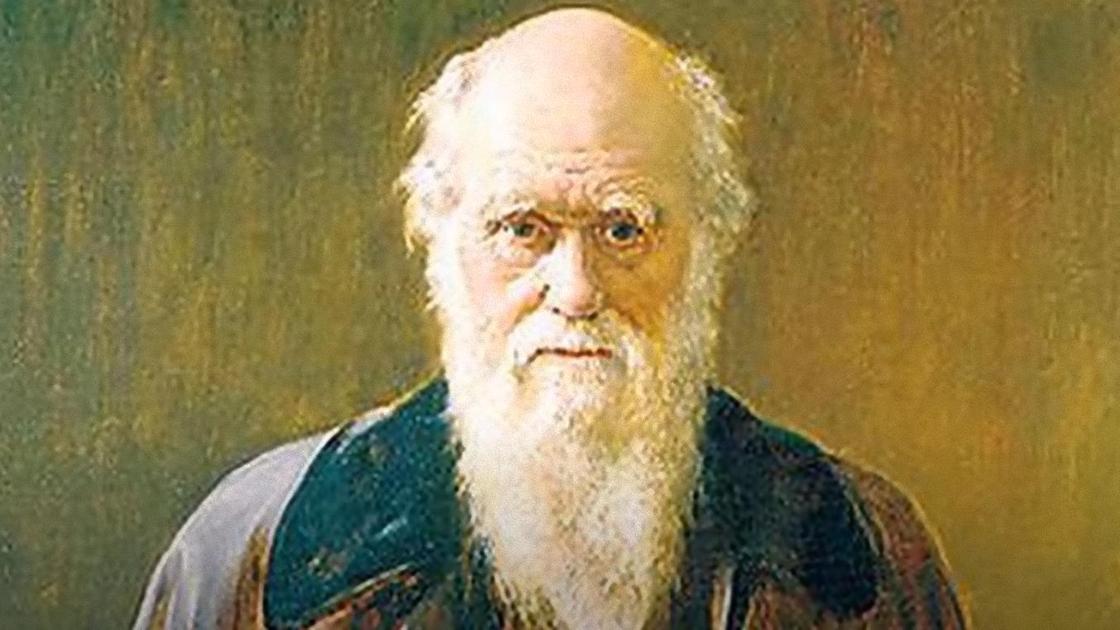
Список знаменитых ученых в области естествознания по праву возглавляет Чарльз Дарвин, биография которого переполнена интересными событиями и сенсационными открытиями. Теория эволюции Дарвина привела к настоящему прорыву в науке, изменив взгляды на появление человека на Земле и его связь с животным миром. Познакомимся с идеями великого ученого.
Чарльз Дарвин: биография, факты из жизни
Известный английский натуралист Чарльз Дарвин прошел нелегкий путь познания, который привел его к новому объяснению происхождения человека на Земле. Не каждому ученому суждено стать первооткрывателем, но перед нашим героем стояли большие задачи. Биография Дарвина — доказательство его неординарной личности.
Любознательным и умным будущий ученый был с детства. Но достичь успехов ему удалось благодаря таланту и жизненному опыту. История его жизни такова:
Чарльз Дарвин: детские годы
Многодетная семья врача и финансиста Роберта Дарвина и Сьюзанн Уэджвуд 12 февраля 1809 года пополнилась еще одним мальчиком, которого назвали Чарльз. Наследственность у семьи была впечатляющей:
- дед по отцовской линии Эразм Дарвин был ученым-натуралистом;
- дед по материнской линии Джозайя Уэджвуд — известным художником.
Но кто такой Чарльз Дарвин, человечеству еще предстояло узнать!
Родовое имение Маунт Хаус, где росло шестеро детей, находилось в графстве Шропшир (Великобритания). Дарвин рос любознательным мальчиком. В восьмилетнем возрасте он начал ходить в школу, сразу увлекся естествоведческими науками и коллекционированием.
Но в семью пришло горе: умерла мать Сьюзанн. Отцу пришлось отправить Чарльза вместе с братом Эразмом в школу-пансионат Шрусбери.
Учителя жаловались на Чарльза, которому тяжело давались обязательные предметы. Зато он увлекался естествознанием, собирал коллекции насекомых и с удовольствием ездил на охоту.
После окончания гимназии в 1825 году будущий ученый вместе со своим братом стал студентом медицинского факультета в Эдинбургском университете. Выбор был не вполне осознанным для Чарльза, хотя он успел попрактиковаться в клинике отца.
Дарвин в молодости
Университетская жизнь закончилась для Дарвина уже на второй год учебы, когда он понял, что не хочет быть врачом. Чарльза привлекали далекие страны и неизведанный мир таинственных островов.
Роберт Дарвин не мог допустить, чтобы сын остался недоучкой, поэтому настоял на поступлении в Кембриджский университет. С 1828 года Чарльз обучается в университете:
- Занимается ботаникой и знакомится с известными натуралистами того времени.
- У молодого ученого появляется огромное желание путешествовать по миру, чтобы познать животный и растительный мир на практике.
- В 1831–1836 гг. Чарльз Дарвин устраивается натуралистом в экспедицию на британском корабле «Бигль», который отправляется в кругосветное путешествие для проведения картографических съемок.
У него была своя задача — сбор коллекции по ботанике, геологии и полное описание проведенных за животным миром наблюдений. В дальнейшем материалы исследований ученый использовал в своих научных трудах.
Страницы личной жизни
Как и многие ученые, Чарльз откладывал женитьбу на потом. Но после возвращения из кругосветного путешествия принял серьезное решение. Его избранницей стала кузина Эмма Уэджвуд.
После свадьбы в 1839-м молодая семья переехала в Лондон. Через три года Дарвин поселился с семьей в Дауне (графство Кент).
Эмма родила ему 10 детей, но трое из них умерли еще в младенческом возрасте. Остальные дети получили достойное образование и заняли высокое положение в обществе.
Как умер Дарвин?
Известный ученый прожил интересную, наполненную приключениями жизнь. Годы жизни Дарвина указаны на надгробном камне в Вестминстерском аббатстве. Он умер 19 апреля 1882 года, дожив до 73 лет.
Глубоко верующий человек, который изменил свои религиозные взгляды на научно обоснованные, упокоился с миром в лоне церкви. В ХІХ веке ученых не называли еретиками, а их научные достижения даже признавались церковью и священнослужителями.
Чарльз Дарвин: вклад в науку
Чарльз Дарвин, краткая биография которого охватывает только отдельные моменты, не раскрывает полностью феномен этого человека. Поэтому стоит изучить его основные научные идеи, которые легли в основу естественных наук:
Основные принципы теории Дарвина
Изучая флору и фауну, известный натуралист разработал эволюционную теорию развития органического мира. Чарльз Дарвин стал основоположником целого направления в естествознании, названного в современной науке дарвинизмом.
Эволюционное учение Дарвина основано на следующих тезисах:
- У живых существ на Земле никогда не было одного создателя.
- Каждый вид обеспечивает себя потомством. Так происходит рост популяции.
- Количество особей в популяции и количество популяций зависят от ресурсов.
- Чтобы выжить, живые существа приспосабливаются к изменениям, которые происходят в природе.
- Изменчивость живых существ и борьба за выживание ведут к естественному отбору.
Главное достижение Дарвина в том, что он раскрыл, как работает эволюционный механизм. Практический опыт показал, что жизненных ресурсов для развития многих видов живых организмов на Земле не хватает. Поэтому возникает борьба за существование, которая приводит к противостоянию представителей одного вида, разных видов живых существ между собой и с природной средой.
Выживает не сильнейший, а тот, кто умеет приспосабливаться к изменению условий. Благодаря естественному отбору происходят постепенные эволюционные изменения, основанные на выживании и размножении приспособленных особей.
Чарльз Дарвин: открытия
Первые научные разработки ученого увидели свет после обобщения материалов, собранных в кругосветном путешествии. Очерк назывался «Путешествие натуралиста вокруг света на корабле “Бигль”» (1839).
Планируя научную деятельность в области биологии, Дарвин сосредоточился на теории эволюции. Первое исследование о происхождении видов появилось в 1842-м. Но славу ученому принесли основательные научные труды:
- «Происхождение видов путем естественного отбора» (1859);
- «Изменение животных и растений в домашнем состоянии» (1868);
- «Происхождение человека и половой отбор» (1871);
- «Выражение эмоций у человека и животных» (1872).
Биография Чарльза Дарвина тесно связана с развитием естествознания в XIX веке. Труды великого ученого радикально изменили биологию и дали новое объяснение происхождению человека. Ученый поставил людей на один эволюционный уровень со всеми живыми существами на нашей планете. Революционные идеи Дарвина, как совместимые с религиозными взглядами, признала даже церковь.
Известный натуралист Чарльз Дарвин, биография которого связана с многими научными открытиями, всегда занимался делом, к которому лежала душа. Он пример человека с неординарными способностями, глубоким терпением и бесконечным трудолюбием.
Все теории Дарвина исходят из практических опытов, его научные гипотезы обоснованы и подтверждены фактами. Ученому удалось изменить основы естествознания в области происхождения и развития разных видов живых организмов на земле. Эволюция — это неоспоримый факт, подтвержденный современной наукой.
Оригинал статьи: https://www.nur.kz/family/school/1892810-carlz-darvin-biografia-vklad-v-nauku/
Чарльз Дарвин, биография которого связана с теорией происхождения видов – выдающийся натуралист, путешественник, биолог, изменивший взгляд многообразие живого. Автор многих произведений: «Происхождение видов», «Происхождение человека и половой отбор», «Воспоминание о развитии моего ума и характера» и других.
Краткая биография Чарльза Дарвина
Чарльз Роберт Дарвин родился 12 февраля в Англии, в графстве Шропшир в 1809 году в семье Роберта и Сюзанн. В восемь лет мальчик лишился матери, которая страдала от рака желудка, и остался на попечении отца.
Его родители происходили из знатных родов. Отец Чарльза был сыном Эразма Дарвина – британского ученого, ботаника, врача. Он состоял в Лондонском Королевском обществе, изучал труды Карла Линнея (шведского систематика). Со второй половины XVIII века работал врачом, снискал успеха на этом поприще (ему поступало предложение стать врачом при короле Георге III).
Его сын, Роберт, также стал медиком. Врачебную деятельность начал в городке Шрусбери, где и прожил всю жизнь. В возрасте 29 лет женился на Сюзанн Веджвуд, дочери художника Джозайи (владельца гончарного завода). Дед по материнской линии был известен не только в Англии, но и за ее пределами благодаря продукции своего завода, а также изучению глиняного производства.
Отец Дарвина Роберт Уоринг стал финансистом, арендовав часть домов в местных окрестностях, а затем приобретя их. Также вложился в строительство железной дороги, став держателем акции.
Детские годы
Чарльз был одним из шести детей. С детства любил природу. В 8 лет был принят в Шрюссерберскую среднюю школу, где изучал словесность, религию. Данные предметы не вызывали интереса у будущего исследователя, поэтому наставники не возлагали на него надежд.
В это время мальчик приобщился к коллекционированию, а в дальнейшем к охоте. Изучение химии не оставило Дарвина равнодушным, он с усердием постигал данную дисциплину.
Образование и воспитание
В 16 лет Чарльз поступает в Эдинбургский университет для изучения медицины. Однако последняя не нашла отклика в душе юного натуралиста, и он принялся за изучение таксономии. Спустя год Дарвин вступил в ряды студенческого общества по естественной истории. Эти годы можно считать периодом становления его, как исследователя.
Будучи ассистентом Роберта Гранта, он постигает тайны организации беспозвоночных организмов. Собранные им данные были представлены во время мартовского научного общества 1827 г. Так, Дарвин указал на существование личинок в стадии развития мшанок, изучал жизненный цикл пиявок.
Совместная работа молодого ученого с Грантом обратила Дарвина к идеям Ламарка (занимавшегося классификацией живых организмов). Также он обращался к трудам своего предшественника – деда Эразма Дарвина, создателя «Зоономии».
Посещение естественной истории со временем перестало интересовать молодого натуралиста. Два года Роберт Дарвин полагал, что его сын постигает медицину. В 1827 г. отец Чарльза узнает об обратном, что вызвало гнев с его стороны. Молодому человеку было предложено стать священником, на что он согласился и поступил в колледж Христа при Кембриджском университете.
Несмотря на это, Дарвин не оставляет своих прежних занятий, а один из кузенов увлекает его зоологией насекомых. Длительная подготовка к поступлению оказалась успешной. Юноша проучился в Кембридже до 1831 г. Там он сблизился с Джоном Генслоу – известным натуралистом, который впоследствии предложил его кандидатуру в качестве натуралиста на корабль «Бигль».
Кратко о теории Дарвина
Год открытия теории 1842, когда был написан первый вариант главного труда Дарвина. В ее основе лежит естественный отбор под влиянием окружающей среды, как ключевого фактора эволюции. Постоянно меняющиеся условия привели к формированию новых видов, отличающихся от своих предшественников максимальной приспособленностью к окружающей местности.
В своей теории автор указал на общность происхождения видов, как результат эволюции. Движущими силами эволюции служат естественный отбор, борьба за существование, наследственная изменчивость. Вследствие чего выживают наиболее совершенные особи с полезными признаками, которые они передают своему потомству.
Во время путешествия на корабле Бигль была собрана информация, легшая в основу трудов ученого. С 1837 г. он ведет журнал, где подвергает анализу домашние породы и дикие виды животных и растений, развивая идеи естественного отбора. Дарвин был знаком с трудами Лайеля, работами своего соотечественника Уоллеса. Оба ученых (Дарвин и Уоллес) придерживались одинаковых взглядов относительно теории естественного отбора.
В 1856 г. был создан окончательный вариант книги Дарвина, где в основе многообразия видов лежал естественный отбор. Основной труд – теория эволюции, отвергавшая Бога, как создателя всего живого на земле. Первая публикация «Происхождения видов» состоялась в 1859 г. и включала более тысячи экземпляров.
Интересные факты из жизни ученого
По возвращении из путешествия на корабле «Бигль», под управлением Роберта Фицроя, в 1838 г. занял пост секретаря при Лондонском королевском обществе. В январе 1839 г. женился.
Избранницей стала кузина Эмма Веджвуд. Их общение завязалось в 1826 г. во время возвращения Эммы из Парижа.
Веджвуд-старший знал о желании дочери выйти замуж за кузена, поэтому в 1831 г. по этой и другим причинам он был против плавания Чарльза. В течение следующих пяти лет его дочь отвергала предложения о замужестве, продолжая переписку с кузеном. Их свадьба состоялась в январе, спустя три года со дня прибытия ученого из экспедиции.
Молодая семья первое время жила в Лондоне, затем переехала город Даун.
Первым ребенком был Уильям, родившийся в декабре 1839 г., впоследствии стал банкиром. Спустя два года родилась Энни. Она была любимицей отца, но умерла в возрасте десяти лет от сухотки. Ее смерть подтолкнула натуралиста к изданию «Происхождения видов», несмотря на последствия со стороны религиозного мира. Всего в семье было 10 детей, трое из них умерли. После смерти Энни родился Гораций, ставший членом королевского общества (как и два его брата Джордж и Френсис). Джордж Говард был выдающимся астрономом и математиком.
Супруги придерживались разных взглядов относительно Бога: Дарвин был англиканином, Эмма Дарвин унитаристкой. Мужа она считала агностиком (так он сам себя называл), не могла примириться с его взглядами долгое время.
Дарвин умер в 73 года. Похоронен в Вестминстерском аббатстве. Его жена скончалась на 88 году жизни, ее могила расположена рядом с Эразмом Дарвином (братом ученого).
Несмотря на высказывания, что Дарвин покаялся перед смертью и отказался от теории, его дети это отрицают.
За свои достижения ученый был удостоен медалей.
Также в Австралии есть город Дарвин, названный в честь ученого. Его имя присвоили кратеру на Марсе. Чарльз Дарвин входит в число 100 величайших англичан в истории.
Заключение
Чарльз Дарвин внес вклад в развитие биологии, как основоположник учения об эволюционном происхождении видов. Основная заслуга ученого – открытие механизмов эволюции. Согласно Дарвину, вся деятельность человека – результат естественного отбора.
Чарлз Роберт Дарвин (Charles Robert Darwin) родился 12 февраля 1809 года в небольшом городке Шрусбери в графстве Шропшир (Англия) в дворянской семье.
Был пятым из шести детей успешного врача Роберта Уоринга Дарвина.
Внук Эразма Дарвина (1731-1802) — английского врача, натуралиста, поэта, сторонника натурфилософского учения об эволюции организмов.
В школе Дарвин увлекался естественными науками, занимался собиранием насекомых и растений.
В октябре 1825 года он поступил на медицинский факультет Эдинбургского университета, однако через два года оставил учебу, так как не мог переносить вида крови.
В 1831 году с успехом окончил богословский факультет Колледжа Христа Кембриджского университета.
В 1831-1836 годах по предложению одного из своих университетских наставников — профессора ботаники Джона Стивенса Генслоу в качестве бортового натуралиста совершил кругосветное путешествие на корабле «Бигль», во время которого сделал огромное количество наблюдений по зоологии, ботанике, геологии, палеонтологии, антропологии и этнографии.
В ходе экспедиции Дарвин совершил несколько важных открытий, касающихся геологии Южной Америки, происхождения вулканических островов и коралловых рифов, обнаружил целый ряд незнакомых в то время науке ископаемых существ.
В ноябре 1836 года, после возвращения из экспедиции, он был принят в Лондонское геологическое общество, в 1838-1841 годах являлся его секретарем.
В 1839 году по результатам экспедиции Дарвин опубликовал «Дневник изысканий», где впервые описал многих южноамериканских и островных животных, в особенности грызунов, хищных птиц, галапагосских ящериц, черепах, вьюрков и др. В 1845 году вышло второе, расширенное издание путевых заметок ученого.
В 1840-е годы он опубликовал три крупные работы по геологии: «Строение и распределение коралловых рифов» (1842), «Геологические наблюдения над вулканическими островами» (1844) и «Геологические наблюдения над Южной Америкой» (1846).
Особое значение имели разработанная им теория происхождения коралловых рифов и подготовленный под его редакцией пятитомный труд «Зоология» (1839-1843).
В 1851-1854 годы ученый работал над монографией «Усоногие раки».
В ноябре 1859 года вышел в свет основной труд Дарвина — «Происхождение видов путем естественного отбора, или Сохранение благоприятствуемых пород в борьбе за жизнь» (On The Origin of Species by Means of Natural Selection, or The Preservation of Favoured Races in the Struggle for Life Origin of Species). Издание имело большой успех, большинство экземпляров монографии было раскуплено в первый же день.
Ученый долго работал над своей главной научной концепцией: первый набросок теории эволюции был сделан Дарвином в дневниковых записях еще в 1842 году, первые сообщения в научном сообществе и в печати появились в 1858 году.
В своем труде ученый показал, что виды растений и животных не постоянны, а изменчивы, и существующие ныне виды произошли естественным путем от существовавших ранее, изменяясь путем естественного отбора полезных для организма ненаправленных изменений.
В 1868 году ученый опубликовал второй капитальный труд — «Изменение домашних животных и культурных растений», который явился дополнением к основной монографии, и куда вошли наглядные фактические доказательства эволюции органических форм.
В 1871 году появился третий большой труд по теории эволюции — «Происхождение человека и половой отбор», где рассматривались многочисленные доказательства животного происхождения человека. Дополнением к нему стала книга «Выражение эмоций у человека и животных» (1872).
Чарлзу Дарвину также принадлежит ряд важных работ по ботанике, почвоведению и др. Его последним трудом стала книга «Формирование плодородной почвы посредством деятельности червей» (The formation of vegetable mould through the action of worms) (1881).
Научные труды Чарльза Дарвина были отмечены целым рядом почетных наград ученых сообществ. В 1859 году за труды по геологии Южной Америки он получил медаль Лондонского геологического общества. В 1864 году был награжден высшей наградой Лондонского Королевского общества — медалью Копли. В 1867 году получил прусский орден Pour le mérite.
Являлся почетным доктором Боннского, Бреславльского, Лейденского, Кембриджского университетов, членом Петербургской (1867), Берлинской (1878) и Парижской (1878) академий.
Чарлз Дарвин умер 19 апреля 1882 года в своем поместье в местечке Даун в графстве Кент, по настоянию общественности был похоронен в Вестминстерском аббатстве.
После его смерти личные документы ученого были переданы в библиотеку Кембриджского университета.
По данным опроса вещательной компании Би-би-си, проведенного в 2002 году, Чарлз Дарвин занял четвертое место в списке «Ста величайших британцев в истории», набрав более 112 тысяч голосов.
С 1839 года Чарлз Дарвин был женат на своей кузине Эмме Веджвуд (1808-1896). У супругов было десять детей, трое из них — Энн Элизабет, Мэри Элеонор и Чарлз Уоринг — умерли в детстве, что сильно повлияло на религиозные взгляды ученого. Старший сын Уильям Эразм Дарвин (1839-1914) стал успешным банкиром, владельцем корпорации Grant and Maddison’s Union Banking Co. Сыновья Джордж Ховард Дарвин (1845-1912), Фрэнсис Дарвин (1848-1925) и Леонард Дарвин (1850-1943) избрали научную стезю. Гораций Дарвин (1851-1928) стал основателем компании Cambridge Scientific Products, в 1896-1897 годах был мэром Кембриджа.
Материал подготовлен на основе информации открытых источников
Биография
Чарльз Рооберт Дарвин – натуралист, пионер теории о происхождении живого на Земле от общего предка, путем эволюции каждого вида. Автор книги «Происхождение видов», теории о происхождении человека, понятий естественного и полового отбора, первого этологического исследования «Выражение эмоций у человека и животных», теории о причинах эволюции.
Чарльз Дарвин родился 12 февраля 1809 года в графстве Шропшир (Англия) в имении Дарвинов Маунт Хаус, в Шрусбери. Роберт Дарвин, отец мальчика, врач и финансист, сын ученого натуралиста Эразма Дарвина. Мать Сьюзанн Дарвин, в девичестве – Уэджвуд, дочь художника Джозайи Уэджвуда. В семье Дарвинов росло шестеро детей. Семья посещала Унитарианскую церковь, однако мать Чарльза до замужества – прихожанка англиканской церкви.
В 1817 году Чарльза отдали в школу. Восьмилетний Дарвин познакомился с естествознанием и сделал первые шаги в коллекционировании. Летом 1817 года умерла мать мальчика. Отец отдал сыновей Чарльза и Эразма в 1818 году в пансион при англиканской церкви – «Школу Шрюсбери».
Чарльз не делал успехов в учебе. Тяжело давались языки и литература. Главная страсть мальчика – собирание коллекций и охота. Нравоучения отца и преподавателей не заставили Чарльза взяться за ум, и в конечном итоге на него махнули рукой. Позже у юного Дарвина появилось еще одно увлечение – химия, за что Дарвину даже сделал выговор начальник гимназии. Гимназию Чарльз Дарвин закончил с далеко не блестящими результатами.
После окончания гимназии в 1825 году Чарльз вместе с братом Эразмом поступил в Эдинбургский университет, на факультет медицины. Перед поступлением молодой человек поработал ассистентом в медицинской практике отца.
В университете Эдинбурга Дарвин проучился два года. За это время будущий ученый понял, что медицина – не его призвание. Студент перестал ходить на лекции и увлекся изготовлением чучел животных. Учителем Чарльза в этом деле был освобожденный раб Джон Эдмонстоун, побывавший в путешествии по Амазонии в группе естествоиспытателя Чарльза Уотертона.
Первые открытия Дарвин сделал в области анатомии морских беспозвоночных. Работы молодой ученый представил в марте 1827 года на заседании Плиниевского студенческого общества, членом которого являлся с 1826 года. В этом же обществе молодой Дарвин познакомился с материализмом. В это время он работал ассистентом у Роберта Эдмонда Гранта. Посещал курс естественной истории Роберта Джемсона, где получил базовые знания в геологии, работал с коллекциями, принадлежащими музею Эдинбургского университета.
Новость о запущенной учебе сына не привела Дарвина-старшего в восторг. Поняв, что врачом Чарльзу не стать, Роберт Дарвин настоял на поступлении сына в колледж Христа Кембриджского университета. Хотя посещения Плиниевского общества сильно пошатнули веру Дарвина в догматы церкви, он противиться воли отца не стал и в 1828 году выдержал вступительные экзамены в Кембридж.
Учеба в Кембридже не слишком увлекала Дарвина. Время студента занимала охота и верховая езда. Появилось новое увлечение – энтомология. Чарльз вошел в круг коллекционеров насекомых. Будущий ученый подружился с профессором Кембриджа Джоном Стивенсом Генслоу, открывшим студенту дверь в удивительный мир ботаники. Генслоу познакомил Дарвина с ведущими естествоиспытателями того времени.
С приближением выпускных экзаменов Дарвин начал форсировать упущенный материал по основным предметам. Занял 10-е место по итогам результатов экзаменов выпуска.
Путешествия
После окончания учебы в 1831 году Чарльз Дарвин еще какое-то время оставался в Кембридже. Он посвятил время изучению работ Уильяма Пэйли «Естественная Теология» и Александра фон Гумбольдта («Личное повествование»). Эти книги навели Дарвина на мысль о путешествии в тропики для изучения естественных наук на практике. Для осуществления идеи путешествия Чарльз прошел курс геологии Адама Седжвика, а затем уехал с преподобным в Северный Уэльс для картографирования пород.
По приезду из Уэльса Дарвина ждало письмо профессора Генслоу с рекомендацией капитану экспедиционного корабля Английского Королевского флота «Бигль» Роберту Фицрою. Корабль в то время отправлялся в путешествие в Южную Америку, и Дарвин мог занять в команде место натуралиста. Правда, должность не оплачивалась. Отец Чарльза категорически возражал против поездки, и только слово «за» дяди Чарльза, Джозайи Веджвуда II, спасло ситуацию. Молодой натуралист отправился в кругосветное путешествие.
Путешествие началось в 1831 году, а закончилось 2 октября 1836 года. Экипаж «Бигля» вел работы по картографической съемке побережий. Дарвин в это время занимался на берегу сбором экспонатов для коллекции по естественной истории и геологии. Вел полный отчет о своих наблюдениях. При каждом удобном случае естествоиспытатель отправлял копии записей в Кембридж. Во время путешествия Дарвин собрал обширную коллекцию животных, большая доля которой отводилась морским беспозвоночным. Описал геологическое строение ряда побережий.
Возле островов Зеленого Мыса Дарвин сделал открытие о влиянии временного промежутка на геологические изменения, применяемое им в написании трудов по геологии в дальнейшем.
В Патагонии он обнаружил окаменевшие останки древнего млекопитающего мегатерия. Присутствие рядом с ним в породе современных раковин моллюсков свидетельствовало о недавнем исчезновении вида. Открытие вызвало интерес в научных кругах Англии.
Исследование ступенчатой равнинной части Патагонии, открывающей древние пласты Земли, привело Дарвина к выводу о неверности утверждений в работе Лайеля «о постоянстве и исчезновении видов».
У берегов Чили команда «Бигля» застала землетрясение. Чарльз видел, как над уровнем моря поднимается кора Земли. В Андах он нашел раковины морских беспозвоночных, что привело ученого к догадке о возникновении барьерных рифов и атоллов вследствие тектонического движения земной коры.
На Галапагосских островах Дарвин заметил отличия местных видов животных от материковых родственников и представителей соседних островов. Объектом исследования стали галапагосские черепахи и птицы пересмешники.
В Австралии увиденные диковинные сумчатые животные и утконосы настолько отличались от животного мира других материков, что Дарвин всерьез задумался о еще одном «создателе».
С командой «Бигля» Чарльз Дарвин побывал на Кокосовых островах, Зеленом мысе, острове Тенерифе, в Бразилии, Аргентине, Уругвае, на Огненной Земле. По результатам собранной информации ученый создал труды «Дневник изысканий натуралиста» (1839), «Зоология путешествия на корабле «Бигль» (1840), «Строение и распределение коралловых рифов» (1842). Описал интересное природное явление — пенитентес (особые кристаллы льда на ледниках Анд).
После возвращения из путешествия Дарвин начал сбор подтверждений своей теории об изменении видов. Живя в глубоко религиозной среде, ученый понимал, что своей теорией подрывает принятые догмы существующего миропорядка. Он верил в Бога, как в высшую сущность, однако полностью разочаровался в христианстве. Его окончательный отход от церкви произошел после смерти дочери Энн в 1851 году. Дарвин не прекращал помогать церкви и оказывать поддержку прихожанам, однако во время посещения семьей церковной службы отправлялся гулять. Дарвин называл себя агностиком.
В 1838 году Чарльз Дарвин стал секретарем «Лондонского геологического общества». Этот пост занимал до 1841 года.
Теория происхождения видов
В 1837 году Чарльз Дарвин приступил к ведению дневника, классифицирующего сорта растений и породы домашних животных. В него же он заносил свои мысли по естественному отбору. Первые заметки о происхождении видов появились в 1842 году.
«Происхождение видов» – цепь аргументов, подтверждающих теорию эволюции. Суть учения – постепенное развитие популяций видов путем естественного отбора. Принципы, изложенные в работе, получили в научном сообществе название «дарвинизм».
В 1856 году началась подготовка расширенного варианта книги. В 1859 году свет увидели 1250 экземпляров труда «Происхождение видов путём естественного отбора, или сохранение благоприятствуемых пород в борьбе за жизнь». Книгу раскупили за два дня. При жизни Дарвина книга вышла на голландском, русском, итальянском, шведском, датском, польском, венгерском, испанском и сербском языках. Труды Дарвина переиздаются и популярны и сейчас. Теория ученого-натуралиста по-прежнему актуальна и является основой современной теории эволюции.
Еще один важный труд Дарвина – «Происхождение человека и половой отбор». В нем ученый разработал теорию об общем предке у человека и современной обезьяны. Ученый провел сравнительный анатомический анализ, сравнил эмбриологические данные, на основе чего показал сходство человека и обезьяны (симиальная теория антропогенеза).
В книге «О выражении эмоций у человека и животных» Дарвин описал человека как часть эволюционной цепочки. Человек, как живой организм, развился из низшей животной формы.
Личная жизнь
Чарльз Дарвин женился в 1839 году. К женитьбе отнесся серьезно. Прежде чем принять решение, выписал на лист бумаги все «за» и «против». После вердикта «Жениться-Жениться-Жениться» 11 ноября 1838 года сделал предложение кузине Эмме Вэджвуд. Эмма – дочь Джосайи Веджвуда II, дяди Чарльза, члена Парламента и владельца фабрики фарфора. На момент свадьбы невесте исполнилось 30 лет. До Чарльза Эмма отвергала предложения руки и сердца. Девушка вела переписку с Дарвином в годы путешествия к Южной Америке. Эмма – девушка образованная. Писала проповеди для сельской школы, обучалась музыке в Париже у Фредерика Шопена.
Бракосочетание состоялось 29 января. Венчание в Англиканской церкви провел брат жениха и невесты Джон Аллен Веджвуд. Молодожены поселились в Лондоне. 17 сентября 1842 года семья переехала в Даун графства Кент.
У Эммы и Чарльза родилось десять детей. Дети достигли высокого положения в обществе. Сыновья Джордж, Фрэнсис и Гораций были членами Английского Королевского общества.
Трое малышей умерло. Дарвин связывал болезненность детей с родственной связью между собой и Эммой (работа «Болезненности потомков от близкородственного скрещивания и преимуществах далёких скрещиваний»).
Смерть
Умер Чарльз Дарвин в возрасте 73 лет, 19 апреля 1882 года. Похоронен в Вестминстерском аббатстве.
После смерти мужа Эмма купила дом в Кембридже. Сыновья Фрэнсис и Гораций построили дома рядом. В Кембридже вдова жила зимой. На лето перебиралась в семейное имение в Кенте. Умерла 7 октября 1896 года. Похоронена в Дауне, рядом с братом Дарвина – Эразмом.
Интересные факты
- Чарльз Дарвин родился в один день с Авраамом Линкольном.
- На фото Дарвин похож на Льва Толстого.
- «Происхождение видов» стало так называться только к шестому переизданию.
- Дарвин узнавал новые виды животных и с гастрономической точки зрения: он пробовал на вкус блюда из броненосцев, страусов, агути, игуан.
- В честь ученого названо немало редких видов животных.
- Дарвин никогда не отрекался от своих убеждений: до конца дней, живя в глубоко религиозной семье, он в отношении религии был человеком сомневающимся.
- Путешествие «Бигля» растянулось вместо двух лет на пять.

